The BEST Tarangire Safari in Tanzania: 2024 Guide
Looking for the Best Tarangire Safari in Tanzania? This is the only guide you’ll need!
Tarangire National Park is by far one of the best places to take a safari in Tanzania. From the stunning landscapes to the abundance of African wildlife, you’re in for a treat!
I personally went on a private Tarangire Tanzania Safari with Altezza Travel , and it was an experience I will not soon forget.
Read on to discover everything you need to know about visiting Tarangire Tanzania.
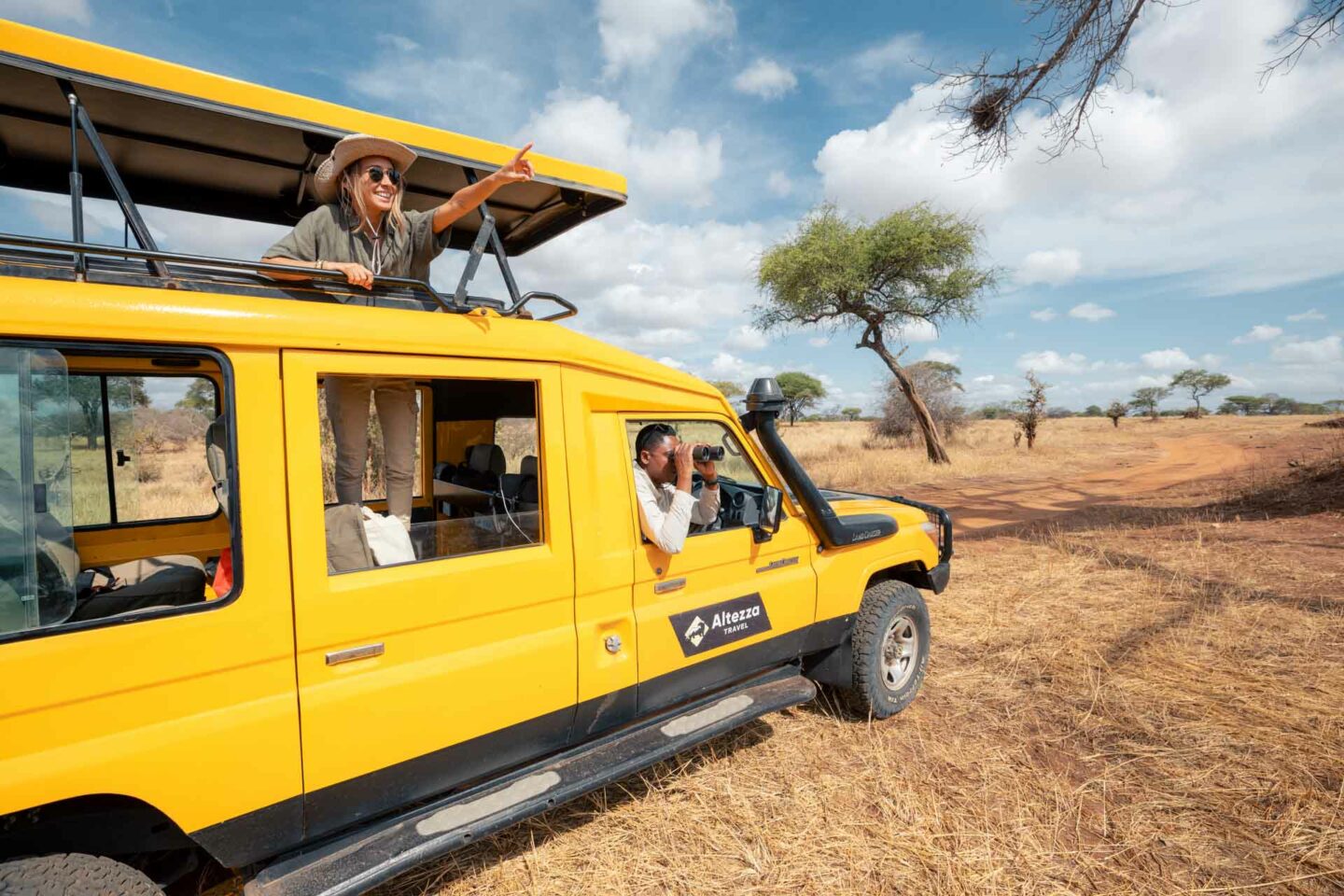
Table of Contents

QUICK ANSWERS: TARANGIRE SAFARI
Let’s start this guide with the essentials you should know, including the price of a safari Tarangire, where you can book, and more.
SAFARI TARANGIRE STATS
- Size : 2,850km² / 1,100mi²
- Altitude : 985-1,528m / 3,232-5,013ft
- Best time to visit : June to October
- Best attractions : Tarangire River, the Giant Baobab Tree, the Swamps
WHAT IS SO SPECIAL ABOUT TARANGIRE?
Tarangire National Park in Tanzania is known for its high density of elephants, diverse wildlife, and stunning baobab trees, especially the Giant Baobab Tree.
Apart from that, it’s famous for the Tarangire River which attracts loads of animals, and it’s also a birdwatcher’s paradise with over 500 species throughout the park.
CAN YOU VISIT TARANGIRE ON YOUR OWN?
Yes, you can visit Tarangire National Park on your own, as self-drive is allowed. However, I highly recommend booking with a safari company such as Altezza Travel.
They have extensive knowledge of the park and its wildlife and can take you to the best spots for animal and bird sightings.
HOW LONG DOES A SAFARI TARANGIRE TANZANIA TAKE?
Typically, a visit to Tarangire National Park is a one-day trip, providing a compact yet diverse introduction to wildlife and the landscapes.
That being said, the most popular safaris are multi-day experiences, often lasting 3 days or more. These safaris typically include multiple national parks, including Tarangire, Ngorongoro Crater, Serengeti, and Arusha National Park.
I personally did a 3-day safari in Tanzania and it was one of the most unforgettable adventures I’ve been on to date.
BEST TIME TO TAKE A TARANGIRE SAFARI?
The best time to visit Tarangire is during the dry season, which usually spans from late June to October.
You’ll get clear, sunny weather and minimal rainfall, and animals would normally gather around the Tarangire River.
It’s an excellent opportunity to witness herds of elephants, zebras, antelopes, buffaloes, and more in their natural habitat.
That being said, the wet season from November to March is best for bird-watching, as thousands of migratory birds come around.
HOW MUCH DOES A SAFARI TARANGIRE COST?
The cost of a safari in Tarangire National Park will vary depending on your itinerary.
For a budget safari, you can expect to pay around $150 per person per day. On the other hand, for a more premium experience, you will find safaris for over $1,000 per person per day.
A mid-range Safari Tarangire option falls somewhere in between at around $300 to $500 per person per day.
WHERE TO BOOK A TARANGIRE SAFARI?
I personally booked a 3-day private safari with Altezza Travel which included a day in Tarangire National Park, a day in Ngorongoro Crater, and a day in Arusha National Park.
Altezza is a premier tour operator who has extensive expertise when it comes to the service and logistics of safari tours within Tanzania’s national parks.
They have an impressive safari fleet of Land Cruisers with a convertible pop-up roof that provides a panoramic 360° view. They’re also equipped with amenities such as a fridge for your refreshments, Wi-Fi access, and power sockets.
Each safari is customizable, tailoring the ideal dream tour to align with your specific travel style and comfort preferences.
When it comes to accommodation, you’ll be presented with options that include luxurious stone-built lodges and more authentic tented lodge experiences.
All in all, your once-in-a-lifetime African adventure is in capable hands when booking with Altezza.
Special Offer: Altezza extends a 5% discount on all Tanzania Safari to all my readers when you include the code JONNYMELON during your booking inquiry.
WHAT TO EXPECT ON A TARANGIRE SAFARI
Our day began at 6 am when the tour guide picked us up at the hotel in Moshi. We arrived at Tarangire National Park around 9:30 am and were excited to start the game drive.
The safari lasted about 5 to 6 hours including a stop for lunch and we got to see an abundance of animals including lions, giraffes, elephants, zebras, cheetahs, wildebeests, and more!
My favorite area of the national park was the Tarangire River, which was the most active with many animal species to see.
We visited in October, which is the dry season, and the Tarangire River was one of the only sources of drinking water for the animals, hence why we saw so many of them.
And here’s the best part – these elephants are not shy! They are very used to visitors, often wandering close to the safari vehicles, and that was definitely one of the highlights of our trip.
It’s worth noting that no guide can guarantee that you’ll see any specific animal species, and rightfully so as it’s nature.
Also, we were not allowed to exit the vehicle, apart from the designated areas for lunch and restrooms, so do keep that in mind when booking a safari in Tarangire.
After spending some time at the lake and taking countless photos, we quickly stopped for lunch with our guide and then resumed the game driving before getting back to the hotel for the night.
SAFARI IN TARANGIRE – FAQ
Below are some answers to the most frequently asked questions from first-time visitors.
WHAT’S INCLUDED IN A TARANGIRE SAFARI?
When you book a safari in Tarangire with Altezza Travel, all the below are included:
- Hotel transfers from Moshi
- Entrance fees to Tarangire National Park
- Lunch, drinking water, and soft drinks
- Binoculars to spot the animals from afar
- Safe and modern safari vehicle with pop-up roof
WHAT TO PACK FOR A SAFARI IN TARANGIRE NATIONAL PARK?
Here is a quick overview of what to pack for a safari in Tarangire National Park;
Clothing: Comfort is key on a safari. Pack lightweight cotton clothes, long-sleeved shirts, and pants to protect against mosquitoes. I suggest packing layered clothing, as mornings and evenings can be cool while days are warm.
Footwear: Comfortable shoes like trainers are recommended.
Essentials: Don’t forget your sunscreen and hat for protection against the sun. Also, carry a day bag for your everyday essentials.
Camera Gear: A camera with extra memory cards, batteries, a power bank, and a charger will help you capture the best memories from your trip.
RELATED ARTICLE: BEST CAMERA GEAR FOR TRAVEL
IS THERE WI-FI ON THE SAFARI?
If you have a local SIM card, the mobile network is relatively consistent in Tarangire National Park.
This means that you will be able to use your mobile data for browsing the internet, posting on social media, and staying connected as a whole.
The safari vehicles are also conveniently fitted with a Wi-Fi dongle.
Some lodges inside the park offer free Wi-Fi and most hotels in cities and towns also have Wi-Fi available for guest use.
Yet, keep in mind that you’re in a remote location and the connection might not always be strong.
WHERE TO STAY IN TARANGIRE NATIONAL PARK ?
Inside the national park, there are half a dozen accommodations available and we personally stayed at the beautiful Ndovu Tented Lodge by Nasikia Camps .
They have 12 permanent tents made up of ten standard suites, and 2x two bed room inter-connected family suites.
Ndovu Tented Camp offers an enchanting setting to unwind after the day’s adventures and you’ll even be able to spot wildlife right in front of the camp.
Enjoy your meals in the thatched main area, go for a dip in the swimming pool, and enjoy a sundowner while sitting around the campfire.
FINAL THOUGHTS – SAFARI TARANGIRE
Thank you for reading until the end, and I hope you have a better understanding of what to expect when visiting Tarangire Tanzania.
If you have any questions, please leave a comment below this post, and I will get back to you as soon as I can.
For a quicker response, be sure to join Jonny Melon’s Travel Tribe on Facebook and post your questions or recommendations to our awesome community.
TRAVEL RESOURCES FOR YOUR NEXT TRIP
Whether you’re a seasoned traveler or it’s your first trip overseas, here are some useful travel resources to help you kick-start your next adventure!
Search and book accommodation worldwide.
Compare and book cheap flights to anywhere.
Find tickets, tours, and experiences around the world.
Book buses, trains, and transfers online in advance.
Search all rental cars in your next destination.
Need travel insurance for your next trip?
THANKS FOR READING
Hey friend, thanks for reading this guide!
Please know this post may contain affiliate links. When making a purchase through one of my links, I earn a small kickback at no extra cost to you and it’s a big help to keep the site up and running. Rest assured, I only promote products and services that I personally use and recommend.
Click here to find out how you can support the site organically .
Many thanks!
Leave a comment Cancel reply
Notify me of follow-up comments via e-mail.
Plan Your Trip
Travel Guides
Destinations
Hotel Guides
Find Best Tours
Travel Gear
Travel Resources
How To Start A Blog
Photography Guides
Support the site
Follow On Socials
© 2024 Jonny Melon Adventure Travel Blog. All rights reserved.
Privacy Policy | Terms | Sitemap

Ultimate Kilimanjaro
The #1 Guide Service for Climbing Kilimanjaro

The 7 Most Important Gear Items for Climbing Kilimanjaro

The Seven Summits – Highest Mountain on Each Continent

Why is Kilimanjaro Famous?

15 Amazing Sights to See While Climbing Kilimanjaro

How Hard is it to Climb Kilimanjaro?

Kilimanjaro Map & Climbing Route Selection

Should I use Supplemental Oxygen on Kilimanjaro?

Can an Unfit Person Climb Mount Kilimanjaro?

The 10 Biggest Misconceptions About Climbing Kilimanjaro

5 Medications that Help Acclimatization & Combat Altitude Sickness

Kilimanjaro Success Rates by Route

10 Reasons You Should NOT Climb Kilimanjaro

How Tall is Mount Kilimanjaro? The True Height

What are the Most Dangerous Routes on Kilimanjaro?

8 Ways to Prevent Injuries on Mount Kilimanjaro

Common Objections to Climbing Kilimanjaro (& How to Overcome Them)

The Oldest and Youngest Person to Climb Kilimanjaro (World Records)

The Woman’s Guide to Climbing Kilimanjaro

What is the Best Down Jacket for Climbing Kilimanjaro?

7 Things They Don’t Tell You About Climbing Kilimanjaro

What Celebrities Have Climbed Kilimanjaro?

Kilimanjaro Meaning – How Did Kilimanjaro Get Its Name?

2024 Ultimate Kilimanjaro Gear List Recommendations

What is the Best Rain Jacket for Climbing Kilimanjaro?

What Should I Wear to Climb Kilimanjaro?

Ultimate Kilimanjaro Guides 89 Year Old on Kilimanjaro For New World Record

The Beginner’s Guide to Climbing Kilimanjaro

Is Mount Kilimanjaro Too Crowded?

12 Interesting Facts About Mount Kilimanjaro

10 Reasons to go on a Tanzanian Safari

Are All Kilimanjaro Crews Treated Fairly?

7 Myths About Altitude (That You Probably Think are True)

12 Things You Need to Know Before Going on a Tanzanian Safari

Is Climbing Kilimanjaro Really Dangerous? Kilimanjaro Deaths

12 Things You Need to Know Before Climbing Kilimanjaro

10 Places for the Best Photographs on Mount Kilimanjaro

Kilimanjaro Difficulty: Is It Getting Easier?

Why People Fail When Climbing Kilimanjaro

Why Do Climbers Summit Kilimanjaro at Night?

Is it Worth it to Climb Kilimanjaro?

10 Tips for a Successful Climb on Mount Kilimanjaro

7 Hard Truths About Climbing Kilimanjaro (That You Need to Know)

Will Mount Kilimanjaro Erupt Again?

Climbing Kilimanjaro is Easy (Not Hard)

11 Ways to Boost Your Hiking Endurance for Climbing Kilimanjaro

Ultimate Kilimanjaro® – Why We’re Different

How to Stay Warm on the Summit of Kilimanjaro

3 Important Jackets You Need for Climbing Kilimanjaro

5 Simple Ways to Avoid the Crowds While Climbing Kilimanjaro

Can I Climb Kilimanjaro as a Complete Novice?
Tarangire national park: everything you need to know.
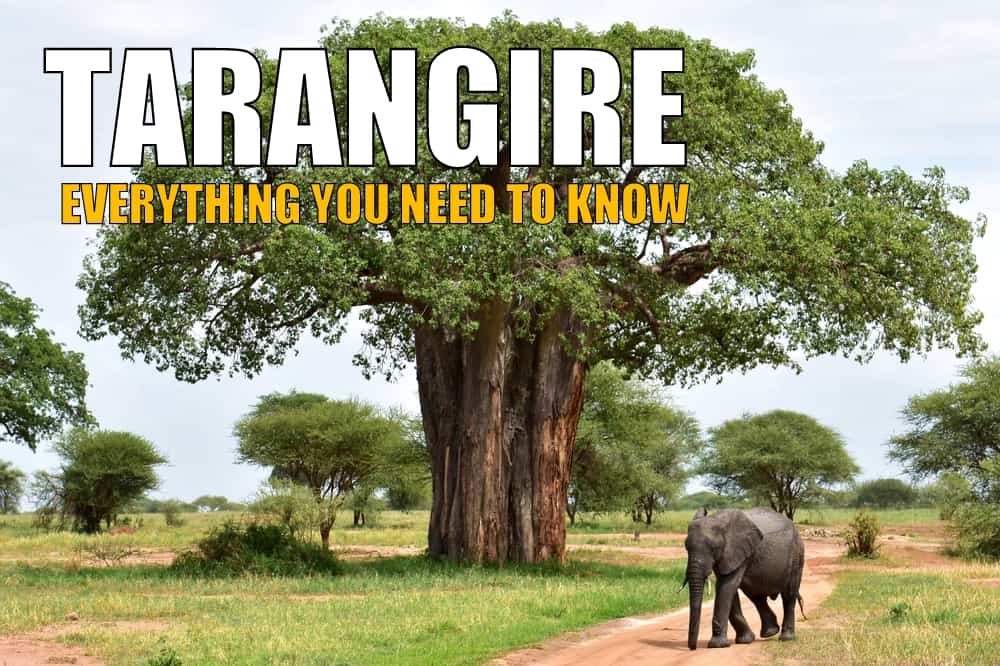
In the shadow of its more famous siblings, the Serengeti and the Ngorongoro Crater , Tarangire National Park in Tanzania is a hidden gem. This park is a sanctuary of untamed wilderness. It offers our clients a safari experience steeped in serenity and abundant wildlife.
How Do You Pronounce Tarangire?
Tarangire is pronounced ‘Tair-an-GEER-ee.’
Where is Tarangire Located?
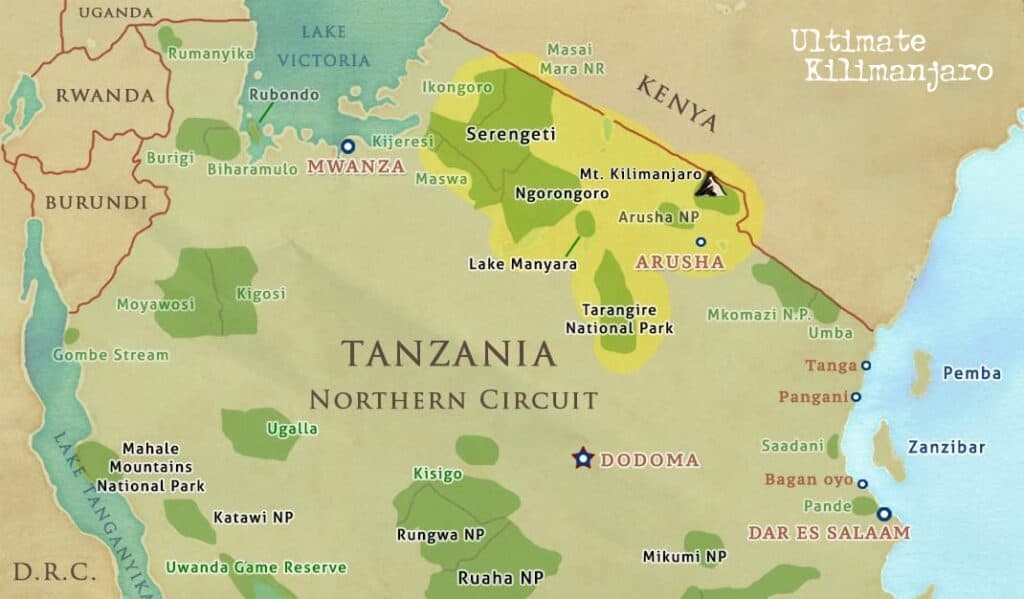
Tarangire is located in northern Tanzania . It is part of the country’s northern safari circuit which also includes Lake Manyara, Ngorongoro, and the Serengeti.
Tarangire is approximately 70 miles (110 km) from Lake Manyara National Park, 90 miles (140 km) from Ngorongoro Conservation Area, and 120 miles (200 km) from Serengeti National Park. It is located about 130 miles (210 km) from Kilimanjaro International Airport ,
When was Tarangire National Park Created?
Tarangire National Park was established in 1970 to preserve its unique ecosystem and biodiversity.
What Does Tarangire Mean?
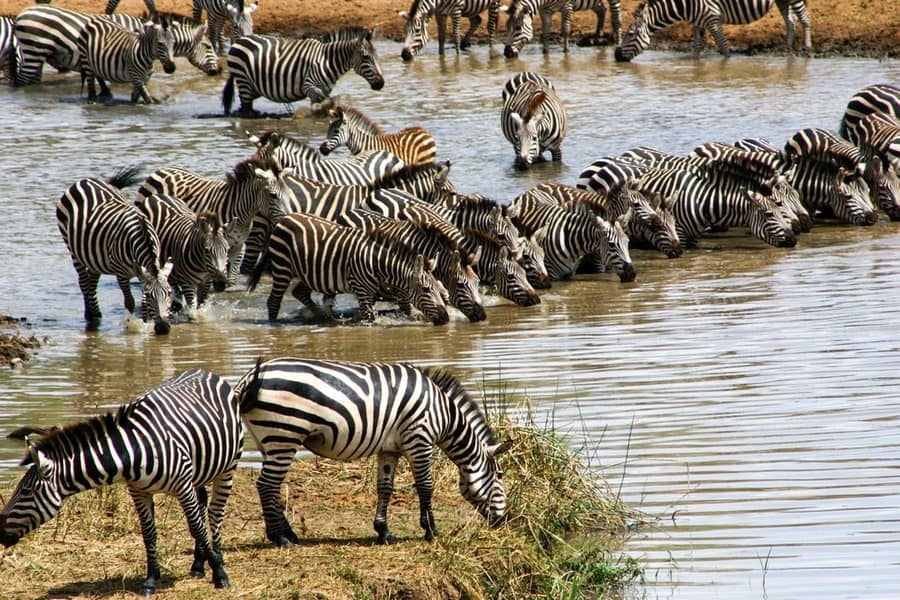
The park’s name is derived from the Tarangire River that flows through the park. This river is the primary source of water for the wildlife in the region. It is a vital lifeline for the ecosystem during the dry season.
The word Tarangire has a few possible origins. It might stem from the Maasai word ‘tara ngare,’ meaning “spotted water,” in reference to the river that never dries. It could also be derived from a Wambugwe word meaning “meandering.” Finally, Tarangire could mean “river of warthogs ,” from the combination of two words – ‘tara’ (“river” in the Mbugwe language) and ‘ngire’ (“warthog” in the Hadzabe language).
How Big is Tarangire National Park?
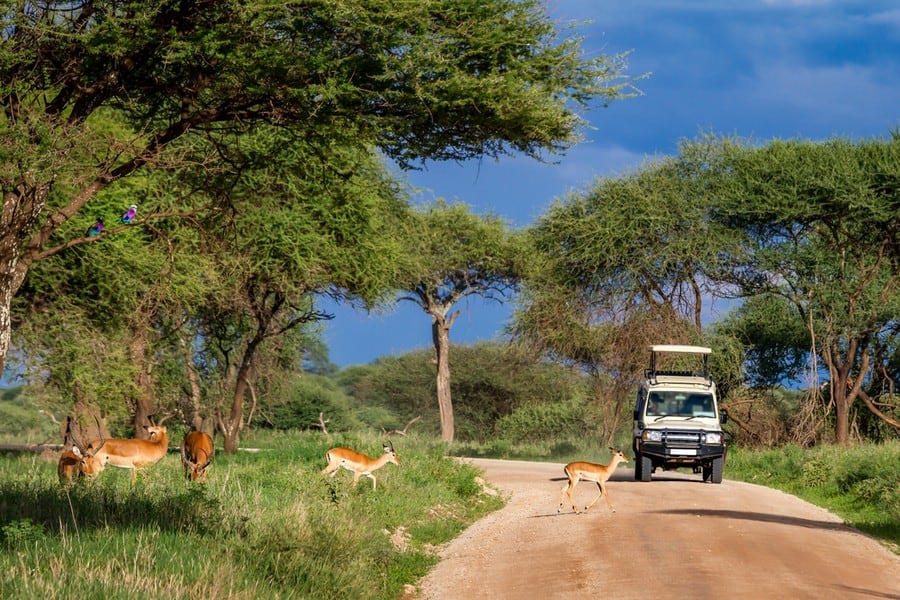
Tarangire National Park spans an area of approximately 1,100 square miles (2,850 square kilometers). It is Tanzania’s fifth-largest national park , nicknamed the “little Serengeti.”
To put its size into perspective, it’s about half the size of Delaware in the USA or slightly larger than London in the United Kingdom.
Why is Tarangire National Park Famous?
Tarangire National Park is famous for several unique features that distinguish it from other parks in the region:
Large Elephant Population: Tarangire is renowned for hosting one of the largest elephant populations in Tanzania. During the dry season, herds of up to 300 elephants can be seen congregating around the Tarangire River and other water sources, offering exceptional opportunities for elephant watching.
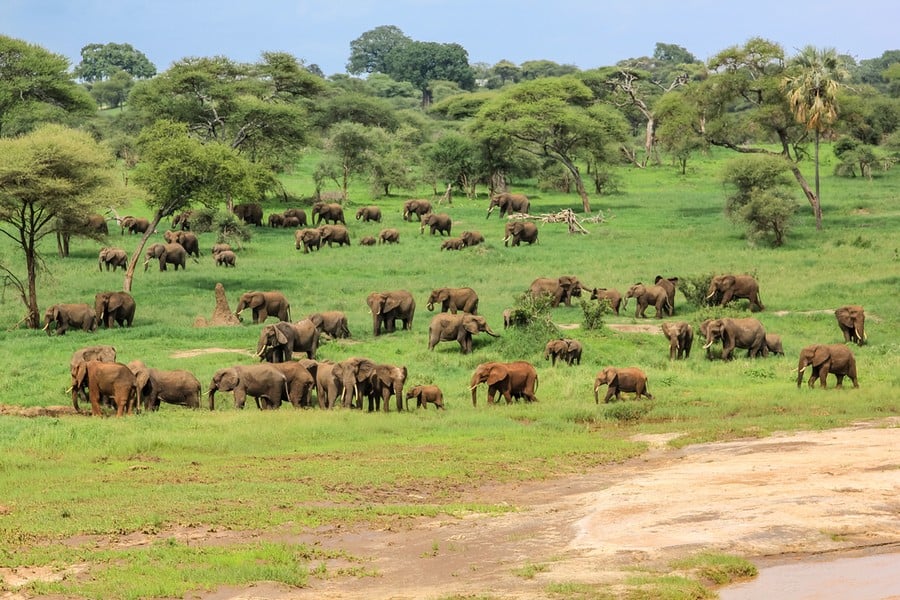
Baobab Trees: The park is dotted with ancient baobab trees. These trees, often referred to as the “upside-down trees” because of their root-like branches, are iconic symbols of the African landscape.
Tarangire River: The Tarangire River is the primary source of fresh water for wildlife in the region. The river attracts a high concentration of animals, which in turn draw predators.
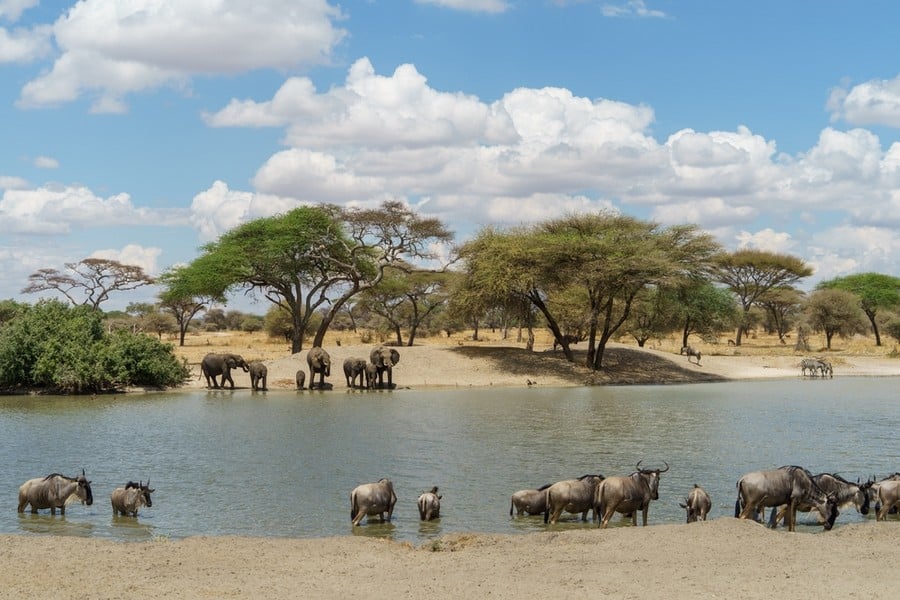
Seasonal Wetland: During the wet season, parts of the park transform into a lush, green landscape, attracting migratory animals and supporting a variety of breeding activities, especially for birds .
Less Crowded: Compared to its more famous neighbors like the Serengeti and Ngorongoro Crater, Tarangire National Park tends to be less crowded, offering a more serene and exclusive wildlife viewing experience.
How was Tarangire Formed?
The formation of Tarangire National Park, like much of Tanzania’s landscape, is a story that intertwines geology, climate, and biology over millions of years.
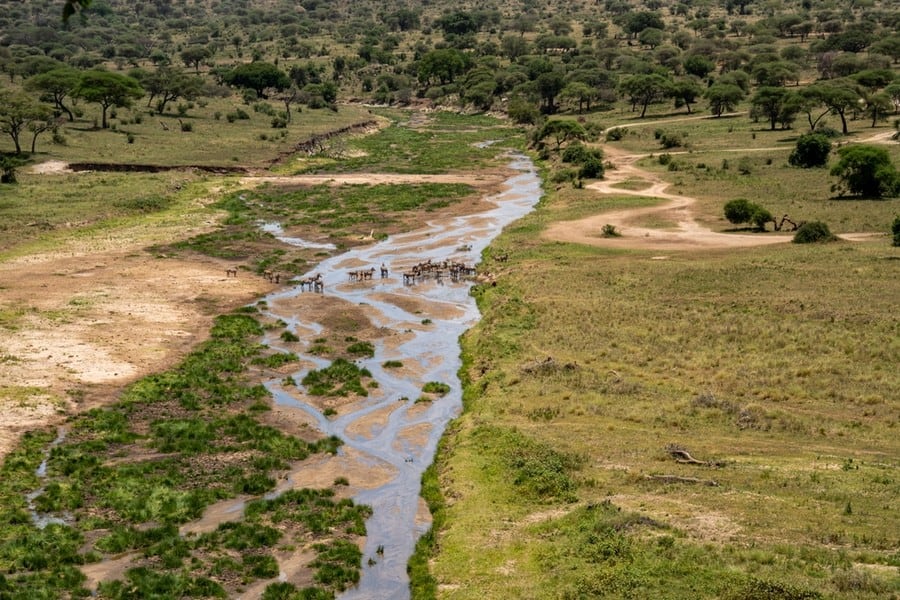
The East African Rift is a tectonic plate boundary that is slowly splitting the African Plate into two. This movement has played a pivotal role in shaping the region. The rifting process has led to the creation of many of Tanzania’s geographical features, including its valleys and escarpments.
While the park itself is not characterized by volcanic landscapes like some of its northern neighbors (e.g., Ngorongoro Crater), past volcanic activity has influenced its soil composition and topography. The volcanic ash and debris, carried by the winds over time, have contributed to the fertile soils found in parts of the park, supporting its lush vegetation.
The Tarangire River has carved its way through the landscape, creating varied habitats along its banks. The climate has further impacted the vegetation patterns and animal behavior in the park. The distinct wet and dry seasons have led to the development of diverse ecosystems ranging from grassy savannahs to swampy areas and dense woodlands.
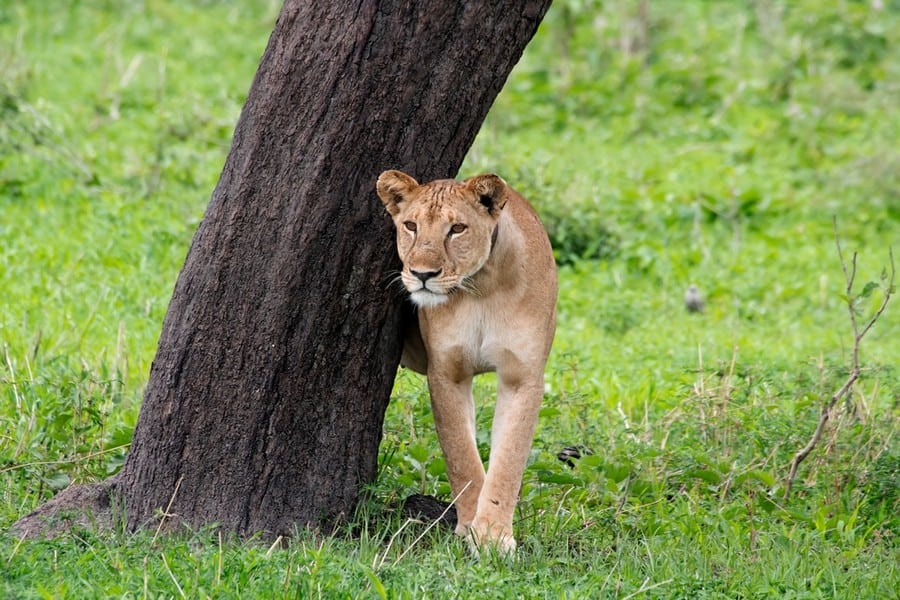
Over time, the flora and fauna in the Tarangire area have evolved to adapt to these environmental conditions. The park’s famous baobab trees, for example, are well adapted to the dry climate, able to store large quantities of water in their trunks. Similarly, the wildlife, particularly the large elephant population, has adapted to the seasonal availability of water and food.
What Animals Live in Tarangire National Park?
Tarangire National Park has a variety of habitats, including grassy savannahs, swamps, and woodlands . These provide an ideal environment for many species, making the park a microcosm of East African wildlife diversity.
Some of the animals that live in the Tarangire inlcude:
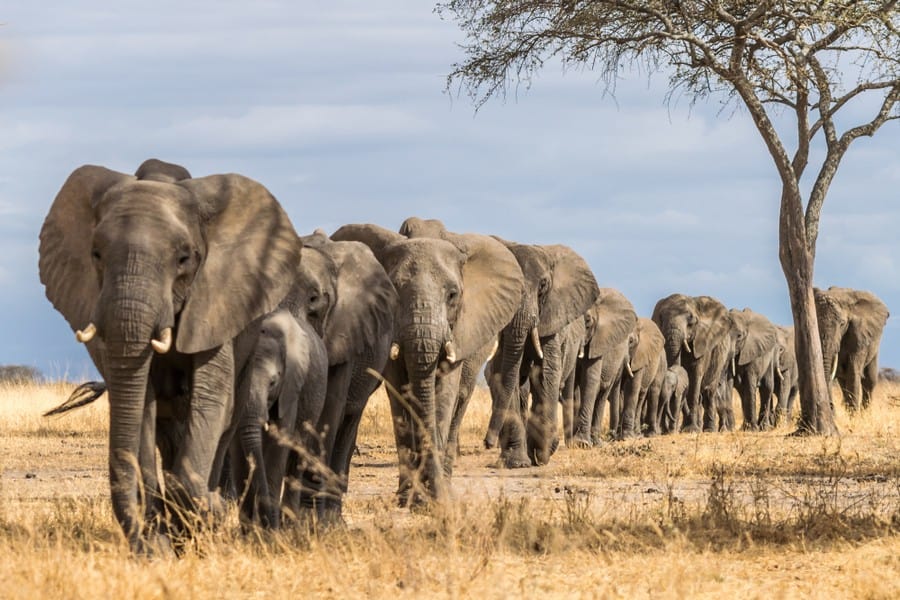
- Elephants: Tarangire is famous for its large herds of elephants. These gentle giants are often seen wandering through the park, especially near the Tarangire River.
- Buffalo : These sturdy animals are a common sight, often found grazing in the grasslands or cooling off in the park’s swamps.
- Lions: As top predators, lions are present in Tarangire, though they can sometimes be elusive due to the park’s dense vegetation.
- Leopards : These solitary and nocturnal cats are more challenging to spot but are residents of the park, often seen lounging in trees.
- Cheetahs: While not as numerous as in some other parks, cheetahs can be spotted in Tarangire, particularly in the open areas where they hunt.
- Zebras: Herds of zebras are a common sight, their distinctive stripes making them an iconic symbol of African wildlife.
- Wildebeest : These animals are also prevalent in the park, often seen grazing alongside zebras.
- Giraffes : Tarangire’s landscape is dotted with these elegant creatures, browsing on the tops of trees.
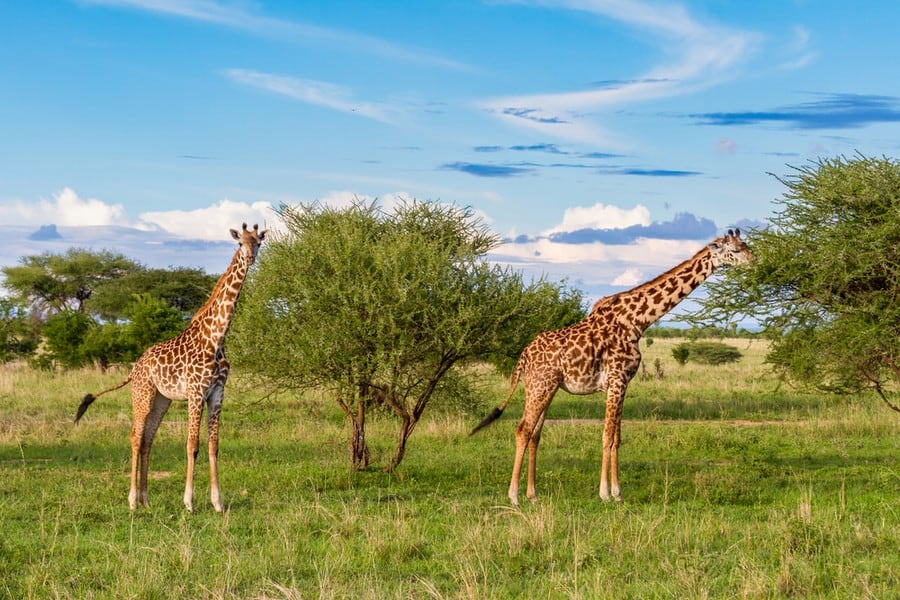
- Impalas: These graceful antelopes are widespread throughout the park.
- Waterbucks: Often found near water sources, waterbucks are a larger species of antelope.
- Dik-diks: These small, shy antelopes are also residents of Tarangire.
- Warthogs: These distinctive animals, with their protruding tusks, are commonly seen in the park.
- Baboons and Vervet Monkeys: These primates are often spotted in Tarangire, particularly in wooded areas and near water sources.
- Mongoose: Several species of mongoose can be found, often seen foraging in small groups.
- Hyenas: Spotted hyenas are present, playing their role as scavengers and hunters.
- Birdlife: Tarangire is a paradise for birdwatchers, with over 500 species recorded. This includes raptors, waterbirds, and colorful passerines.
- Python: The African python, one of the largest snake species, can occasionally be seen, particularly in the park’s trees.
- Lesser Kudu: This elusive and beautifully striped antelope is a special sighting in Tarangire.
- Oryx: The striking East African oryx makes occasional appearances in the park.
- Hartebeest: These large antelopes are also part of Tarangire’s diverse wildlife.
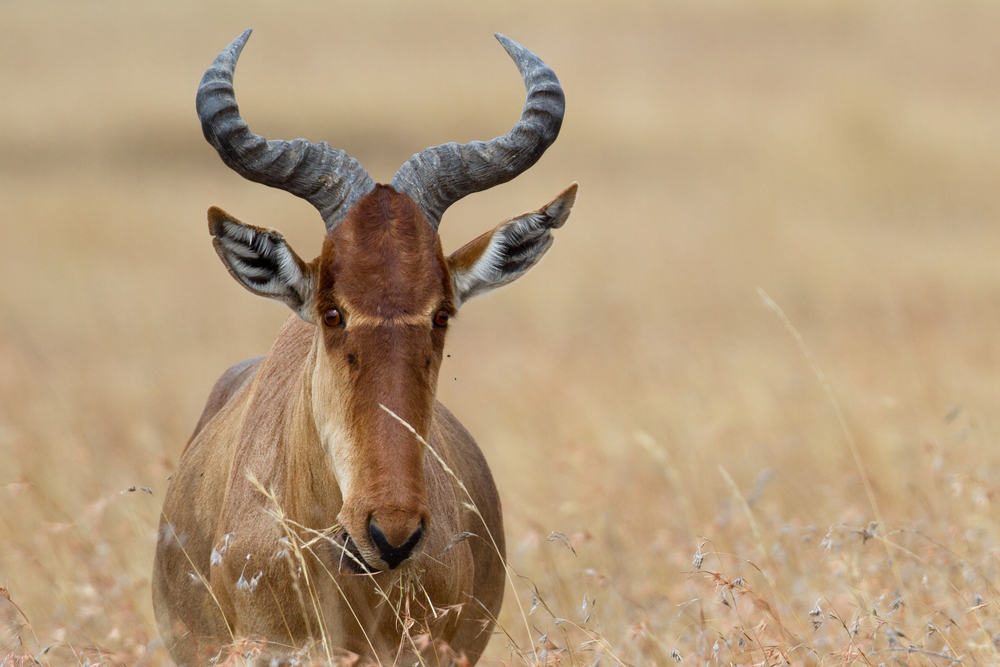
What is the Weather in Tarangire National Park?
Tarangire National Park experiences a climate that is generally semi-arid, characterized by distinct wet and dry seasons.
Dry Season (June to October)
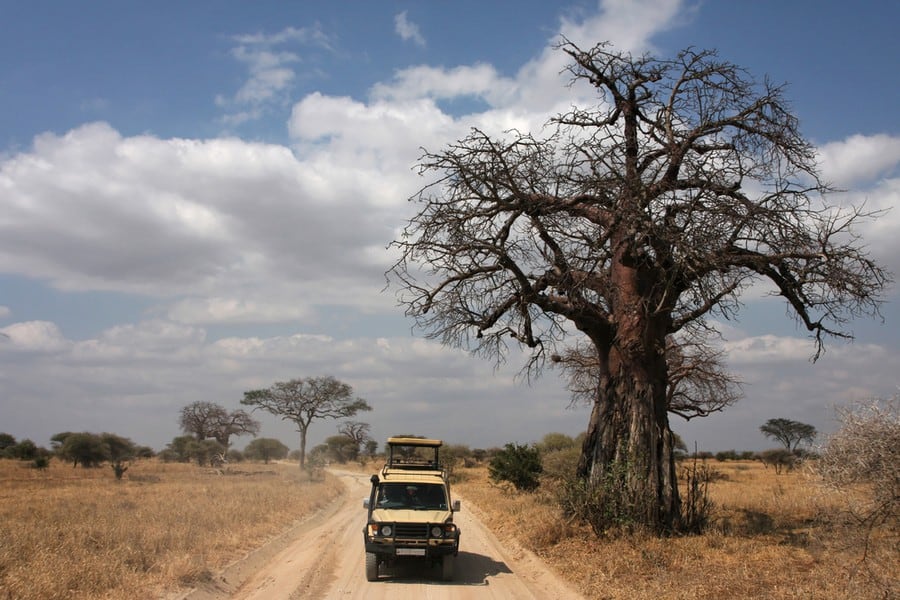
- Climate: This period is marked by dry weather with little to no rainfall. The days are typically sunny and warm.
- Temperatures: Daytime temperatures are comfortably warm, ranging from 75°F to 85°F (24°C to 29°C). However, during the peak of the day, temperatures can rise, occasionally reaching up to around 90°F (32°C). Nighttime temperatures can be cooler, particularly in the early and late dry season, ranging from 55°F to 60°F (13°C to 16°C), with June and July often being the coolest months.
- Wildlife: The dry season sees the park’s vegetation thinning out, and water sources become scarce. This scarcity draws animals to the Tarangire River and other remaining waterholes, making it an excellent time for wildlife viewing. Elephants, in particular, are more visible as they congregate around these water sources.
Wet Season (November to May)
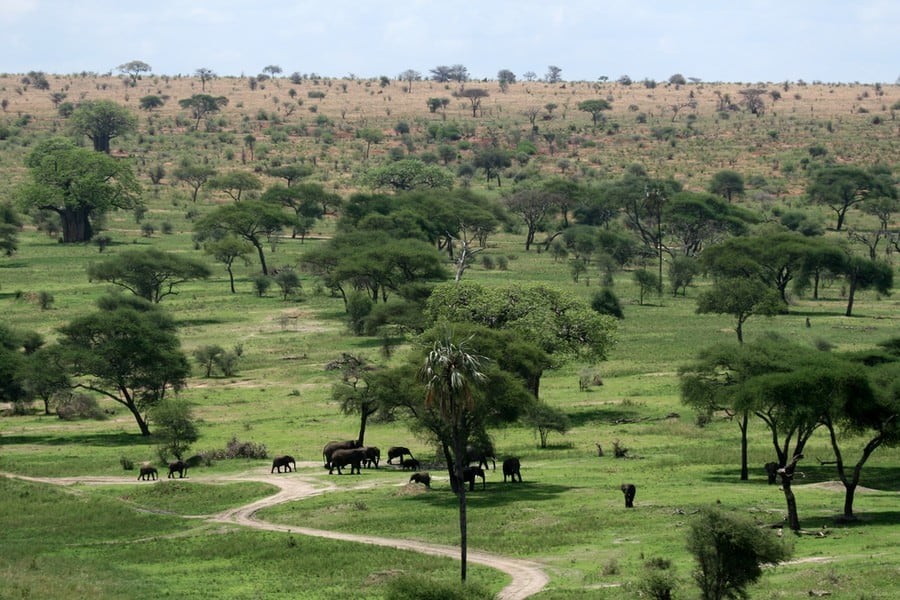
- Climate: The wet season is characterized by two phases – the ‘short rains’ from November to December and the ‘long rains’ from March to May.
- Temperatures: Daytime temperatures during the wet season are milder, typically ranging from 70°F to 80°F (21°C to 27°C). The cloud cover and rain help moderate the temperatures. Nighttime temperatures are a bit warmer than in the dry season, generally between 60°F and 65°F (16°C to 18°C), due to increased cloud cover.
- Wildlife: The park transforms into a lush, green landscape. This period is great for bird watching as migratory birds arrive, and the park’s resident bird species are in breeding plumage. While wildlife viewing is still possible, animals may be harder to spot due to the thicker vegetation.
When is the Best Time to Visit Tarangire National Park?
The best time to go may depend on what you wish to see and experience. Generally speaking, the optimal time to visit Tarangire is during the dry season when wildlife viewing is at its peak . However, the park is a year-round destination, with each season offering a unique experience.
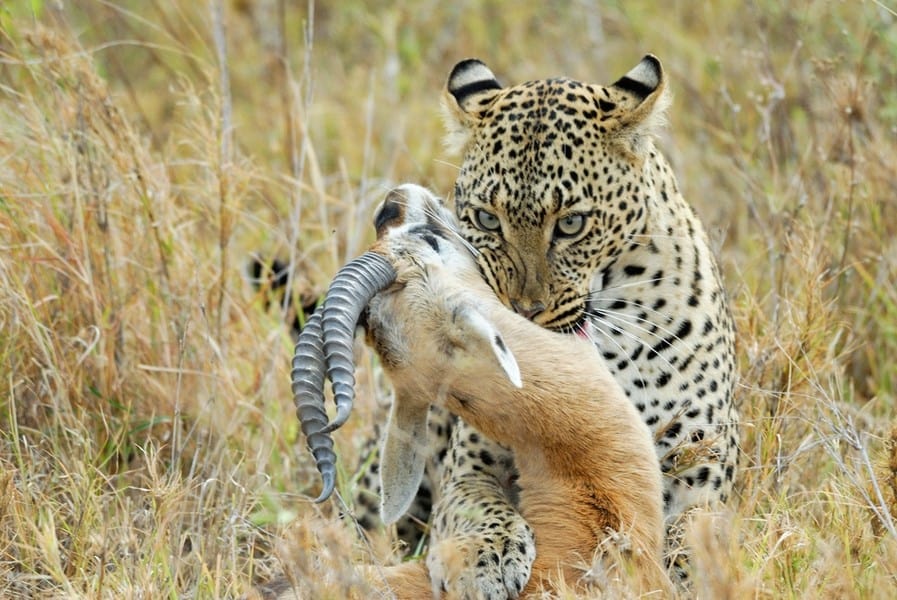
Wildlife Viewing
- The best time for wildlife viewing in Tarangire is during the dry season, particularly from July to October. The reduced foliage and concentration of animals around water sources make it easier to spot wildlife, including large herds of elephants and a variety of other game.
Bird Watching
- If you’re interested in bird watching or want to see the park in its most verdant state, the wet season is the best time. This includes the months of November and December and from February to April. The park is less crowded at this time.
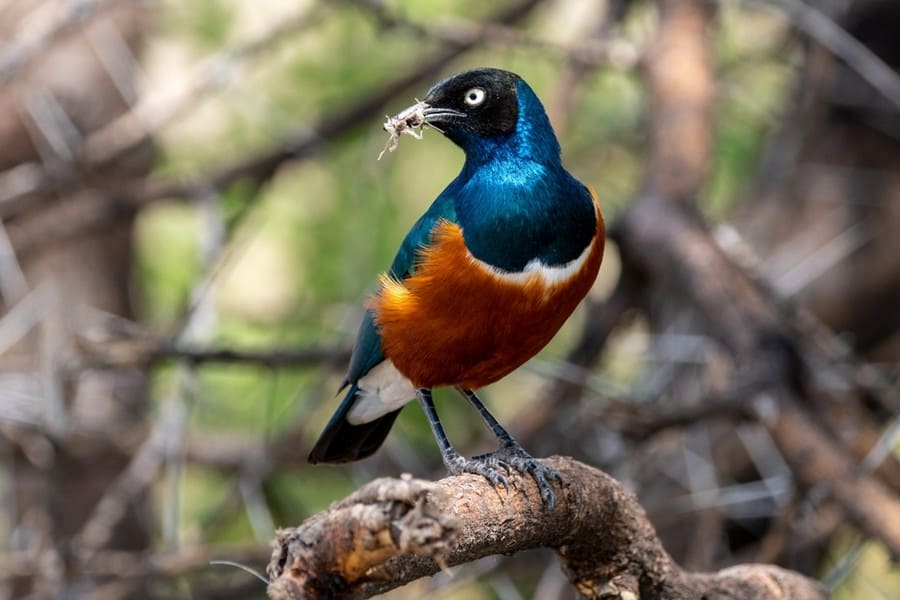
Shoulder Seasons
- June and November can be considered shoulder months, offering a balance between good wildlife viewing opportunities and fewer tourists.
Want to Visit Tarangire?
Join us on an Ultimate Kilimanjaro safari and experience the wildlife of Tarangire and Tanzania’s other famous destinations.
Ultimate Kilimanjaro Safaris
Related Posts
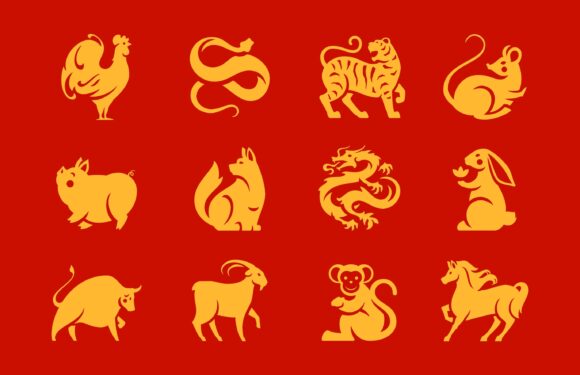
Chinese Zodiac Animals: What They Are and What They Mean
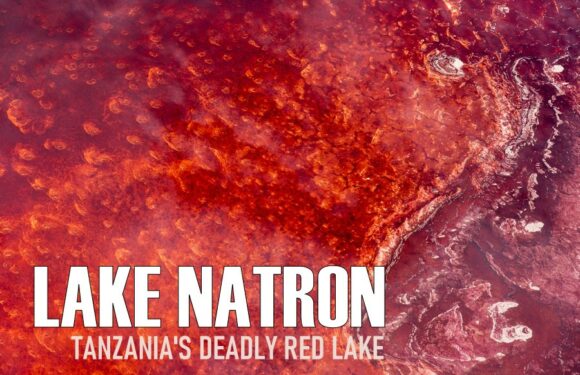
Lake Natron – the Deadly Lake That Turns Animals into Stone

What Animals Hibernate? It’s Not Just Bears
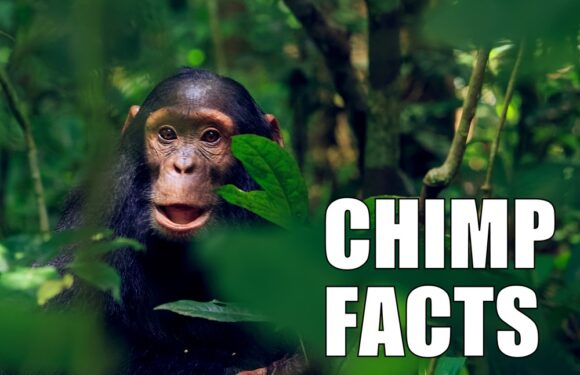
10 Fun Facts about Chimpanzees
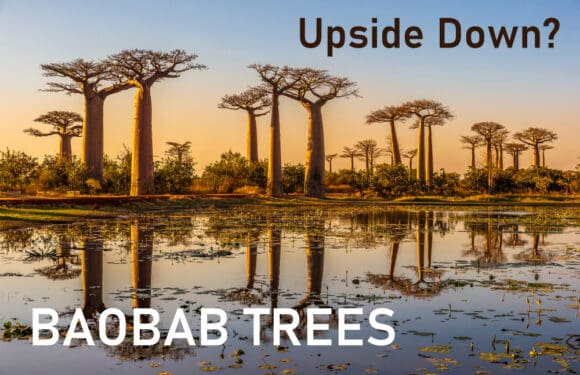
Baobab: Africa’s Upside Down Tree
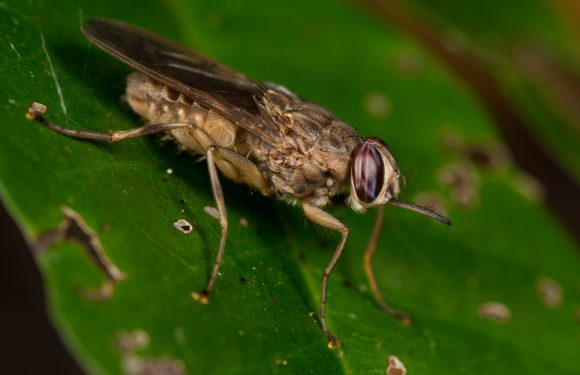
What the Heck are Tsetse Flies (and are They Dangerous)?
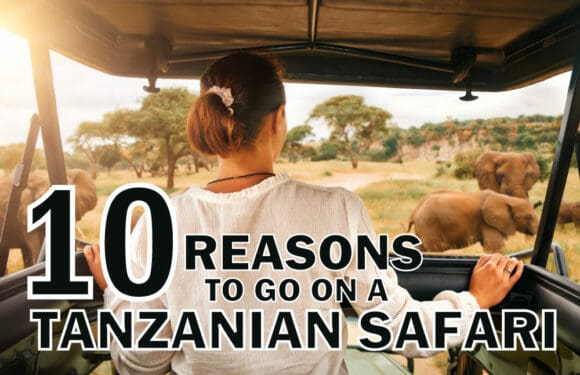
12 Fun Facts About Rhinos
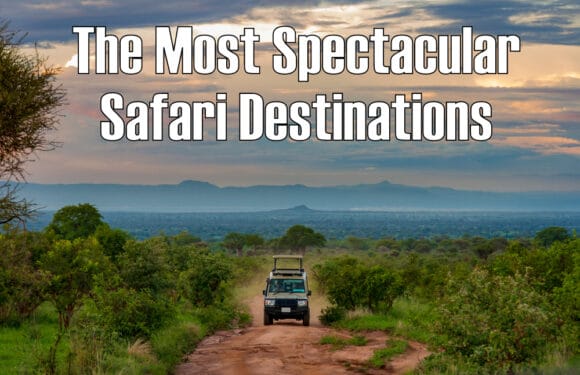
The Top 10 Safari Destinations in Africa
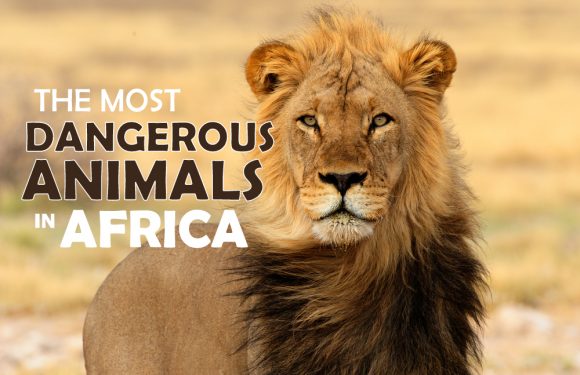
What are the Most Dangerous Animals in Africa?
Climbing kilimanjaro do it the right way. enter your email and get your free e-book instantly..

Safari at Tarangire National Park – Travel Guide, Sample Itinerary & More!
This post may contain affiliate links which means we may get a commission if you make a purchase at no additional cost to you. As an Amazon Associate we earn from qualifying purchases. Please read our disclosure for details.
"Each product we feature has been independently selected and reviewed by our editorial team. If you make a purchase using the links included, we may earn a commission."
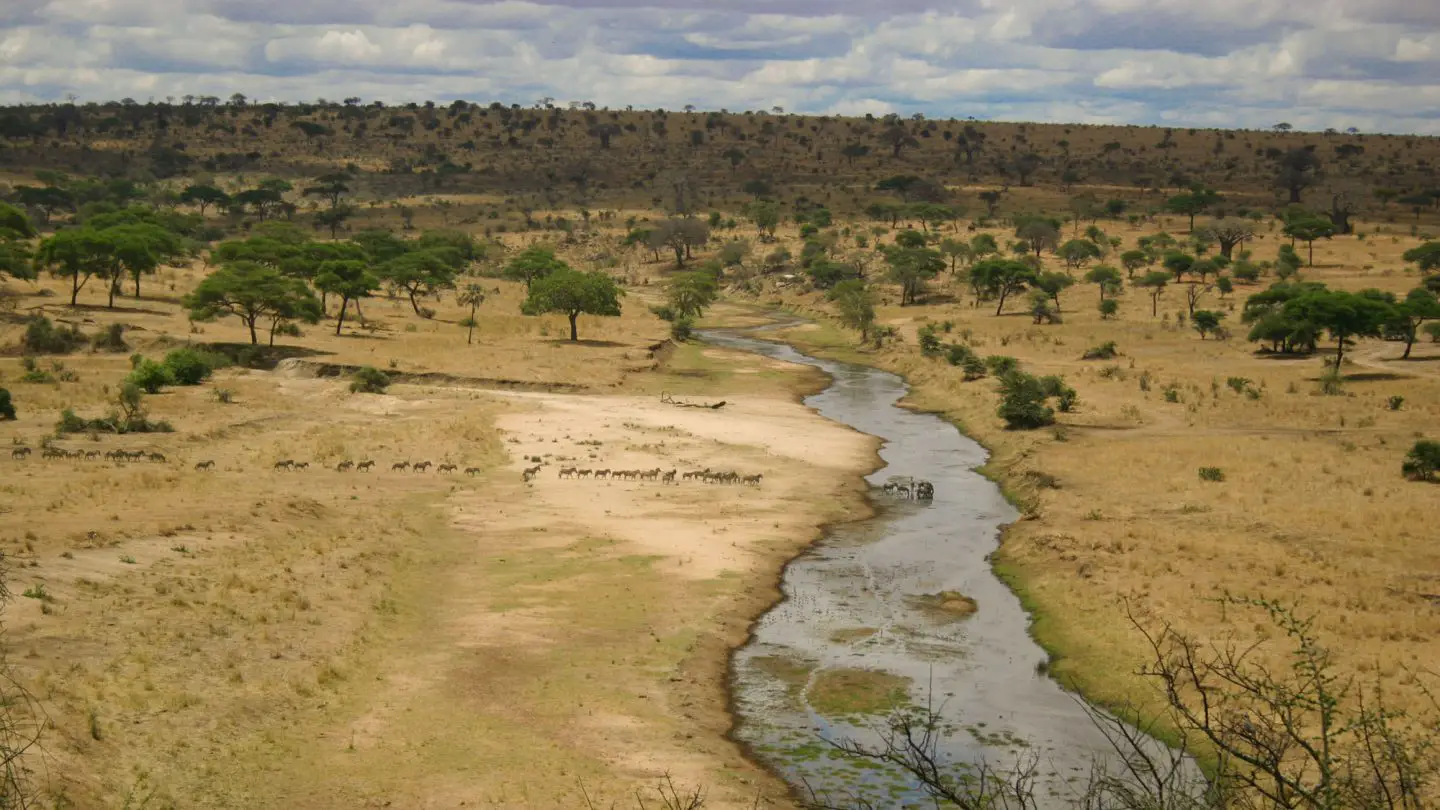
Tanzania’s National Parks are famous for the year-round greenery, the abundance of water sources, and phenomenal wildlife migration. And Tarangire National Park is no exception!
Tarangire National Park located in Northern Tanzania demonstrates all these characteristics, yet it is underrated because of its neighbors. On the bright side, there will be fewer tourists compared to Serengeti National Park, which will make your experience more authentic.
Introduction
Established in 1970, Tarangire National Park and Safari is the sixth largest national park in the country, covering 2850 square kilometers. The name which means “river of warthogs” originates from the Tarangire River, the primary source of water in the park.
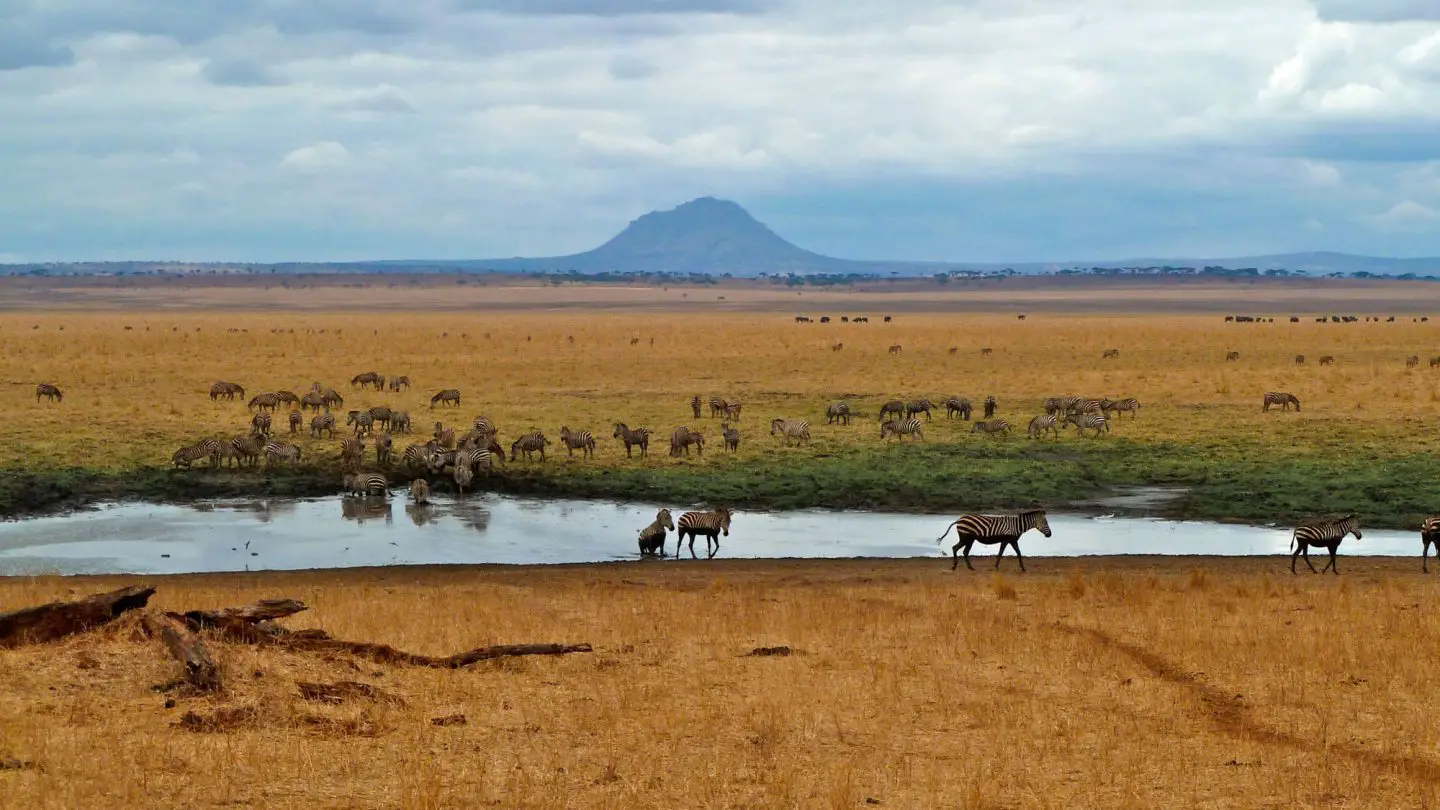
Tarangire Ecosystem is part of the East African Rift Valley that contains Lake Manyara and several other lakes. The area was completely submerged in water in prehistoric times, so the dried-up lakebed is extremely rich in minerals. The riverbed is surrounded by the rare yellow-barked fever trees that accommodate shy and elusive animals.
While many national parks suffer from water scarcity, Tarangire Park has sufficient water sources all year-round thanks to the Tarangire River.
These two factors are more than enough to attract hundreds of mammals from the surrounding parks. Tarangire National Park is home to a large population of elephants, birds, as well as baobab trees. Tarangire National Park elephants are mostly seen during temperate dry seasons.
Activities and Things to Do at the Tarangire National Park
Tarangire national park activities are not limited to regular game drives; there is an activity for every type of traveler.
Game viewing drives take place twice daily, once early in the morning and once late in the afternoon. Each drive takes about 2-3 hours, with stops at critical wildlife viewing points around the riverbed.
The experienced rangers will tell you all about the history and geology of the area, so your safari experience will be even more meaningful. Safari in Tarangire is up there amongst the best on the continent only bested by Safari in Kenya and South Africa.
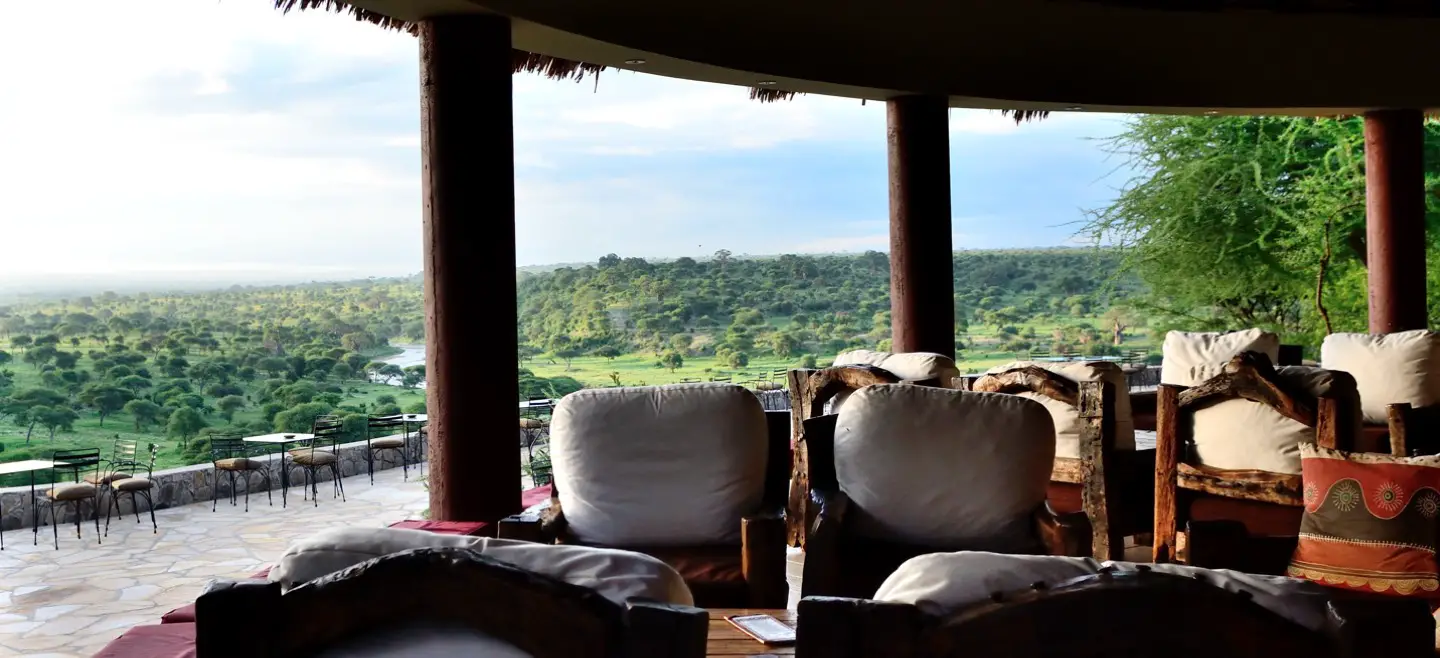
The hot-air balloon safari is a treat that you won’t get in many safari parks. Tarangire offers a scenic fly that starts just before the sunrise so that you can witness how the animals start a new day. The shades of gold and copper bring a whole new perspective to the landscape. These hot-air balloon safaris take an hour, followed by bush breakfast.
For a more adventurous tour, we recommend taking the walking safari tours. With the help of the guides, you will learn to appreciate both small and large animals from a short distance while learning about their survival mechanisms.
Besides, the private concessions around the park offer an even more special walking tour with local Maasai guides. Apart from the wildlife, the Maasai guides will enlighten you about the traditions of Maasai Warriors in the surrounding villages.
Tarangire’s campsites such as Oliver’s Camp and Swala camp offer night drives, where you can view nocturnal animals like leopard, aardwolf, and porcupine. These camps are all located in Tarangire national park.
Tarangire National Park Sample Itinerary

Because there are so many activities to choose from, we summarized them according to the time of the day they take place.
- Early morning: Hot-air Balloon Safari, Morning Drive
- Bush Breakfast
- Noon: Walking safaris, traditional Maasai nature walks
- Afternoon: Afternoon Game Drive
- Bush Barbecue
- Evening drives (for the campsites inside the park)
Related Posts Kilimanjaro Packing List: What Should I Pack for Mt Kilimanjaro? Safari Packing List for Tanzania The 10 Best Kenya National Parks (with Photos) 15 Safe Places to visit in Africa Best Countries to Visit in Africa
When To Go to Tarangire National Park
Tarangire has two main seasons. The wet season is between November and May. While the rains during the month of February are typically short, they get longer and cause thunderstorms in March-May.
With temperature ranging from 16° C – 28° C . This is not an ideal time to visit because many animals tend to migrate out of the park. The dry season is between June and October. The temperature range is similar to the wet season, except the rainfall is much less, and the days are mostly clear.
The dry season is the best time for viewing wildlife since animals tend to congregate around the water sources and riverbeds.
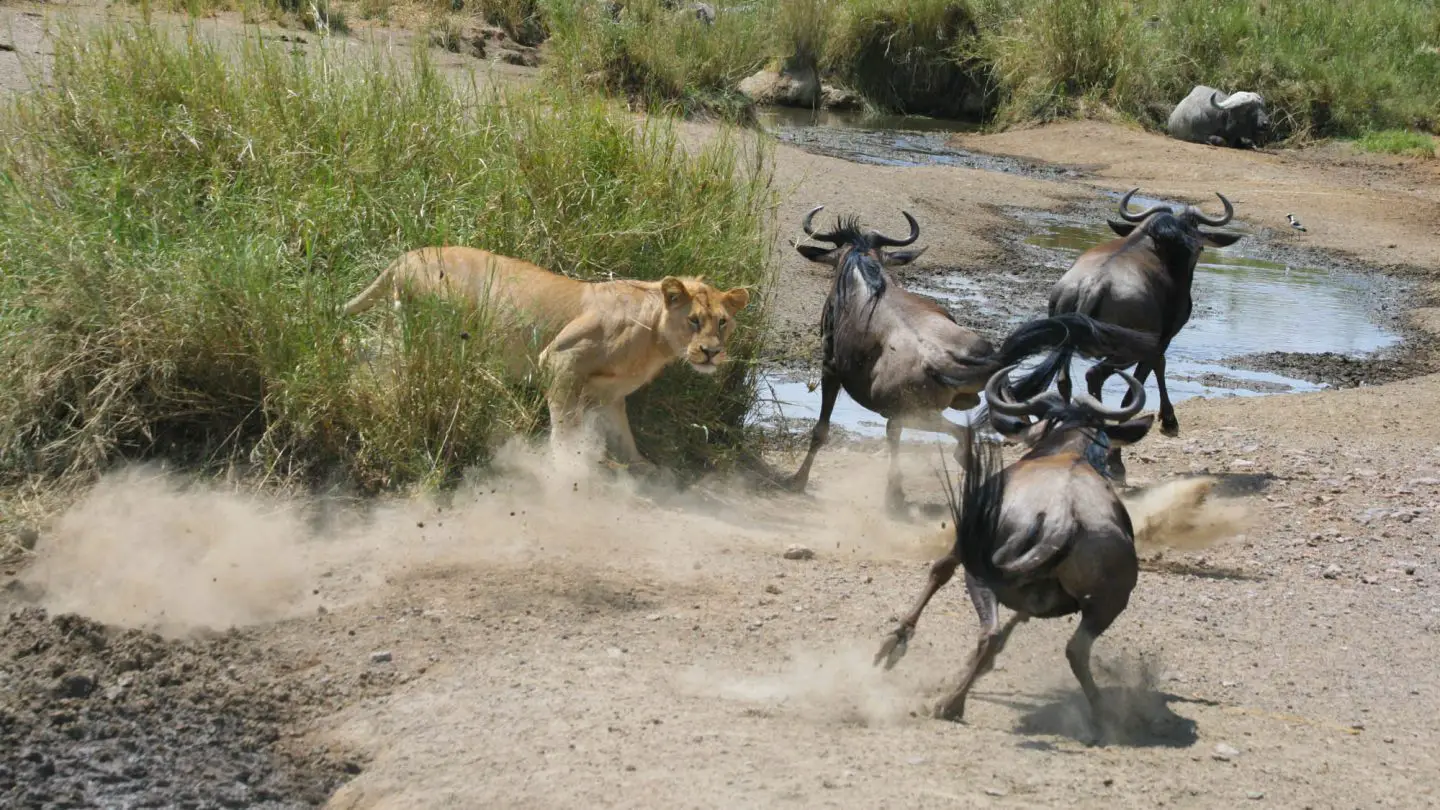
Except for endangered rhinoceros, we can’t think of a species that is absent from Tarangire National Park. However, it is essential to remember that the diversity of animals depends on the time of your visit.
The park teems with large herds of elephants and buffalo all year round and is considered one of the best places in East Africa to view them. The riverside also attracts big herds of wildebeest, giraffe, hartebeest, impala, gazelle, and zebra.
As a result, many predators commonly lurk around for hunting. You can spot lions, hyena, and wild dogs easily, while leopard and cheetah sights are rare. The Tarangire national park is home to the greatest concentration of elephants in Africa estimated at over 3,000 elephants during peak seasons.
Among the rare and endemic species, there are fringe-eared oryx and long-necked gerenuk in the swampy areas. Although the wet season is not ideal for viewing mammals, the park becomes a bird oasis during these months.
There are currently about 500 species of birds recorded, most of which are dry-country bird species like northern pied babbler and vulturine guineafowl. Migratory birds are also quite common in the area.
Safari Accommodations in Tarangire Park
The park has a few options for accommodation, catering to different budgets.
Kikoti Tented Camp
This is a private land just outside the national park, which comes with the bonus of rhinos introduced from other national parks.
The Kikoti Safari camp in Tarangire National Park is one of Tarangire National Park wildlife camps.
Tarangire Safari Lodge

The lodge is quite popular amongst visitors for its stunning views over the baobab trees and the Tarangire River. You can see hundreds of animals in a day without moving a muscle.
Safari lodges at Tarangire National park in Tanzania are one of the best tourist destinations in Africa.
Sopa Lodge

The lodge is ideal for those wanting to get a closer look at the baobab trees. With a capacity of 160 guests in 75 suites. The Sopa lodge in Tarangire National Park, Tanzania is known to be one of the biggest lodges in the park.
Tarangire Treetops
The treehouse provides a real jungle experience merged with the comfort of a five-star hotel room.
Swala and Oliver’s Camp
Swala and Oliver Camp are the lesser-known areas nestled in the quieter sections of the park. These are the ones that organize night safaris, as well as adventurous flying safaris.
Tarangire FAQ
Yes, you can. However, that leaves you vulnerable to insect bites and sunburns, so we strongly advise against it.
Southern Africa countries like Botswana and South Africa which are located in the Southern Hemisphere close to the poles do experience relatively cold weather. It surely does get cold at night and early in the morning, especially during the dry season. The temperatures can drop below 50ºF (10ºC) in the Kalahari area.
You need a passport, but Botswana doesn’t require a visa for citizens from certain countries. Check the official website to see what the current requirement for your country is.
Maun is generally a safe place, and violent crime is rare. However, you still need to be vigilant and protect yourself from petty theft and avoid walking alone in the dark.
Conclusion: Tarangire Park
Tarangire National Park might be smaller than Serengeti, but it is nothing short of Serengeti’s magical nature. If you want a more specialized experience while crossing every animal sight off your bucket list, Tarangire might just be the ideal safari destination for you.
You may also enjoy:
10 absolute best things to do in zimbabwe …, maputo 2024: best of maputo, mozambique travel and …, follow us around the world, our next destination.
Fez, Morocco
Call or WhatsApp: international: +255 755 849 094 | Europe: +351 912364040

Tarangire Safari Lodges: The 9 Best Mid-Priced Camps & Lodges of 2024
Wake up to wildlife grazing on the grass outside your veranda, dine under the African stars or watch baby elephants drink from a watering hole right in front of you at one of the best Tarangire safari lodges.
2 million tourists visit this East-African nation every year to experience Tarangire. Their vast wildlife, stunning views, and adventurous safaris make Tarangire a fun place to stay.
Enjoy one of the many different lodges in Tarangire’s stunning scenery to create a vacation and an experience that you will never forget.
We know that it can be difficult and intimidating to choose the best stay for your needs in a country that is so far away, but we are here to help. Whether you have already booked your Tanzania safari and you just need a place to stay, or you are starting your vacation from scratch, we are here to provide you with the best of the best Tarangire safari lodges.
1. Tarangire Sopa Lodge
Hidden within the vast kopjes, ancient baobab, and tall grasses, this 2017 World Luxury Hotel nominee blends in with its beautiful surroundings of the Tarangire National Park. The Tarangire Sopa Lodge is not fenced in. This means that wild animals have the freedom to roam about as they please, providing guests with close encounters with elephants.
As guests enter the Tarangire Sopa Lodge , they are welcomed to a high-ceiling lobby decorated with gleaming marble floors and hand-woven carpets. With a blast of cool air to offset the outdoor heat, a perfumed towel, and a refreshing welcome drink, guests will immediately find themselves relaxing within one of the most luxurious lodges in Tarangire.
The lounge and bar are located above the lobby with tall floor-to-ceiling windows to provide guests with the perfect dining view. After dinner, take a step out on the outdoor terrace to watch a colorful sunset that overlooks the African plains.
The Tarangire Sopa lounge serves lunch daily next to their resort-style swimming pool. Dinner is served every other day underneath a bed of African stars to give guests a dining experience that they will never forget.
Guest suites are equipped with a private lounge and minibar upon entering. They also have two queen size beds, a mosquito net, a well-appointed restroom and high, conical roofs to provide guests the luxury they deserve. Each room has a sheltered veranda to provide guests with stunning views from every suite.
2. Tarangire Safari Lodge
Kick your feet up and relax while admiring the jaw-dropping view from this lodge that overlooks the vast African plains with miles of trees.
The Tarangire Safari Lodge has many on-site facilities including their swimming pool, the Baobab Boutique and the open-air dining room that provides guests with international and home-style cuisine buffets.
The Tarangire Safari Lodge has tents and bungalows with local textiles to provide a cultural experience. Each room has personal bathrooms, solar-heated showers and plenty of storage space for belongings.
Safari tents have thatched roofs and large, mesh-screen windows to provide guests with stunning views and a remarkable connection to the world around them. Relax on your personal veranda and read a book or watch birds and animals after a long day of exploring. Located close to a watering hole and away from the main premises, the spacious bungalows are designed to provide guests with more privacy.
The Tarangire Safari Lodge encourages guests to enjoy the remarkable views and not their electronics. Power is available in the rooms from 6 a.m. to 10 a.m. and 6 p.m. to 11 p.m.
3. Tarangire Simba Lodge
This gem is on the northern safari circuit and is any safari-goers dream. The Tarangire Simba Lodge is surrounded by a wide variety of wildlife, an ancient Baobab tree and has magnificent views of Lake Burunge. The true African setting in this lodge will be one to remember.
Guests have a chance to get exceptionally close to wildlife at the Tarangire Simba Lodge with elephants, buffalo, ostrich, and giraffes periodically passing through the facility. If guests come during the dry season, they can see wildlife come right up to the waterhole in front of the lodge.
Guests are accommodated with a private and spacious, solar-powered tent that has a permanent thatch roof and wood floors. Each tent is also accompanied by a dressing room, toilet, shower and a private veranda with amazing views of Lake Burunge and some wildlife.
The food at Tarangire Simba Lodge is made with only the finest local ingredients. Fresh fruits, vegetables, and bread are served daily alongside a wide selection of breakfast foods, coffees, and teas.
Lunch at the Tarangire Simba Lodge is different from everywhere else with their wide variety of quiche, pizza, salad, spaghetti, and curry. As for dinner, a four-course buffet is served, which consists of bread, salad, two main courses, rice or potatoes, and fresh steamed vegetables.
4. Sangaiwe Tented Lodge
Sangaiwe Tented Lodge provides a peaceful lodge where guests can relax after their long safari days .
With the Sangaiwe Gate to Tarangire National Park located less than a kilometer down the road from the Sangaiwe Tented Lodge , wildlife wanders in and out of the lodge grounds. There is a hill behind the lodge that guests can climb up to participate in a guided nature walk.
Sangaiwe Tented Lodge shows a different side of Tarangire. Their building mechanism was implemented to minimize disruption to the Tarangire environment. The lodge is laid out across 40 acres of hillside woods that houses many beautiful African trees and indigenous plants.
Guests are accommodated with constructed tents that are on top of wood platforms and have gorgeous views of the Great Rift Valley and Lake Burunge. Each tented room is equipped with an attached bath, toilet and dressing room.
The approach to food at Sangaiwe Tented Lodge is simple. With a heritage of great food, they strive to serve fresh, local ingredients in an easy manner. Chef Regie is famous in the area and he ensures that the field to table time is short so guests always have the best experience.
5. Maramboi Tented Camp
Enjoy the best views of the Great Rift Valley while you relax in a luxury camp. Guests can watch zebras, warthogs, gazelles, and giraffes graze between palm trees that are a stone-throw away. Guests can also wade in the swimming pool with a refreshing drink in their hand or dine under the stars to top off their stay at the Maramboi Tented Camp.
Maramboi Tented Camp is located close to the coast of Lake Manyara and has premium services, genuine hospitality and exclusive accommodations to provide a spectacular scene and stay for their guests.
The vast savannah, golden vegetation and quiet atmosphere will provide guests with a stay and a view that they will never forget. The suite tents are both stylish and effective. They overlook Lake Manyara, and they are built on wooden platforms with plenty of en-suite facilities. Guests can choose from twin, double or triple rooms that are all featured with a balcony and stunning views.
6. Tarangire Angata Camp
This camp is located in the heart of the Tarangire National Park, and it overlooks the Tarangire River. This facility has a real campsite vibe and a complete view of the Tarangire Hill. Located just 5 km away from the Silale swamp plains, guests get to experience a truly authentic African safari.
The camp has eight guest tents, which are completely equipped with fully functioning bathrooms. Travelers can mix and mingle in the lounge over complementary Tanzanian coffee while they share safari stories. When the weather is permitting, they can also gather around the campfire.
Guests can enjoy breakfast, lunch, and dinner in the dining tent, or they can have a private bush lunch catered to them on the bush floor.
7. Tarangire Osupuko Lodge
Osupuko means “Virgin Land” or “Natural Paradise”. Local Tanzanians own the Tarangire Osupuko Lodge. They understand travelers expectations when it comes to accommodations, food, and wildlife.
Their en-suite, round huts have huge windows. These are designed for guests to enjoy the stunning views of wild animals grazing and the sun setting behind the Great Rift Valley.
Along with their amazing facility, Tarangire Ospuko Lodge also offers plenty of excursions. Travelers can participate in cycling, village and nature walks, astronomy evenings, night game drives, Massai Boma visits, and sundowners.
8. Lake Burunge Lodge
This lodge consists of 20 tents built on wood platforms and 10 bungalows. Each tent and bungalow has 24-hour solar electricity with a private bathroom and a private terrace to take in the view of Lake Burunge and Mount Meru.
Guests can enjoy their meals in the restaurant, the large terrace or they can arrange to enjoy a picnic. The Lake Burunge Lodge has an Infinity pool where guests can relax and enjoy the views of Lake Burunge.
Other activities that travelers can enjoy include a walk to the lake with a local, a private sunset with an appetizer and a cocktail, a morning or afternoon game drive, visits to ethnic local groups and many more.
9. Kichuguu Camp
You will feel right at home at Kichuguu Camp. Their motto is “The excitement of a day in the wild should be complemented by the familiarity of a night at home.”
The open-sided mess tents and the campfire provide a place for travelers to mix and mingle. Travelers can also enjoy their privacy in one of the guest tents with a private bathroom. While there is not much wildlife grazing through the facility, their simple yet authentic mobile tent site provides magnificent views of the baobab trees.
They have many safari options that guests can participate in. These trips include night safaris, walking safaris, balloon safaris and vehicle safaris,
Which Tarangire Safari Lodges Interest You?
Do you want to live one of these experiences? Book one of our custom safaris to have an experience of a lifetime and to fully immerse yourself in the Tanzanian culture.
While options for Tarangire safari lodges are endless, you don’t have to stick to just one lodge. Mix and match these beautiful lodges throughout your vacation so you get to experience more than one during your stay.
If you have any questions about your stay at Tarangire, please feel free to contact us for advice.
Share This Story!

USEFUL LINKS
About Us Customer Reviews Tanzani Safaris & Tours Travel Blog Terms and Conditions Contact Us
COVID-19 update
EXPERIENCES
Honeymoon Safari Hot Air Balloon Great Migration Cultural Tourism
Tanzania & Zanzibar High-End Cultural Safari & Zanzibar Best of East Africa Lions of Serengeti Serengeti Premium Safari
DESTINATIONS
Tanzania Kenya Rwanda Uganda
Serengeti Zanzibar Kilimanjaro Ngorongoro Crater Tarangire Lake Manyara Selous Ruaha
Office +255 768 893 230
Safari Inquiries +255 755 849 094
2nd Floor, Saba General Building, Namanga Road PO. Box 16353, Arusha, Tanzania.
Follow us on
Facebook Instagram Twitter LinkedIn Pinterest Tripadvisor
© Copyright 2024 Earthlife Expeditions , All Rights Reserved. | Web by Spike
We Accept | Master Card | Visa Card | Wire Transfer
- You are here:
- Countries & Parks
- Tanzania Parks
Tarangire National Park

Best Time To Visit
Weather & climate.
- Getting There
- Malaria & Safety
Overview – Tarangire NP

Philip is a renowned Africa expert and author of many Bradt guidebooks to African destinations, including the guide to Tanzania.
Philip is a renowned Africa expert and author of the Bradt guidebook to Tanzania.
Philip is the author of the Bradt guidebook to Tanzania.
Tarangire National Park is most famous for its dense population of elephants. These imposing animals are present in large numbers throughout the year, but are most abundant in the Dry season, particularly from July to November. This is also when zebra, wildebeest and other wildlife in the greater Tarangire migratory ecosystem converge on the park and its namesake river, which forms the only source of drinking water for miles around.

Pros & Cons
- Incredible year-round elephant concentrations
- Great general wildlife viewing in the Dry season
- Excellent birding with many dry-country specials
- Stunning scenery with big baobab trees
- Excellent mid-range and luxury lodges
- It gets crowded during high season (June to October)
- Animals are scattered in the Wet season
Tarangire NP Safari Reviews
- Expert Rating 3.8 /5 – 13 Reviews
- User Rating 4.6 /5 – 296 Reviews
In the Dry season, herds of up to 300 elephants can be seen digging for underground streams in the dry riverbeds, while migratory wildebeest , zebra, buffalo, impala , gazelle , Coke’s hartebeest and eland crowd the shrinking lagoons. Of the big cats , only lion is regularly spotted. There are lots of smaller predators too, such as black-backed jackal and bat-eared fox . Abandoned termite mounds often house dwarf mongoose colonies.
- More about Tarangire's wildlife
The park’s main feature is the Tarangire River. Although it gets very dry, the landscape is thickly vegetated with acacia shrubs and mixed woodland. Most memorable are the huge baobab trees dotted around in big numbers. The south of Tarangire is dominated by a vast seasonal swamp network.
Game drives in Tarangire are highly rewarding throughout the day in the Dry season. Early morning and late afternoon are best for spotting predators, but during the midday heat you’ll see big elephant herds drinking. You’ll get a very different experience on a night drive when you'll look for nocturnal animals by spotlight. The best way to get a true connection to the wilderness, though, is on foot. An armed ranger will keep you safe on this exciting activity.
Tarangire’s Wet season runs from November to May. November to December is usually the time of the short rains, while the long rains see heavier rainfall from March to May. In between, in January and February, is a brief period of drier weather. June to October is the Dry season.
- More about the weather and climate
Tarangire is a seasonal park with lots of wildlife between July and November. At this time animals are attracted to the Tarangire River, the main source of drinking water. Pack plenty of warm clothes for early morning game drives at this time of year, as it’s cold when the sun is low in the sky.
- More about the best time to visit
Want To Visit Tarangire NP?
2,117 Tarangire Safaris
- Tarangire Budget Safaris
- Tour Operators for Tarangire
Most Helpful Expert Review

Brian is an award winning travel writer, author of safari books and regular contributor to magazines such as BBC Wildlife and Travel Africa.
Tanzania’s most underrated wilderness
Although it’s only a couple of hours up the road from Arusha, most tourists hurry on towards Lake Manyara and Ngorongoro with barely a second glance at the Tarangire turn-off; and in doing so they are missing the wildest park on...
Full Review
Latest User Review

This is where you find millions of what Tanzanian wildlife has to offer.
Safari Tours to Tarangire NP

10-Day Beach Holiday and Game Drive Safari - Exclusive
$3,762 to $4,301 pp (USD)
Tanzania: Private tour Luxury Lodge & Tented Camp
You Visit: Arusha (Start) , Tarangire NP, Lake Manyara NP, Serengeti NP, Central Serengeti NP, Ngorongoro Crater, Zanzibar (Tanzania Beaches) , Arusha (End)
Kojuu Safaris Africa
5.0 /5 – 36 Reviews

5-Day Experience Wilderness up Close in Camping Safari
$1,210 pp (USD)
Tanzania: Private tour Budget Camping & Lodge
You Visit: Arusha (Start) , Tarangire NP, Serengeti NP, Central Serengeti NP, Ngorongoro Crater, Lake Manyara NP, Arusha (End)
Golden Trips Tanzania
4.8 /5 – 33 Reviews

9-Day Luxury Tailor-Made Tanzania Wildlife Safari
$7,815 to $11,877 pp (USD)
You Visit: Arusha (Start) , Tarangire NP, Ngorongoro Crater, Northern Serengeti NP, Arusha (End)
Wayfairer Travel
4.9 /5 – 149 Reviews
Tarangire Safari Lodge

View prices for your travel dates
- Excellent 858
- Very Good 315
- All languages ( 1,263 )
- English ( 1,000 )
- French ( 72 )
- Italian ( 54 )

" Ask for a bungalow if you want plugs in your room. The electricity is turned off from 11pm to 6am, but that was plenty of charge time for us "
" Book early!! This place fills up quickly but you don't want to miss out. "
" Ask for accommodation near the main lodge so you don't have to walk so far "
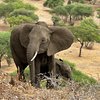
" Binoculars are a mudty "
" Outstanding lodge. Every tent is excellent, good food, night safari is very interesting if a little accelerated adventure "
Own or manage this property? Claim your listing for free to respond to reviews, update your profile and much more.
Tarangire Safari Lodge - UPDATED 2024 Reviews & Photos

- Safari ideas
- Experiences
- Special offers
- Accommodation
- Start planning
- Booking terms
- When to go on safari - month by month
- East or Southern Africa safari?
- Solo travellers
- Women on safari
- Accommodation types & luxury levels
- General tips & advice
- All stories
- Afrika Odyssey Expedition
- Photographer of the Year
- Read on our app
- 2024 entries
- 2024 details
- 2024 prizes
- 2024 entry form
- 2023 winners
- Collar a lion
- Save a pangolin
- Rules of engagement
- Job vacancies
- Ukuri - safari camps
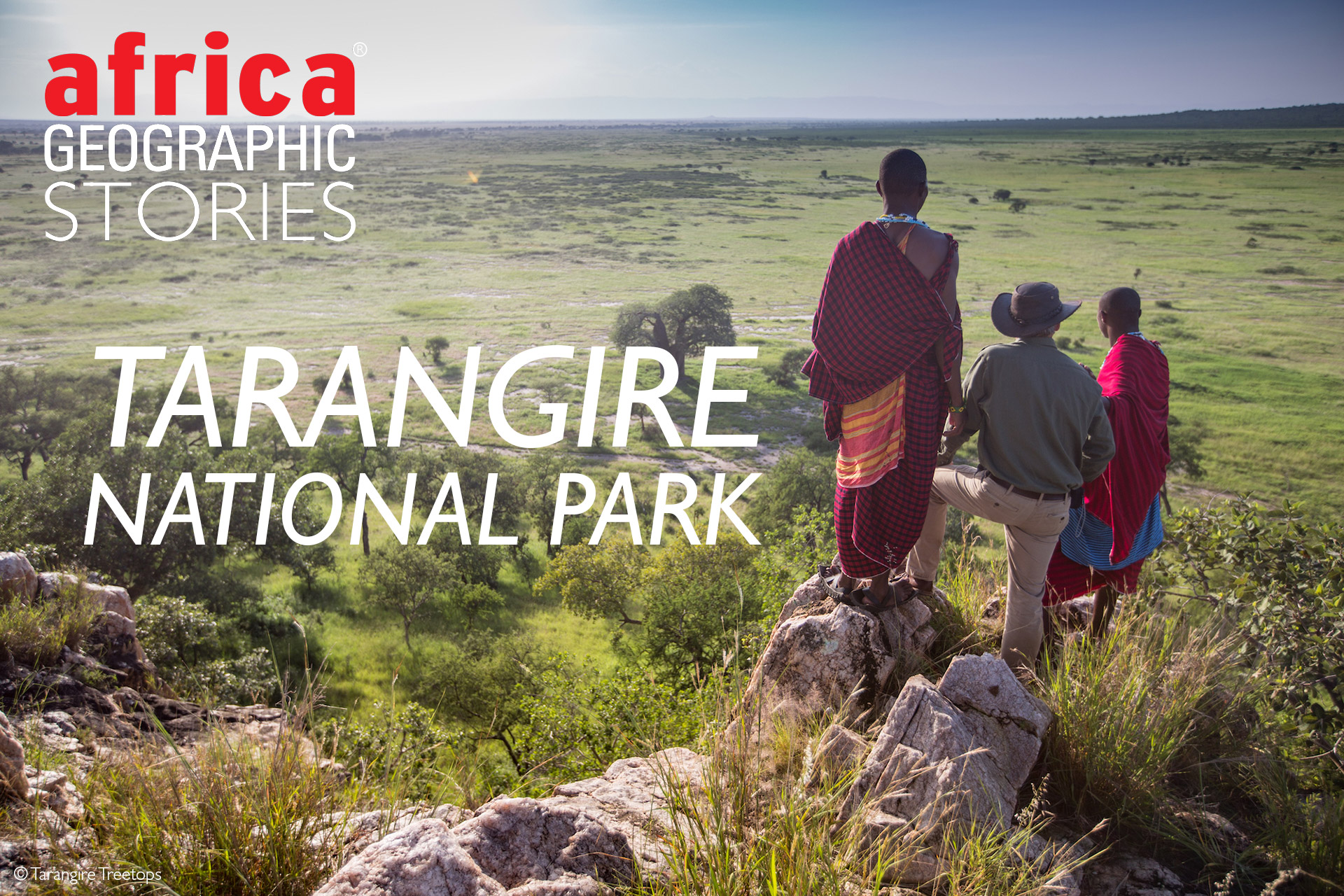
Serengeti wildlife, minus the crowds

Tuesday, 26 April 2022

Northern Tanzania’s safari scene is dominated by the Serengeti and neighbouring Ngorongoro Crater. There are many good reasons for this – sightings are reliable, especially when the Great Migration is passing through, and the scenery is breathtaking. Yet there is a third, often forgotten, national park in the northern circuit: Tarangire National Park. Tarangire is a place of giant baobabs, fever tree forests, shimmering swamps and sweeping vistas, where wildlife roams in abundance. In this region, travel is still infused with the true romance of an African safari.
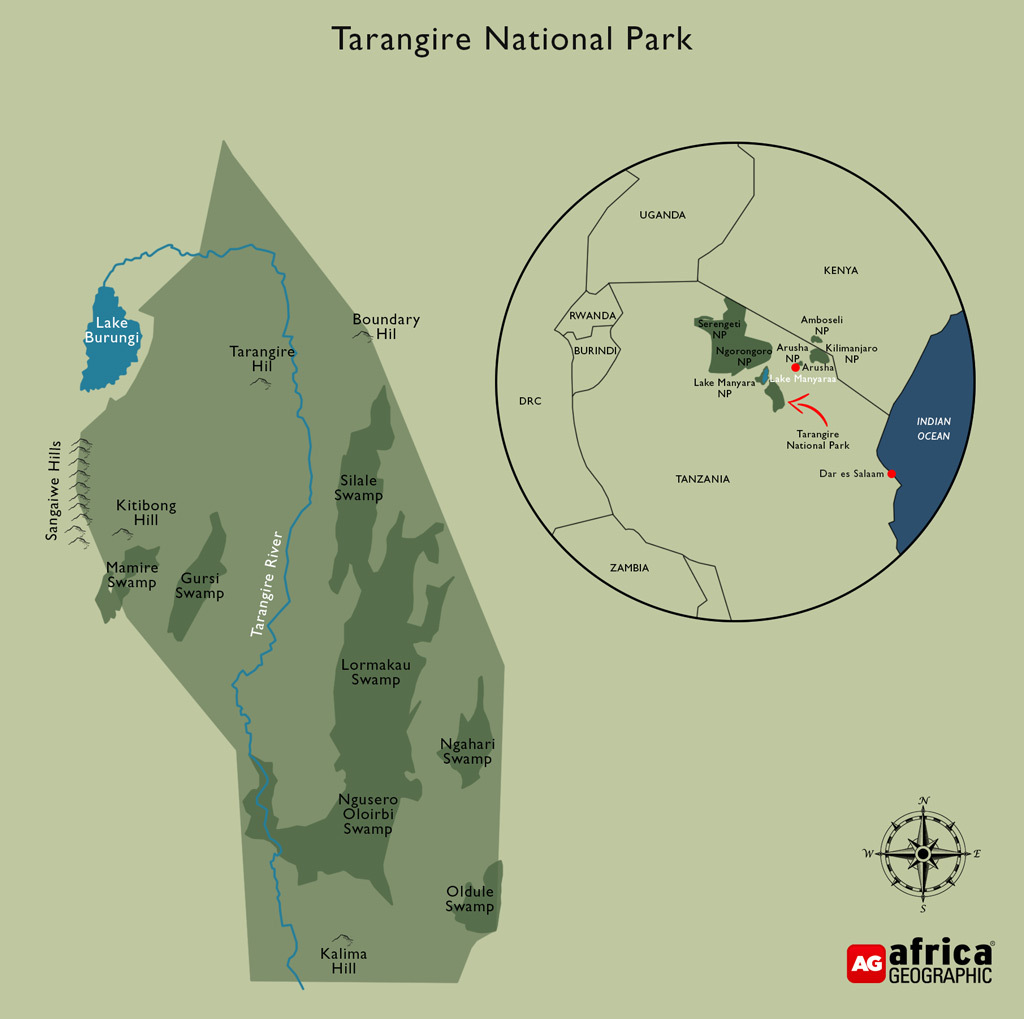
Tarangire National Park
Situated in Tanzania’s Manyara Region, just southeast of Lake Manyara National Park, Tarangire is just over 100km from the city of Arusha. This makes it easily accessible for travellers en route to the Serengeti National Park and Ngorongoro Conservation Area , situated further west. The national park extends over 2,850km 2 (280,500 hectares), but the land available to wildlife is expanded by Game Controlled Areas, conservancies, and the Tarangire Conservation Area. Here, people and wildlife exist side-by-side. Several luxury lodges operate in these concessions on the park’s fringes, allowing their guests to experience both the park and the increased freedom away from its confines – by offering night drives, for example.
From the Tarangire River in the north, rolling hills give way to vast swamps. These soak up the rain like sponges and maintain a tinge of green, even during the dry season. Away from the watery marshlands, the landscape is dotted with granitic ridges, red-earth termite mounds and sparse whistling thorn ( Vachellia drepanolobium ) woodlands. Throughout, bulbous baobabs ( Adansonia digitata ) impose themselves upon the backdrop, dwarfing even the enormous herds of elephants that forage around them.
The Tarangire Migration
Life in the northern section of the park (in terms of lodges, campsites, and wildlife) revolves around the sinuous bends of the Tarangire River. This geographical feature plays a pivotal role in Tarangire’s most remarkable natural phenomenon – the Tarangire migration. Though not involving the same wildlife numbers as the famous Great Migration, Tarangire’s migration is arguably equally sensational given its strict seasonality and the exceptional variety and densities of wildlife.
The park is part of an enormous ecosystem that includes Lake Manyara, the Maasai Steppe, and the area from Lake Natron to Mount Kilimanjaro. Every year during the dry season, the Tarangire River becomes one of the only available sources of water, and tens of thousands of animals are drawn to its banks and floodplains from miles in every direction. These include several species of antelope, buffalo, giraffe and zebra. Elephants also arrive in their hundreds, and Tarangire is believed to have one of the largest elephant populations in Tanzania.

Elephants, elephants (and everything else) everywhere
Tarangire is an elephant enthusiast’s paradise. It is impossible to spend time in the park without encountering these iconic pachyderms, feeding at the base of a baobab, strolling through the riverine forests or playing in the mud of the marshes. They are often present in a conglomeration of herds that may number close to 300 individuals – an incredible sight for even the most seasoned safari-goer.
Elephants aside, Tarangire is home to one of the greatest concentrations of wildlife outside of the Serengeti ecosystem. The dry season influx of ungulates sees a profusion of wildebeest, zebra, gazelle, eland, hartebeest and buffalo assembled near the river, or around residual pools in the swamps. Such a concentration of prey serves to attract the attention of the park’s various resident predators – particularly the ever-attendant lions. The lions of the Silale Swamps are particularly renowned, not only for their marshy hunting techniques, but also for their habit of lounging in the boughs of trees, perhaps to escape the tsetse flies. Leopards and cheetah are also present, though less regularly seen, and even African painted wolves (wild dogs) come haring through the park on occasion.
Away from the wetter areas of the park, visitors may even be fortunate enough to spot a gerenuk or fringe-eared oryx , making Tarangire one of the few places in Tanzania to see these arid specialists.
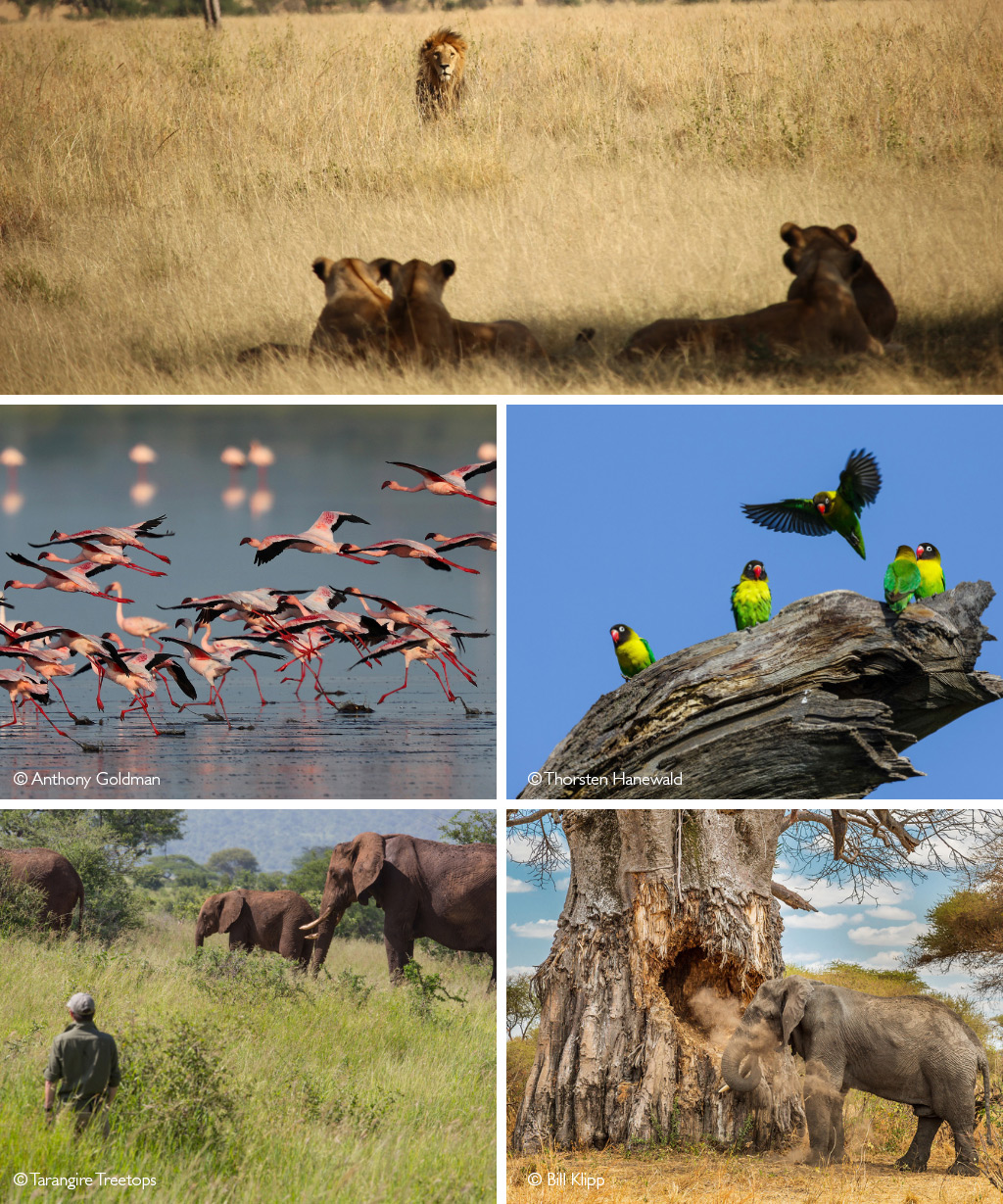

Twitching through Tarangire
For those able to tear their eyes away from the mammal life on display, Tarangire’s many varied habitats confer it the status of one of Tanzania’s top birding hotspots, with over 500 species recorded. From chattering flocks of yellow-collared lovebirds to stately ostriches picking their way across the plains, avid birders will find it a struggle to know where to look next. In contrast to mammal viewing, the best bird sightings are during the wetter months (November to May). This is when the swamps come into their own for waterbird watching, and migrant arrivals fill the skies. In addition, many dry-region bird species such as vulturine guineafowl and northern pied babbler are present at the margins of their ranges. Enthusiasts can while away the hours searching for the drab but sought-after endemic rufous-tailed weavers and ashy starlings, or search for the flash of colour signalling the arrival of the dazzling red-and-yellow barbets.
Explore & Stay
Like much of East Africa, Tarangire experiences two rainy seasons: the “short” rains in November and the “long” rains in April and May. However, heavy rainfall can occur any time from November until May, and many of the lodges and camps close down for the rainy season when the park becomes boggy and difficult to traverse.

Accommodation options in Tarangire National Park and surrounds range from public and private campsites to high-end luxury lodges. Naturally, Tarangire is at its best during the dry season, from July until October. During this time, concentrations of wildlife are mind-boggling, and, conveniently, this is also when tsetse flies are at their least active. Walking safaris at this time of year are as phenomenal as game drives, and the open habitats allow for comfortable and easy encounters with the larger wildlife species. For those looking to combine their trip with a chance to see the Great Migration , this is generally when the zebra and wildebeest begin to move north into the Maasai Mara in Kenya.
One of the major attractions of Tarangire National Park is that even during the tourism high season (June to August) when many of the parks throughout Africa are at their busiest, it remains one of Tanzania’s best-kept, uncrowded secrets.
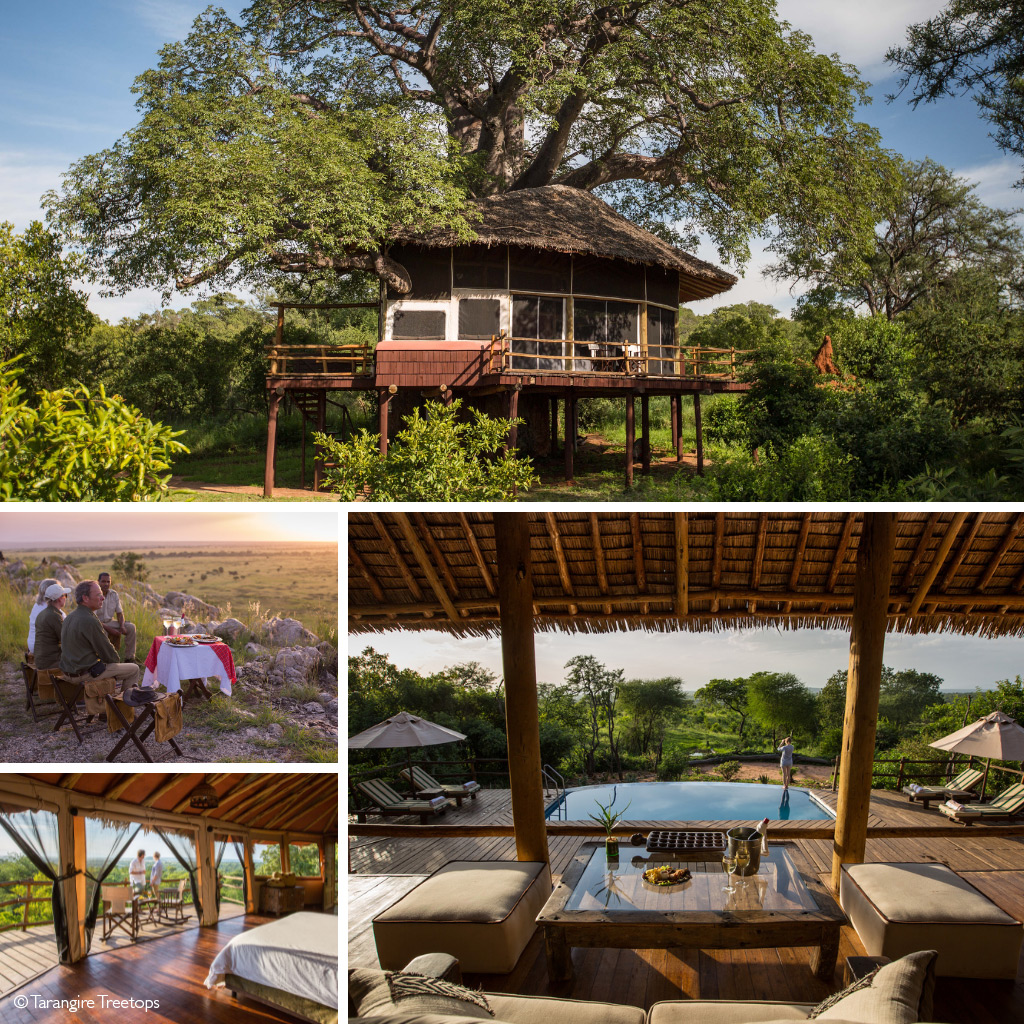
The perfect safari
Tarangire is often treated simply as a stop-over between the more popular destinations on Tanzania’s northern safari circuit. Yet those visitors who opt to explore this varied and fascinating national park are richly rewarded by one of Africa’s most underrated safari destinations. With magnificent scenery and an abundance of wildlife, Tarangire National Park has every ingredient needed for the perfect safari.
Want to go on safari to Tarangire? To find lodges, search for our ready-made packages or get in touch with our travel team to arrange your safari, scroll down to after this story.

HOW TO GET THE MOST OUT OF AFRICA GEOGRAPHIC:
- Travel with us . Travel in Africa is about knowing when and where to go, and with whom. A few weeks too early / late and a few kilometres off course and you could miss the greatest show on Earth. And wouldn’t that be a pity? Browse our ready-made packages or answer a few questions to start planning your dream safari .
- Subscribe to our FREE newsletter / download our FREE app to enjoy the following benefits.
- Plan your safaris in remote parks protected by African Parks via our sister company https://ukuri.travel/ - safari camps for responsible travellers
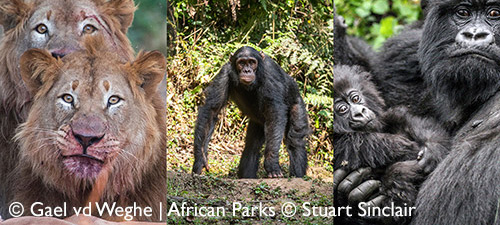
Friend's Email Address
Your Email Address
+255 763 058 584 +255 682 784 150 [email protected]

Tarangire National Park Walking Safari
Tarangire national park walking safari. A Tarangire national park walking safari is one of the best and most rewarding Tarangire national park safari activities that travelers can enjoy while on Tarangire national park safaris all throughout the year. Track the huge and deep footprints of elephants in Tarangire national Park, famous for the huge herds of elephants seen freely ranging in the park.
A guided walking safari in Tarangire National Park sets you on your foot, following animal trucks in the most secluded parts of Tarangire National Park in the company of ranger guides and experienced field guides with whose expertise you shall help you recognise and follow wildlife tracks. Awaken every sense of yours, take in fresh air and embrace the African wilderness with each small step you take in the Tarangire National Park. Walking safaris in Tarangire National Park are done in a very environmentally friendly manner with very minimal disturbance to the natural field and almost leaving the animals undisturbed.
Delight yourself and your senses with rare up-close encounters with wild game, coming about 15meters away from zebras, waterbucks, ostrich, and impala, among so many others including the impressively giant African elephants . Your guide shall share information about the animals seen including their behaviours, tracking skills and so much more.

Tarangire National Park is one beautiful Tanzania safari destination located in the northern part of Tanzania, making part of the most sought after Tanzania safari destinations in the northern safari circuit of Tanzania which encompasses destinations like the world sought after Serengeti national park and Ngorongoro Crater, as well as Lake Manyara national Park which all reward travelers with amazing wildlife safari experiences. Visiting these Tanzania safari destinations has travelers seeing l the big 5 animals in Tanzania, and beyond. Travelers who book for travel in appropriate times get the chance to witness the great wildebeest migration in Serengeti national park Tanzania.
Tarangire National Park is famous for hosting huge herds of elephants seen freely ranging in the savanna plains of the park; as well as the huge baobab trees which dot the savanna plains and thus add s much more beauty to the park. While out on a guided Tarangire national park walking safari, you are sure to enjoy such scenic views, and get to see a variety of animals including elephants among so many others all in the company of a ranger guide.
There are a variety of other activities in Tarangire National Park that travelers can do while on Tarangire National Park safaris. Other activities in Tarangire National Park include game drives, night game drives, bird watching, community visits, hot air balloon ride mong so many others.
How to get to Tarangire national Park
While looking to visit Tanzania and the Tarangire Park in particular for your Tarangire national par k walking safari experience, you can access the park both by air and by road. There are a number of scheduled and charter flight operated by different domestic airlines that fly to different destinations near the park like Lake Manyara airport. By road, you can access the Tarangire National Park by driving through the countryside; Tarangire National park is only about 2.5 hours away from Arusha Town.
Best time to go for Tarangire National Park Walking safaris
Tarangire National Park walking safaris can be done all throughout the year. The best time for Tarangire National park safaris as well as walking safaris in Tarangire National Park is during the dry season when the paths are clearer and nit muddy and slippery, and animals are in much easier view; s well as not being interrupted with downpours while out on your Tarangire National Park walking safari.
Tarangire National Park is one of the best and most sought after Tanzania safari destinations that travelers after experiencing the African wilderness visit and get introduced to the wilderness of Tanzania. Tarangire National Park is as rewarding as any other Tanzania national park, making it one of the visited parks included in various Tanzania safari packages .

Looking to explore Tarangire National Park on guided walking safaris or any other form of activities that are in the park, get in touch with a reputable tour operator like Focus East Africa Tours and get yourself one of the most amazing Tarangire National park safari packages .

Parc National de Tarangire
le guide complet
Sixième plus grand parc de Tanzanie , le Parc National de Tarangire (Tarangire National Park en anglais) n’est pourtant pas parmi les plus connus. Sa rivière, dont il porte le nom et qui signifie “rivière de phacochères”, traverse les plus de 2600 km2 du parc.
De nombreux animaux viennent s’y rafraîchir, notamment pendant la saison sèche, et offrent de belles chances d’observation de la faune africaine. Retrouvez dans ce guide toutes les informations pratiques pour préparer votre visite du Parc National de Tarangire.
Pourquoi se rendre au Parc de Tarangire
Un safari dans le parc de tarangire.
La rivière pérenne de Tarangire attire de nombreux animaux qui viennent migrer dans le parc pendant la saison sèche. Ils arrivent de Manyara ou de Ngorongoro à la recherche du seul point d’eau de la région. Ainsi, le Parc National de Tarangire est réputé pour les milliers d’éléphants qui y ont élu domicile.
C’est sans conteste l’un des parcs de Tanzanie qui compte le plus grand nombre de ces mammifères aux défenses d’ivoire.
On peut aussi observer des zèbres, lions, gnous, buffles, léopards, guépards, antilopes, girafes, pythons… Ainsi que des espèces plus rares, uniquement présentes à Tarangire, comme les oryx, les koudous, les généruks voire des lycaons. Les rhinocéros ne sont pas présents dans le parc.
La rivière est propice à l’observation de nombreuses espèces d’oiseaux : vautour, aigle, martin-chasseur, grue couronnée, hirondelle striée et bien d’autres. Pas moins de 550 espèces d’oiseaux sont dénombrées (plus qu’à Serengeti !).

Même s’il est facilement accessible, le Parc National de Tarangire est peu visité. Vous êtes sûrs de profiter d’un safari en toute tranquillité. Comptez au minimum 3 jours pour un safari dans le Parc National de Tarangire, répartis entre le Nord puis le Centre et le Sud du parc, beaucoup moins fréquentés. Des safaris nocturnes et des safaris à pieds sont aussi organisés à Tarangire par les lodges et les camps de toile.
Les autres activités à faire
Assez peu touristiques, les safaris sont la principale activité pratiquée dans le parc de Tarangire. Au Sud du parc, il est quand même possible de visiter un village typique Massaï, appelé un Boma. Vous découvrirez les habitations et les pratiques traditionnelles des peuples Massaï.
Comment se rendre au Parc de Tarangire
Le parc est situé dans une région plutôt touristique et facilement accessible de la Tanzanie. Pour vous rendre au Parc de Tarangire, plusieurs solutions s’offrent à vous :
- En voiture : 110 km séparent Tarangire d’Arusha. Il faut compter environ 2 heures de trajet sur une route goudronnée pour accéder à la porte principale de Tarangire. Le parc est aussi accessible de Mto Wa Mbu (70 km), le village le plus proche du Parc de Manyara pour combiner les visites.
- En avion : il existe des liaisons aériennes entre le Parc de Tarangire et le Parc du Serengeti. Vous gagnerez un peu de temps, mais le coût reste onéreux.
Une fois arrivée près du parc, vous pourrez accéder à l’enceinte par la porte principale située au Nord, la plus directe depuis Arusha. C’est aussi ici que se trouve le quartier général des Rangers.
Deux autres portes permettent de pénétrer le parc :
- Porte de Boundary Hill au Nord-Est
- Porte de Sangaiwe au Nord-Ouest
Le Parc National de Tarangire est ouvert de 6h à 18h.
Tarifs et réglementation
Tarangire : prix d’entrée.
Les tarifs pour visiter le Parc National de Tarangire sont les suivants :
- $45 par adulte
- $15 par enfant de 5 à 15 ans
- Gratuit pour les moins de 5 ans
À cela, s’ajoute la TVA à 18%. L’entrée est valide pour une durée de 24h. L’entrée du véhicule dans le parc est aussi payante. Selon les conditions de votre voyage (organisé, en groupe, individuel, …), vérifiez si cela est inclus.
Réglementation du parc
La réglementation qui s’applique pour les visites du Parc de Tarangire est la même que dans les autres parcs de Tanzanie . Respect des animaux, respect de la flore, vitesse limitée, tout vous sera expliqué à l’entrée du parc.
Où dormir au Parc de Tarangire
À l’intérieur ou à proximité, plusieurs types de logements sont proposés aux visiteurs du Parc de Tarangire.
Des aires de camping publiques sont accessibles, dans le cas où vous voyagez seul, dont une directement à l’entrée principale du parc. Les groupes organisés disposent quant à eux d’aires de “camping spéciales” dans lesquels les organisateurs doivent amener tout le nécessaire.
Les camps de toile
Ils sont composés de chambres privatives en toile ou en semi-dur. Les niveaux de prestations varient, et les prix aussi. Certains très luxueux disposent d’une piscine, d’un restaurant, d’un bar alors que pour d’autres, les prestations sont plus succinctes.
Un exemple de logement apprécié des voyageurs est le Baobab Tented Camp au Nord du parc.
Les lodges disposent de chambres en dur avec sanitaire et souvent une terrasse privée. Pour une version luxe et atypique, le Tarangire Treetops propose des chambres construites sur les branches des baobabs et figuiers centenaires, offrant une vue panoramique sur le parc.
Le Parc de Tarangire : autres informations pratiques
Avec ses 100 km de long et environ 30 km de large, le Parc National de Tarangire s’étend sur plus de 2600 km2. Avec des reliefs peu marqués, son altitude moyenne est de 1100 mètres. Il est situé au nord de la Tanzanie, un peu plus au Sud que le Lac de Manyara .
Il est principalement composé de la rivière Tarangire et sa vallée. Les vastes plaines légèrement vallonnées sont recouvertes de forêts d’acacias et de baobabs géants, qui ont fait sa réputation. On retrouve aussi de grandes zones de marais dans le centre du parc.
Le Parc de Tarangire a été déclaré Réserve de faune en 1957, notamment pour lutter contre le braconnage des éléphants, puis Parc National en 1970.
Comme les autres parcs du nord de la Tanzanie, il y a deux saisons principales à Tarangire.
Pendant la saison des pluies de novembre à mai, on observe les petites pluies en novembre et décembre et les grandes pluies en mars et avril. Les marais deviennent très marécageux, et parfois inaccessibles pour certains animaux. C’est aussi à ce moment que les sources d’eau et la rivière Tarangire se remplissent et que les températures sont les plus élevées.
La saison sèche dure de juin à novembre. Les plaines s’assèchent mais la rivière Tarangire coule toujours. Les températures sont agréables et oscillent entre 20 et 25 degrés, juillet étant le mois le plus “frais”. Les nuits et les matins sont en effet particulièrement frais.
Quand visiter
Pour faire un safari, la meilleure période pour visiter le Parc National de Tarangire est entre fin juin et octobre. La rivière Tarangire devient le seul point d’eau de la région et les animaux parcourent des milliers de kilomètres pour venir s’abreuver ici. Vous pourrez donc facilement observer de nombreux mammifères et prédateurs aux abords de la rivière, dans les herbes rases ou encore à l’ombre des arbres.
Mais le reste de l’année présente aussi des intérêts :
- de nombreuses naissances ont lieu entre décembre et Mars,
- les éléphants notamment mais aussi d’autres animaux sauvages restent présents toute l’année,
- la végétation est luxuriante,
- les oiseaux migratoires sont très nombreux.
Attention à la forte densité de mouches tsé-tsé au sein du Parc National de Tarangire, pendant la saison humide notamment.
- Safari en Tanzanie
- Parcs et réserves en Tanzanie
- Cratère du Ngorongoro
- Parc National du Lac Manyara
- Parc National de Ruaha
- Parc du national Mont Kilimandjaro
- Parc national d’Arusha
- Parc national de Gombe
- Parc national de Mikumi
- Parc national de Serengeti
- Parc national de Tarangire
- Parc national des monts Mahale
- Parc national des monts Udzungwa
- Réserve de Selous
©2021 Mister Safari - Mentions Légales - Politique de confidentialité - Contact
Offres de la semaine Le meilleur de l’Europe Jusqu'à -50%
Parc national du Tarangire Safaris
TourRadar a réuni les meilleurs Parc national du Tarangire safaris. Nous vous proposons 173 aventures dans 2 pays différents. Ces circuits durent entre 2 et 15 jours.
173 Safaris avec 95 avis
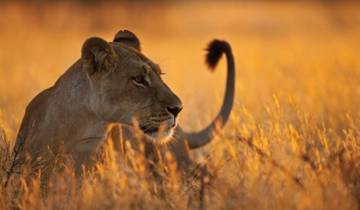
Safari Tarangire, Lac Manyara et Cratère du Ngorongoro - 3 jours/2 nuits
- Dépôt de 5% pour certaines dates Certaines dates de départ vous offrent la possibilité de réserver ce circuit avec un dépôt moins conséquent.
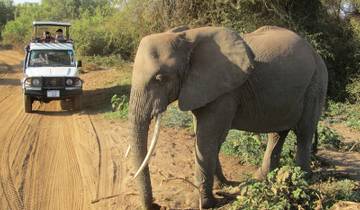
- Randonnée et trek
- Randonnées en montagne
- Explorateur
Kilimandjaro - Lemosho Trek + Extension Safari
- Dépôt de 10% pour certaines dates Certaines dates de départ vous offrent la possibilité de réserver ce circuit avec un dépôt moins conséquent.

- Noël et Nouvel An
Tanzanie indomptée : Safari et culture - 9 jours **Approche durable du voyage

- Jeep et 4x4
Aventure de safari de luxe avec Guépard en Tanzanie**Approche de voyage durable
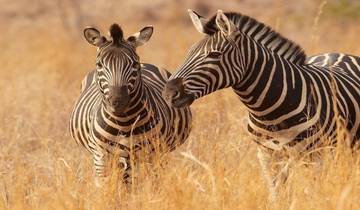
Safari de 4 jours Ngorongoro- manyara- tarangire
Ma famille m'a rejoint après mon Kili Trek et nous sommes allés un safari de 4 jours au cratère de Ngorongoro et au parc national de Serengeti en Tanzanie continentale et 3 jours à Zanzibar KWESA. J'ai contacté professeur le directeur qui a partagé diverses options de safaris sur l'offre et après avoir discuté avec ma femme et mes enfants, nous avons choisi de faire 4 jours dans le continent et 3 jours à Zanzibar. La tournée Safari nous a emmenés au cratère de Ngorongoro qui était à environ 3 heures de route dans un croiseur Toyota Land Hardtop. Ce parc était fantastique et est rempli lions, éléphants, wildebeest, zèbres, hippopotames, flamants roses, babouins, rhinocéros. Il y avait tellement de choses à voir que la journée passait très vite et nous sommes allés à la belle Oldeani Mountain Lodge où nous avons dîné et passé notre nuit. Après le petit déjeuner, nous avons été conduits au parc national de Serengeti par Ndutu et là, il y avait un merveilleux spectacle de milliers de wildebeest, mélangés avec des antilopes et des zèbres avec leurs jeunes veaux. Nous avons eu 2 jours incroyables à Serengeti, avant de partir de Seronera à Zanzibar. À Zanzibar, nous avons été réservés au Matemwe Beach Resort et nous avons apprécié 3 journées amusantes de détente. KWESA a organisé un excellent itinéraire et ma famille en est très reconnaissante. Je les recommande fortement.
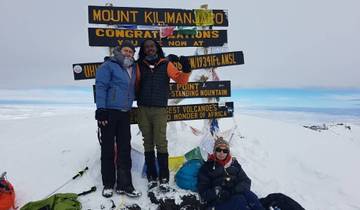
12 jours d'ascension du Mont Kilimandjaro et de safari animalier
Une expédition parfaite avec un grand guide... Je tombe amoureux de la Tanzanie
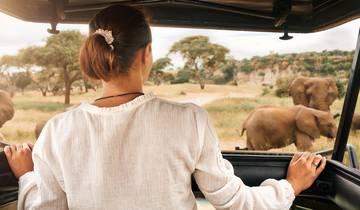
- Aventure active
Safari économique de 3 jours : (Tarangire, Manyara & Ngorongoro)
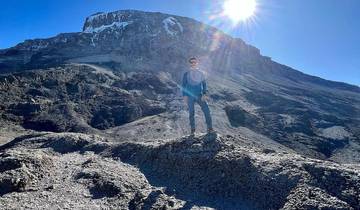
Trekking au Kilimandjaro et safari sur mesure avec option Zanzibar - les vols et l'hébergement peuvent être organisés pour ceux qui souhaitent ajouter cette option.
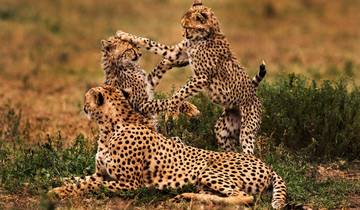
- Photographie de faune et nature
3 jours Tarangire, Ngorongoro Craeter et lac Manyara

3 jours Crater Tour / Lake Manyara / Tarangire National Park

Meilleur safari de 3 jours en camping en Tanzanie au départ d'Arusha à un prix raisonnable.
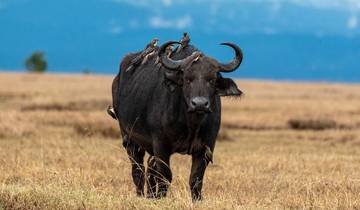
- Aventure pédestre
Parcourez la Tanzanie lors d'un safari
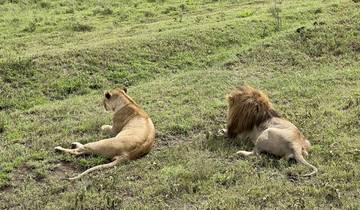
Safari à dos d'éléphant avec activités culturelles
J'ai récemment eu le plaisir d'embarquer pour un safari avec Authentic Africa Travel, et je dois dire que l'expérience a largement dépassé mes attentes. Depuis le moment où j'ai réservé mon voyage jusqu'à l'adieu final, chaque aspect du voyage a été parfaitement organisé et exécuté. L'une des caractéristiques principales d'Authentic Africa Travel est son engagement à fournir des expériences de safari authentiques et immersives. L'organisateur du voyage, Ben, s'est surpassé pour s'assurer que chaque détail était pris en compte et que l'itinéraire était adapté à nos préférences. Son souci du détail et son dévouement à la satisfaction du client ont vraiment rendu le voyage inoubliable. Je tiens également à exprimer ma plus grande gratitude à la directrice, Jesca, dont la passion pour la mise en valeur de la beauté et de la diversité des parcs nationaux de Tanzanie était évidente tout au long du voyage. Son expertise et son hospitalité chaleureuse ont créé une atmosphère accueillante qui nous a permis de nous sentir en famille. Notre guide, Joctan, mérite des éloges particuliers pour sa connaissance approfondie des parcs nationaux du Serengeti, du Ngorongoro et du lac Manyara. Son enthousiasme pour la conservation de la faune et sa capacité à repérer des animaux insaisissables ont ajouté une couche supplémentaire d'excitation à l'expérience du safari. Le professionnalisme, la patience et l'amabilité de Joctan ont véritablement enrichi notre aventure et laissé une impression durable. Explorer les vastes plaines du Serengeti, admirer les paysages à couper le souffle du cratère du Ngorongoro et s'émerveiller de la diversité de la faune dans le parc national du lac Manyara ont été des moments inoubliables que je chérirai à jamais. L'engagement d'Authentic Africa Travel à créer des expériences de safari mémorables et authentiques est vraiment louable. Je recommande vivement Authentic Africa Travel à tous ceux qui recherchent une aventure personnalisée et enrichissante en Tanzanie. Merci à Ben, Jesca, Joctan et à toute l'équipe d'avoir fait de ce safari une expérience unique qui restera à jamais gravée dans mon cœur.

Safari de 5 jours Tarangire - Manyara - Ngorongoro
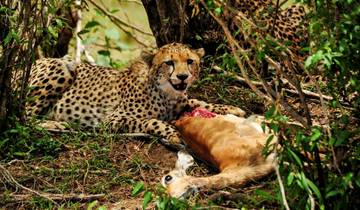
3 jours de safari en Lodge en Tanzanie
Styles de voyage, autres régions à tanzanie.
- Circuit nord de la Tanzanie (1782)
- Mont Kilimandjaro (694)
- Parc national du Ngorongoro (173)
- Parc national du Serengeti (161)
- Zanzibar (104)
- Mont Meru (83)
- Circuit sud de la Tanzanie (51)
- Réserve de Selous (50)
- Parc national de Mikumi (37)
- Parc national de Ruaha (12)
- Ouest de la Tanzanie (5)
Circuits Éléphant
- Faune (125)
- Big Five (49)
- Grande migration (23)
- Éléphant (5)
Autres types à Parc national du Tarangire
- Économique (13)
- Famille (179)
- Groupe (155)
- Noël et Nouvel An (144)
- Entièrement guidé (142)
- Faune (133)
- Personnalisé (78)
- Big Five (55)
- Partiellement guidé (49)
- Jeep et 4x4 (37)
- Aventure active (36)
- Explorateur (31)
- Camping (10)
Discover TourRadar
- Voir tous les voyagistes à Parc national du Tarangire
- Puerto Inca tours
- Nord-Ouest Johannesburg tours
- Circuit en petit groupe de 2 jours à Stratford- upon- Avon, Oxford et les Cotswolds au départ de Bristol
- Boutique Inde du Sud
- Les offres de voyage du Black Friday seront de retour en 2024 !
- Antarctique / Pôle Sud Décembre 2024 tours
- Trek pédestre à l'auberge d'Asheville

Tarangire National Park: Everything You Need to Know
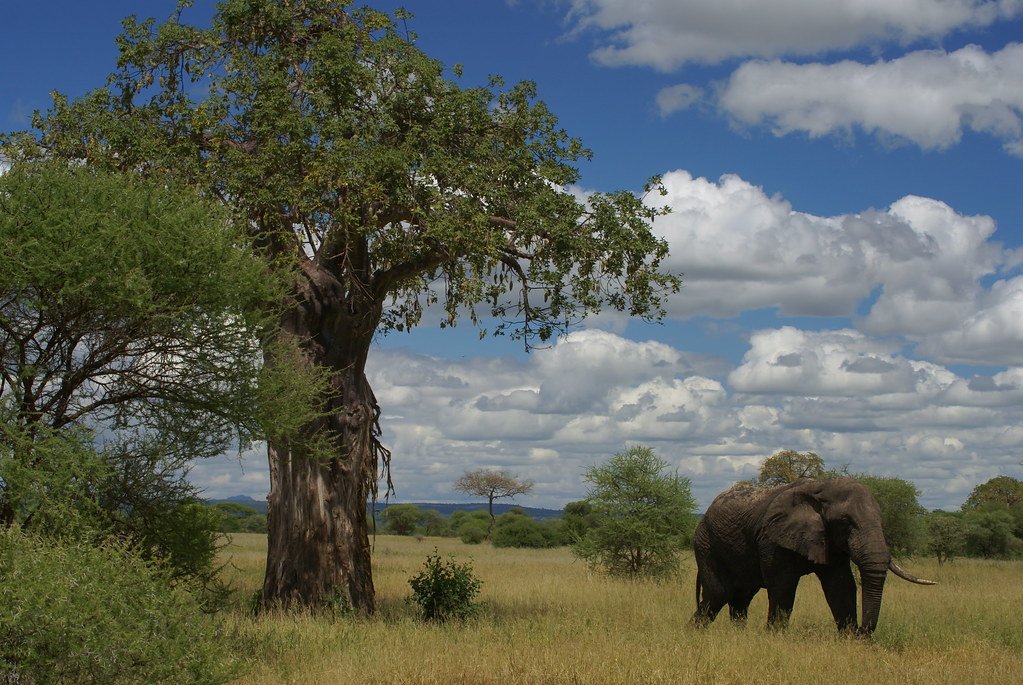
While Serengeti gets all the press, Tarangire is another jewel in the Northern Tanzania Circuit. Surrounded by Maasai Steppes and the Lakes of the Great Rift Valley, it has sprawling grasslands dotted with majestic Baobabs, swamps, woodlands, and charming hills. The river Tarangire that flows through it throughout the year attracts herds of elephants, wildebeests, buffalos, and many other species along with flocks of birds.
Especially during the dry season spotting wildlife will be quite easy as vegetation will be dried up which will improve visibility and an abundance of animals could be found near water bodies.
Who do we recommend this park for?
We recommend Tarangire for almost everyone interested in wildlife and at any time of the year!
With an area of about 3000 sq km, Tarangire provides a great opportunity to go on long game drives or take an adventurous walking tour and discover a variety of habitats with their unique geographical and biological makeups.
Huge baobabs & large elephant herds are the major highlights of Tarangire while it also hosts a good population of lions and great destination for birding year round. You will find several scenic view points across the park that offer great views of its diverse terrain and scenery.
In the Dry season (Jun to Oct), Tarangire river remains the only source of water in the region and the wildlife migrates from surrounding wilderness areas into the Tarangire national park. You will find a large number of elephants, wildebeests, zebras, hartebeests, gazelles, and buffaloes along with lions, leopards, hyenas and other predators.
In the Wet season (Nov to May), Wildlife sightings are still decent. You can still find elephant herds, most of the predators and many herbivores, though not as great in number as in dry season. This season however attracts many migratory species of birds making it the best destination for birding in North Tanzania. Also the scenery is lush and the park is less crowded making the game drives here a very enjoyable experience.
Tarangire is also the best destination for doing night game drives across all Northern circuit parks in Tanzania (only other option being at Lake Manyara NP).
Located just around 2 hours from Arusha airport, Tarangire is a convenient option to visit from Arusha on short trips.
We recommend clients to spend 2-3 days in the Dry season and 1-2 days in Wet season at Tarangire.
Contents 1. Wildlife and Vegetation 2. Birds 4. Things to Do 5. Locations to Visit Inside the Park 6. Climate 7. When to Visit 8. Location and How to Reach Tarangire 9. Accommodations 10. Fee Structure 11. Should I Visit Tarangire? 12. Safari Tours to Tarangire 13. Frequently Asked Questions
Wildlife and Vegetation in Tarangire
Tarangire’s biggest attractions are the large herds of elephants. During the summer season, Elephants are drawn to the river and the swamps of Tarangire, where they can wallow in mud and enjoy a cool bath to refresh themselves or graze on the grass nearby. Or they might be found near the Baobab and Acacia trees, enjoying the cool shade or snacking on juicy fruits, tree barks, and crunchy leaves. You’ll find elephants of all sizes, from cute little babies to imposing matriarchs.
Tarangire is also home to three more of the Big Five species: Lions, Buffalos, and Leopards. Lions and Buffalos will be very easily spotted. It is actually quite rare not to find them. Lions will be seen prowling about or lazing around under the shadow of the trees or you might even find a Lion resting in the branches tree! Buffalos will also be found taking a quick nap under the shade or grazing on the grass. Leopards on the other hand will be tricky to spot. They are amazing at camouflage and become invisible in the woodlands. If you are very lucky you might be able to spot one resting on the rocks.
Wildlife enthusiasts also visit Tarangire to spot the rare fringe-eared Oryx and long-necked Gerenuk. They can be seen grazing in the grassy plains.
Besides these, you will easily spot ungulates like giraffes, zebras, wildebeests, and hartebeests. Hippos can be found wallowing and grunting in the marshy pools. You might find a large python coiled up in the trees, sitting really still. You might also spot troops of baboons engaged in mischief or come across a group of Vervet monkeys having a fun time trying to steal items from you.
When it comes to vegetation Tarangire is most commonly known for its remarkable Baobab trees, but its vegetation is much more diverse than that. The arid region can also support Candelabras, Sausage trees, and aquatic forests like the woodlands of different species of Acacia that have flowing streams.
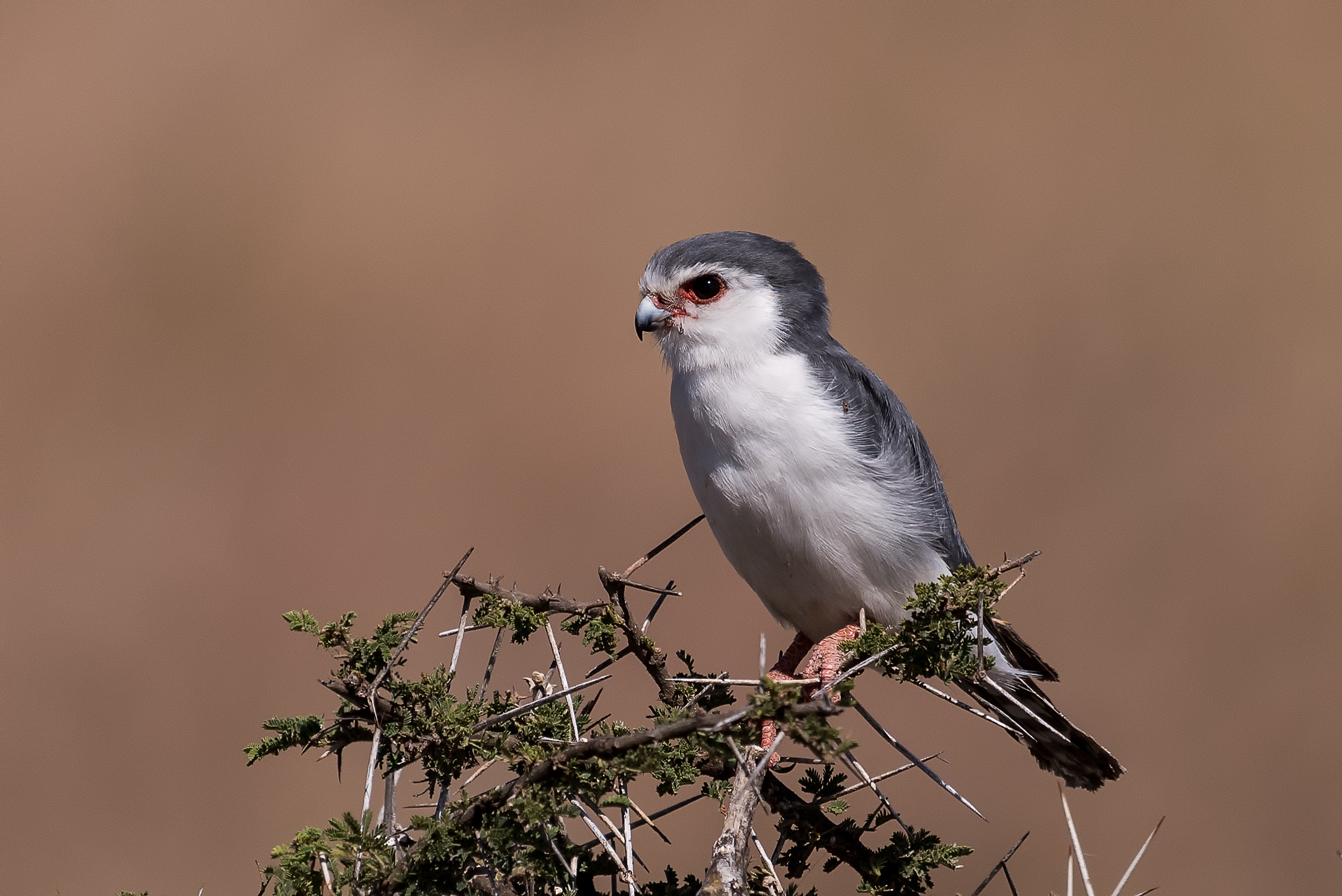
Birds in Tarangire
If you are a bird lover then Tarangire is one of the best spots for you in Tanzania. With a count of 550 species, the park has the highest concentration of bird species in Tanzania.
In the drier sections of the park with open savannas, you will find kori bustards, the heaviest flying birds, and ostriches, along with flocks of hornbills. The woodlands of Tarangire house beautiful Hoopoes, Brown parrots and many more. Barbets, swallows, starlings, swifts, lilac breasted rollers are common inside the park. Park also provides a haven for migratory birds coming from Europe and Asia. Water birds, land birds, and raptors travel to Tarangire and breed there. These include birds like Cranes, Ibises, hawks, falcons, cuckoos, and turtle doves. Tarangire boasts over 50 species of birds of prey! From cute but dangerous Pygmy falcons to big Lappet-faced Vultures!
Besides them, Tarangire also protects the endangered bird species of Rufous-tailed weavers, yellow-collared lovebirds, and ashy starlings.
The list of birds found there is really long!

Things to Do
Full-day game drives are the most common activity at Tarangire. You will be driven around the park in a 4x4 vehicle by your guide to explore the woodlands, grasslands, floodplains, and hills hosting their flora and fauna. Apart from game drives during the day, you can consider below additional activities:
Night game drives : Night game drives at Tarangire are done by a select few accommodations in/around the park and not by tour operators. A night game drive will be very different from a day game drive. Besides looking for nocturnal critters and listening to their sounds you will have a great view of the African night sky and admire all the stars. The feeling of being alone in the bush at night is quite unique. Some of the animals you might come across on night game drives inside the park are genet cat, african wild cat, bush babies, birds, black eared foxes and spring hares and if your lucky you might come across a lion or may be even a leopard. Wildlife sightings on night game drives outside the park are less frequent. To do a night game drive inside Tarangire, you need to stay at select accommodations inside or bordering the park and book this activity as an add-on. Service fees ranges between $100-150 per client depending on accommodation and a night permit fees of $59 will be charged on top.
Walking safari : You can also go on a walking safari to get a different perspective of the park. You might notice the little things that you couldn’t notice from your vehicles. You will be looking for tracks left by animals such as elephants and wild cats with the help of your guide. You will also notice little insects like the dung beetles and ant lions that are an important part of the ecosystems. Since there would be no noise created by the vehicle the sounds of the wild would also become more prominent. However, it is better to do this activity during the dry season as it won’t be muddy and there will be fewer tsetse flies to worry about. We offer walking tours inside Tarangire at $45 per person for 3-4 hours or at $60 per person for 5-6 hours walking tour.
Balloon Safari also takes place in Tarangire. It starts early in the morning around sunrise. The aerial perspective from the balloon gives you stunning views of the topographies of the park. Balloon safari costs $520 per person in Tarangire.
Maasai village visit Close to Tarangire, there are maasai villages that you can visit. These are a bit less commercialized than the the Maasai village tours that happen at Ngorongoro crater. You are expected to tip about $25 to the maasai village head at the end of your village tour.
Locations to Visit Inside The Park
There are multiple interesting locations to explore in the park.
Silale swamp is a scenic location to visit. During the wet season, the swamp soaks in all the water which then spreads into other areas of the park during the dry season. For the most part of the year, it is green, and the water in this area attracts large elephant herds and a lot of herbivores during the dry season, which in turn lures the carnivores such as lions and wild dogs. If you are lucky you can even spot the rare antelopes like greater kudu or oryx or eland in this region. So this is a good spot to look for wild animals while taking in the scenery.
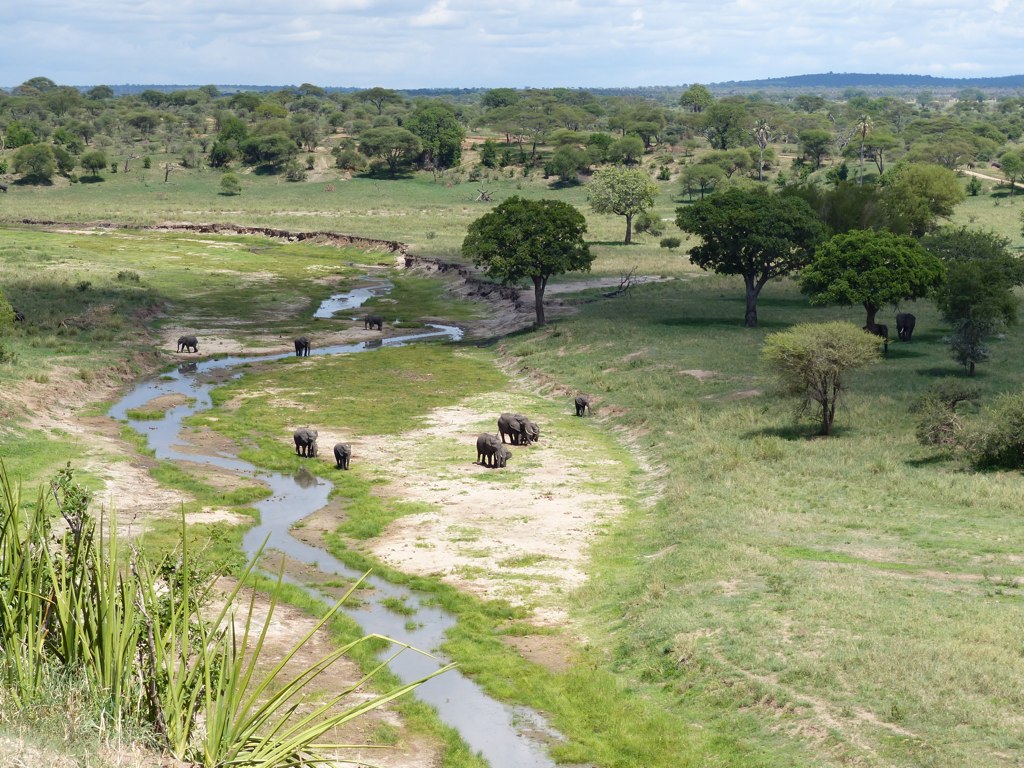
If you are in Tarangire for the fringe-eared oryx, then Matete woodland within the park is for you. The region is covered in Acacia trees, tall elephant grass, and reeds, and the Oryx is often seen here. This area is also considered a good spot for finding Leopards. The cat is elusive and will be difficult to spot of course, but leopards prefer woodlands more so you can try to look for it in the branches of Acacia here.
If you are interested in birds of prey, Lemiyon Triangle might be the spot for you. The area has enormous Baobabs that lean over the road here, and the raptors and other birds of prey can be seen sitting in the branches or swishing about nearby.
Kitibong hill is another scenic location inside the park. With the hill in the backdrop and the grassy plains in front of it, the view is stunning. This place is preferred by wild buffalos, so if you are a fan of the helmet heads you should try exploring this region. You might find herds of buffalos and other small herbivores as well.
Weather and Climate of Tarangire
The climate of Tarangire is moderate throughout the year. Although it does get quite cold in the morning and at night.
Tarangire experiences wet season from November to May, and dry season from June to October.
During the wet season, the temperature goes as high as 28°C / 82°F and goes down to 16°C / 61°F at night.
During the dry season, the temperature is around 26°C / 79°F. And at night it drops down to about 14°C / 57°F.
When to Visit Tarangire?
We recommend Tarangire throughout the year!
Huge baobabs & large elephant herds, good population of lions and great diversity of birds can be seen throughout the year.
In the Dry season (Jun to Oct), Tarangire river remains the only source of water in the region and the wildlife migrates from surrounding wilderness areas into the Tarangire national park. You will find a large number of elephants, wildebeests, zebras, hartebeests, gazelles, and buffaloes along with lions, leopards, hyenas and other predators. Tsetse flies will also be less bothersome. We recommend spending 2-3 days at Tarangire in the dry season.
In Wet season (Nov to May), Wildlife sightings are still decent. You can still find elephants, predators and several species of herbivores, though in fewer numbers than in dry season. This season attracts migratory birds making it the best destination for birding in North Tanzania. The scenery is lush and the park is far less crowded. So you have few other vehicles (or none) at each sighting. However, there can be Tsetse flies so you will have to be extra careful or avoid the areas where these flies are a concern. We recommend spending 1-2 days at Tarangire in wet season.
Location and how to reach Tarangire
Tarangire is a part of the northern circuit and is located just south of Lake Manyara so it is well located among Northern circuit parks.
Most common way to get to Tarangire is by road from Arusha and it takes about 2 hours from Arusha airport to Tarangire gate.
Tarangire is about 45 min drive away from Manyara and 2 hours drive away from Ngorongoro conservation area gate. From Central Serengeti, Tarangire is nearly 5.5 hours drive.
Accommodations at Tarangire National park
A wide selection of accommodation options ranging from basic camping to luxury lodges is available for you to choose from. Some of these accommodations are inside while some bordering the park, located in the surrounding wilderness areas. Most of the accommodations located inside are in wildlife rich areas and they let you start game drives soon after you exit from the premises. Most of the accommodations located outside are in wilderness management areas and wildlife does come close to many of these lodges in the evenings. These lodges can be anywhere from 5 min to 30 min from nearest entry gate to Tarangire.
If you are on a budget and visiting Tarangire only for a day before proceeding to other parks, you can also choose to stay at hotels in Mto Wa Mbu village which is about 45 min from Tarangire (towards Manyara/Ngorongoro/Serengeti) or at Karatu town, which is about 90 min from Tarangire gate and in the direction of Ngorongoro and Serengeti. So for clients going to these parks after Tarangire or coming from these parks to Tarangire, Karatu or Mto Wa Mbu accommodations could be a decent choice.
But if your budget allows, we recommend you to consider staying inside the park or just outside the park as these offer closer to wilderness experience and provides quick access to park than the ones located at Mto Wa Mbu or Karatu.
Below are the popular accommodations we use in and around Tarangire.
Prices are on full board basis, per person per night for double sharing and include taxes but do not include applicable statutory fees like Wilderness management area fees (USD 30 per person per night) for accommodations located outside Tarangire or concession fees/special campsite fees (USD 59 per person per night) for accommodations located inside Tarangire.
Prices mentioned indicate rough price range from low season to high season.
Accommodations located outside Tarangire (In Wilderness areas around Tarangire)
Burunge Tented Lodge: USD 80 to 120
Sangaiwe Tented Lodge: USD 100 to 130
Tarangire Osupuko Lodge: USD 100 to 130
Tarangire Simba Lodge: USD 100 to 160
Maramboi Tented Lodge: USD 160 to 200
Boundary Hill Lodge: USD 160 to 200
Nimali Tarangire Camp: USD 390 to 510
Wilderness management area fees of USD 30 per person per night applies for the above accommodations.
Accommodations located Inside the park
Ang'ata Tarangire Camp: USD 160 to 200
Baobab Tented Camp: USD 170 to 210
Tarangire Tortilis Camp: USD 110 to 220
Acacia Tarangire Luxury Camp: USD 160 to 230
Tarangire Ndovu Tented Lodge: USD 200 to 270
Nyikani Tarangire Camp: USD 170 to 270
Topguide Bush Camp Lolkisale: USD 340 to 520
Tarangire Kuro Treetops Lodge: USD 420 to 630
Lemala Mpingo Ridge: USD 480 to 870
Sanctuary Swala Camp: USD 890 to 1260
Concession fees/special campsite fees of USD 59 per person per night applies for above accommodations
Fees Structure
The entry fee for Tarangire depends on the visitor's nationality and age. For foreigners, the park fee is $59 per adult per day. This park fee is valid for 24 hours. However, you must note that the park fees will also expire if you step out of the park before completing 24 hours.
If your accommodation is inside Tarangire, then a concession fee of $59 per adult per night will apply. If you are doing night game drives, permit fees of $59 per adult will also apply on top of the service fees charged by accommodations for night game drives.
Should I Visit Tarangire?
Tarangire might not be as big as Serengeti or have the interesting geological history of Ngorongoro, but it has its own perks to offer in the form of huge elephant herds, Baobabs, a great density of wildlife and birdlife, and scenic locations. We recommend Tarangire for most clients visiting Northern Tanzania, throughout the year.
A significant number of clients tell us that they enjoyed Tarangire even more than Ngorongoro crater! And some of our regular clients who have seen all the parks, ask for visiting only Serengeti (Central Serengeti + Migration location in Serengeti) and Tarangire and skip other parks.
In Dry season(Jun to Oct), Tarangire is strongly recommended. Wildlife sightings around the river are frequent and if you are short on time or budget for visiting Serengeti then Tarangire would be the next best option. Or if you have time to visit more parks than just Serengeti or interested in seeing large elephant herds,variety of birds, beautiful and diverse scenery from what Serengeti offers than Tarangire is great addition to your itinerary.
If you are visiting in the wet season(Nov to May), wildlife density can be a bit lower but there are good reasons to visit. The whole park looks green and lush, baobabs will be bearing new leaves (they look dry and leafless in dry season), river looks beautiful with good waterlevels and you still see plenty of wildlife including large elephant herds and big cats, even in wet season. For birds, there is no better place/time to visit in North Tanzania than Tarangire in wet season. However, towards the end of wet season (April/May) when the rains are at their peak and the grass the tallest, wildlife sightings become harder in the park. But you can still see elephants, some wildlife. If you are lucky and a bit patient to actively look for wildlife you might still see quite a bit of wildlife even during April/May. Great number of birds are seen throughout the wet season.
Safari Tours to Tarangire
We offer various itineraries that include safari tours to Tarangire National Park. To view some of our popular tours, click here .
Frequently Asked Questions
How many days do you suggest for Tarangire during the dry season?
In the dry season, we would recommend two full days of safari. For those who are bird watchers, we would also recommend a third day so they have time to explore all the corners of the park. But if you are short on time, even a one day safari at Tarangire would be a decent option. But you may not be able to explore till the southern reaches of the park with just 1 day.
How many days do you suggest for Tarangire during the wet season?
For clients visiting the park during the wet season we would recommend spending one day at the park. But if you are a bird watcher, we recommend spending 2 days here even during the wet season.
If I have only 1 day at Tarangire, then where do I go for game drives?
Within one day you will be able to visit the important spots like the Tarangire river, swamps, the woodlands, mostly located in the Northern part of the park but it will be a little rushed and also a bit crowded. We would also recommend you to start as early in the morning as possible for game drives and to choose an accommodation inside Tarangire so you get more time in the park.
Depending on the animals, habitats you want to see and time you have, your guide will suggest the best route for the day.
Which sections of the park can I explore on day 2 at Tarangire?
If you have 2 days at Tarangire, then on day one you can choose to cover the northern part of the river, visit the matete woodlands, and the northern and the central part of the park.
On day two you can explore the southern part of the park including Kitibong Hill. This area is not frequently visited so you will find very little crowds. The game drive will be able to go at a slower, more relaxed pace with a second day at hand.
Difference between the night game drive inside Tarangire vs outside?
Night game drives are offered by lodges at Tarangire. The ones located outside the park offer night game drives outside, and the ones located inside the park offer night game drives inside. Night game drives experience inside is significantly better than outside. Outside the park, you will be driving close to communities of people and wildlife won't be seen much and maybe you will find a few antelopes.
Inside the park, there will be no disturbance from human activities at all. You will be surrounded by complete wilderness and have a much greater opportunity of coming across nocturnal creatures.
Advantages of selecting accommodation inside Tarangire for an overnight stay?
Staying at accommodations inside the parks gives you the opportunity to book night game drives(if it's offered by that accommodation) inside the park. Further, if you are staying inside you will be able to spend more time in the wilderness. Most of the lodges are located in the areas where there is a good concentration of wildlife. So you’ll spot animals as soon as you start driving or maybe even from your windows. An antelope or two might accompany you while you are on your way to the dining area. And at night you will be able to hear the sounds of the animals and birds. A roar of a lion or a cry of a hyena. There will be a closer interaction with nature.
By staying inside, you can start game drives right at 6:00 AM after you leave your camp/lodge. You can return to the lodge for breakfast/lunch and have a hot lunch at your camp/lodge. Clients staying outside usually don’t have the option of returning to accommodation for hot lunch as park fees will expire when they exit from the park gate. So to reenter the park after lunch, extra park fees need to be paid.
If you are staying outside even if the park gates are only 5-10 min away, these gates in turn might be located a bit far from the areas that have good wildlife concentration. Plus you will be spending 15 minutes at the gate because of the paperwork as well. You won’t have to face this if you are staying inside the park.
How to deal with the tsetse flies? Which season is best for avoiding them? Which area should be avoided?
Tsetse flies are mostly in the bushy areas so you should stay away from them if you want to avoid the tsetse. Lodges are located away from the bushy areas as well. Tsetse flies are also attracted to black and blue so avoid wearing such colors, and we also recommend wearing clothes that cover you properly.
Tsetse flies are more active in hotter weather, so they will not be active in the early morning or at night as it is cold. But you will have to deal with them during the day when it gets hotter. They are also bound to increase during the rainy season. If you are visiting Tarangire then, besides wearing proper clothes we also recommend keeping a bug repellant.
Lodges have their own systems to avoid Tsetse flies. They have blue or black covered flags with poison or sterilizing elements on them that attracts the flies and prevents them from breeding.
Which accommodations offer night game drives in Tarangire?
While at Tarangire, night game drives offer a unique experience, a chance to get close to nocturnal species as they get on with their nightly rituals. Night game drives are arranged by accommodations only (and not by tour operators), so if you are considering doing this, it is required that you stay at an accommodation that offers night game drives. Accommodations located inside park arrange night game drives inside the park, while accommodations located outside arrange the activity outside the park. We recommend night game drives inside the park over outside.
Few accommodations inside the park that can arrange night game drives: 1. Ang’ata Tarangire Camp 2. Tarangire Baobab Tented Camp 3. Tarangire Safari Lodge 4. Tarangire Ndovu Tented Lodge 5. Lemala Mpingo Ridge 6. Sanctuary Swala
Some Accommodations outside the park that arrange night game drives:
- Boundary Hill Lodge
- Osupuko Lodge
- Kirurumu Tarangire Lodge
- Nimali Tarangire Camp
- Elewana Tarangire tree tops
There are more accommodation options both inside and outside the park that can arrange night game drives at Tarangire.
For help, support or advice for your upcoming adventures!
Request Quote
- Great Migration in Serengeti in 2024/2025 - What, When, Where & How much?
- Tanzanian Paradise: Zanzibar, Pemba, and Mafia Islands
- How many days for Tanzania tour?
- Things to do in Serengeti - on top of classic game drives
- How To Book a Safari Tour with Monkey Adventures
- Security Concerns in Tanzania
- Tanzania Parks - Ratings & Reviews
- Ndutu: Everything You Need to Know
- Tanzania Safari Costs - From $150 to $1500 per day
- Central Serengeti: Everything You Need to Know
- Northern Serengeti: Everything You Need to Know
- Lake Manyara National Park: Everything You Need to Know
- Western Serengeti: Everything You Need to Know
- Lake Eyasi: Everything You Need to Know
- Lake Natron: Everything You Need to Know
- Activities at Lake Manyara
- A Guide to Tanzania Safari with Kids
- Guide To Our Safari Accommodation Classification System
- How basic camping Safaris Work?
- Arusha National Park: Everything You Need to Know
- Tanzania Safari in January
- Serengeti Migration Safari Guide
- Tanzania Safari Circuits: Explore Northern, Southern, Western & Coastal Gems!
- Activities to Enjoy: Lake Bunyoni's Adventures and Natural Wonders
- Activities in Bwindi: Exploring Nature, Culture, and Conservation
- Explore the Wonders of Ngorongoro: Must-Do Activities
- How to Plan A Safari in Tanzania - In 15 easy steps
- Lake Natron Activities: Hiking, Birding, and Cultural Encounters
- How to get to Serengeti
- Ngorongoro Conservation Area: Everything You Need to Know
- 5 Types of Tanzania Safari Accommodations: Where to Stay?
- Activities to Enjoy: Exploring Queen Elizabeth National Park in Uganda
- tarangirenationalpark
- Africansafari
- Tanzaniasafari
- treeclimbinglion
- wildlife tour
- nationalpark
Prêts pour une expérience unique? Twalo - Voyage Ethiopie Voyage Kenya Voyage Ouganda Voyage Rwanda
Un service sur mesure [email protected]

Le Parc National de Tarangire
Accueil » Le Parc National de Tarangire

Mis à jour le 3 avril 2023
Aujourd’hui, nous vous emmenons à la découverte du Parc National de Tarangire. S’il ne fait pas partie des plus fréquentés, il figure pourtant parmi les parcs de Tanzanie qui offrent les meilleurs safaris. On dit même qu’il s’agit du paradis des éléphants ! Dans ce guide, on vous dit tout sur ce trésor méconnu. C’est parti, direction le Nord de la Tanzanie !
Le parc de Tarangire en quelques lignes
Le Tarangire a obtenu le statut officiel de parc national en 1970. Il tient son nom de la rivière Tarangire qui le traverse.
La richesse de sa faune en fait l’égal des parcs tanzaniens les plus célèbres comme le Serengeti et le cratère du Ngorongoro . Il est pourtant bien moins fréquenté que ces parcs voisins, mais c’est bien là son atout ! Un safari dans le Parc National de Tarangire, c’est la promesse d’une aventure loin de la foule, en toute tranquillité.
Cette exclusivité est également renforcée par la surprenante étendue du parc. Il fait environ 10 fois la taille du Parc National de Manyara !
Que voir dans le Parc National de Tarangire ?
Le Tarangire est réputé pour sa concentration d’éléphants, ses baobabs, ainsi que pour sa petite migration. Une étape dans le parc est hautement recommandée lors d’un safari en Tanzanie .
Quels animaux voir dans le Tarangire ?

Les animaux les plus représentés dans le parc de Tarangire sont les pachydermes. On estime qu’entre 2500 à 3000 éléphants y sont présents en haute saison ! C’est donc sans conteste le parc tanzanien à privilégier si vous souhaitez voir ces grands mammifères.
Le Tarangire est également le lieu rêvé pour l’observation des lions et d’autres prédateurs tels que les léopards , guépards et lycaons .
Le buffle est également présent dans le parc. On compte donc 4 des Big Five (seul le rhinocéros est absent).
Girafes , zèbres , gnous , koudous , élands et bien d’autres petits herbivores sont aussi présents dans le parc.
Sachez également que le Tarangire est l’une des meilleures destinations de Tanzanie pour l’observation des oiseaux . Plus de 500 espèces différentes sont recensées chaque année !
Les baobabs de Tarangire
L’environnement du Parc National de Tarangire est très riche. Au Sud, on retrouve des zones marécageuses. Dans le reste du parc, le paysage est composé de collines et de savanes dorées, parsemées de baobabs. Cet arbre est mythique en Afrique, il est d’ailleurs considéré comme sacré !
Sachez que les baobabs que vous verrez dans le parc ont au moins mille ans chacun. Impressionnant n’est-ce pas ? Leur place est essentielle dans l’écosystème de Tarangire. Leurs graines sont une source de nourriture pour beaucoup d’animaux. De plus, quand l’eau vient à manquer, les oiseaux, les lézards, mais aussi les éléphants, peuvent s’hydrater en consommant leur écorce.
Le baobab donne au Tarangire son caractère exceptionnel car cet arbre n’est pas commun dans le reste de la Tanzanie.

Safari dans le Parc National de Tarangire
Pour votre safari au Tarangire National Park , nous vous recommandons vivement la compagnie d’un guide. Faire appel à un professionnel du bush est la meilleure façon de maximiser vos chances de voir les habitants du parc. Votre guide pistera les animaux tout en partageant avec vous ses connaissances sur la faune et la flore locales. Il assurera également votre sécurité lors des safaris.

Voici un petit lexique afin de vous préparer à votre safari en Tanzanie.
- Game Drive : Un grand classique ! « Game drive » est le nom donné aux sorties en 4×4 pour l’observation des animaux.
- Sunrise Drive : Game Drive qui se déroule au lever du soleil, moment idéal pour observer les félins
- Sunset Drive : cette sortie a lieu lors du coucher du soleil. C’est le meilleur moment de la journée pour observer les animaux, car c’est quand les températures descendent qu’ils sortent de leur sieste.
- Night Drive : un safari sous un magnifique ciel étoilé. C’est souvent l’occasion d’assister à des chasses.
- Walking Safari : un safari à pied où vous ferez corps avec la nature. Vous pourrez vous approcher plus près des animaux, découvrir les petites espèces et la flore. Cette activité est proposée par certains lodges. Contactez-nous pour obtenir plus d’informations.
La petite migration

C’est entre juin et octobre, lors de la saison sèche, que se déroulent les phénomènes migratoires dans le Tarangire. La localisation du parc, au nord de la Tanzanie, en fait le théâtre d’une migration en provenance des régions du lac Manyara et du cratère de Ngorongoro.
Lorsque de la sécheresse est à son comble, les mammifères étendent leur territoire jusqu’au Tarangire pour y chercher de l’eau. Leur point de rassemblement ? Les abords de la rivière Tarangire où ils peuvent s’abreuver.
Retenez-donc que la rivière est le point le plus stratégique pour observer les animaux lors de la petite migration.
Bien sûr, ce mouvement migratoire est moins important que la Grande migration du Serengeti. Mais c’est l’occasion de voir encore plus de troupeaux d’éléphants, de gnous et de zèbres que d’ordinaire.
En vous rendant à Tarangire à cette saison, vous apercevrez également de nombreux prédateurs. Eh oui, ces derniers ne restent jamais loin de leurs proies !

Questions pratiques pour un safari à Tarangire
Où loger dans le parc national du tarangire .
A l’intérieur du parc, la majorité des hébergements sont des lodges de grande qualité.
Parmi nos coups de cœur, trois établissements aux charmes différents :
- Tarangire Treetops : ce lodge de luxe offre des chambres spacieuses, perchées dans les arbres. Un cadre magnifique, unique et intime
- Tarangire River Camp : on aime ce camp pour son emplacement surplombant la rivière et ses tentes confortables, au cœur de la nature
- Tarangire Simba Lodge : plus abordable, ce lodge offre également la possibilité de dormir sous une tente de safari
Pour les budgets retreints, nous vous conseillons d’opter pour le camping. Les aires de camping du parc sont gérées par Tanzania National Parks (ou TANAPA) et sont équipées de sanitaires.
Pensez également à sortir des frontières du parc, vous y trouverez des hébergements plus abordables.
Le parc est-il facile d’accès ?
Le Tarangire est très facilement accessible depuis les autres parcs nationaux du pays. Ainsi, il est aisé d’y faire étape pendant un safari en Tanzanie.
Concrètement, le Tarangire est situé à seulement :
- 1h00 de route du Parc National du lac Manyara
- 2h00 de la zone de conservation de Ngorongoro
- 2h30 d’ Arusha .
- 4h00 du Parc National du Serengeti
Pour une idée d’itinéraire, découvrez notre séjour 100% personnalisable Le meilleur du safari en Tanzanie .
Quelle est la meilleure période pour découvrir le Parc National de Tarangire ?
La Tanzanie, située dans l’hémisphère Sud, a un climat opposé à celui de l’Europe. Ainsi, les températures les plus élevées sont enregistrées autour des mois de décembre/janvier, et les plus basses aux environs des mois de juillet/août.
Mais ne vous fiez pas aux températures pour définir vos dates de voyage. Car la période la plus fraiche, qui correspondent à la saison sèche, est le meilleur moment pour visiter le Parc National de Tarangire. Nous vous recommandons donc de découvrir le parc entre juillet et octobre . C’est alors la petite migration, et le moment où le parc accueille un nombre record d’animaux.
Les journées y sont très agréables, seules les nuits peuvent être fraiches. Emportez donc une petite laine !
Les mois de novembre-décembre marquent la petite saison des pluies. Les précipitations ont principalement lieu en fin d’après-midi. Les températures remontent et le climat est assez humide.
De janvier à mars , les pluies s’estompent et les températures remontent pour frôler les 30°C. Le manque d’eau pousse les animaux à se regrouper autour de la rivière, offrant aux visiteurs de magnifiques scènes sauvages !
Enfin, la grande saison des pluies a lieu entre avril et juin, générant des précipitations abondantes. A cette saison, la majorité des animaux quitte le parc pour rejoindre la région de la vallée du Rift et la Steppe Masai. C’est le moment pour apprécier la tranquillité des lieux et la végétation luxuriante. En revanche, cette saison n’est pas adapté aux safaris.
Pour vous aider à choisir vos dates pour votre voyage en Tanzanie, et en savoir plus sur la météo sur place, consultez notre article dédié au climat en Tanzanie .
Un safari à Tarangire vous tente ? Nous pouvons l’organiser pour vous ! Contactez dès maintenant nos agents de voyage en cliquant ici .

Foire aux questions
Si vous êtes pressé, vous pourrez voir l’essentiel du parc de Tarangire en une journée. Consacrez là à un safari, cela vous permettra d’avoir un bon aperçu de la faune de la région. Mais pour en profiter au maximum, n’hésitez pas à prolonger votre séjour d’un jour ou deux.
Les frais d’entrée pour le parc de Tarangire sont de 45€ par jour pour un adulte, et de 15 € par jour par enfant. L’entrée est gratuite pour les moins de 5 ans.

Autres articles dans la même thématique

Assistez à la Grande Migration dans la région de Ndutu

Vivez un safari exceptionnel à bord d’une montgolfière en Tanzanie

Un voyage inoubliable au lac Eyasi, entre culture et safari
Postez un commentaire cancel reply.
Enregistrer mon nom, adresse mail, et le site dans ce navigateur pour mon prochain commentaire.

Safari dans le Parc national de Tarangire
Voyage à tarangire, le parc aux paysages typiquement africains.
Tarangire National Park est magnifique et injustement méconnu, avec des paysages très différents des autres parcs de Tanzanie grâce à ses baobabs qui apportent une ambiance particulière. En saison sèche, de nombreux animaux migrent depuis Manyara et les contreforts du Ngorongoro pour se rassembler autour de la rivière Tarangire.
Type : parc national Surface : 1 360 km2 Durée conseillée : 1 à 3 nuits
Rwanda
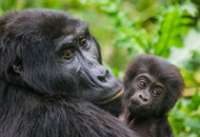
Ethiopie
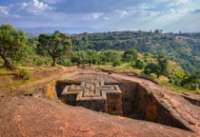
Kenya
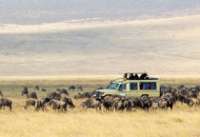
Zambie
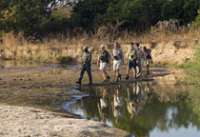
Tanzanie

Botswana
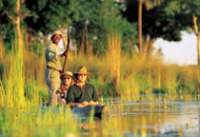
Inde
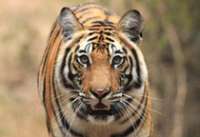
Norvège
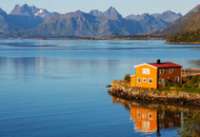
Finlande
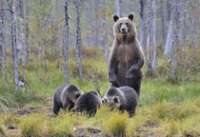
Equateur
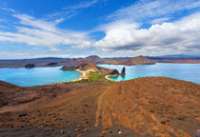
Mozambique
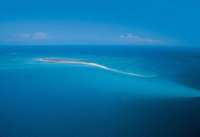
Antarctique

Ouganda
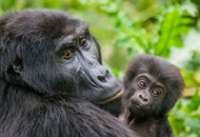
Congo
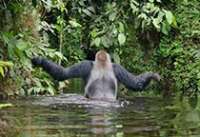
Zuri Zanzibar
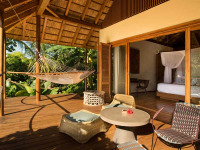
Donnant sur la plus belle plage de Zanzibar au Nord-Ouest de l’île, cette enclave luxueuse vous offre confort, élégance et bien-être. Niché entre les arbres tropicaux et une longue plage de sable fin, le Zuri Zanzibar est un véritable coup de cœur, ...
Elewana Kilindi Zanzibar
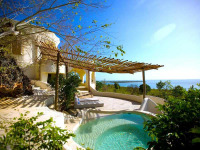
Vous serez séduit par le charme et l’élégance du Elewana Kilindi Zanzibar , un hôtel de luxe situé sur la côte Nord-Ouest de Zanzibar. Face à l’Océan Indien, séjournez dans un pavillon à l’architecture atypique et ...
andBeyond Mnemba Island
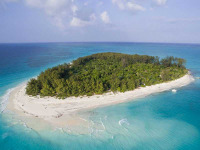
Cette luxueuse enclave est située sur une petite île privée, à 4,5 km de la côte Nord-Est de l’île de Zanzibar. Elle est délicatement posée là, en bordure d’un atoll corallien spectaculaire. Pour rejoindre andBeyond Mnemba Island, vous traverserez l’Ile aux ...
Zanzibar White Sand Luxury Villas & Spa
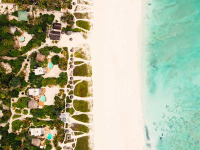
Le prestigieux hôtel Zanzibar White Sand Luxury Villas & Spa offre un accès direct à la plage immaculée de Paje, sur la côte Sud-Est de l’île. Il dispose de villas luxueuses, d’une piscine face à la mer, d’un spa, et de deux ...
BlueBay Beach Resort and Spa
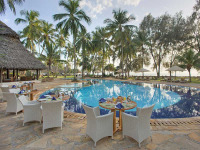
Bungalows disséminés dans la végétation luxuriante, plage de sable blanc… Cet hôtel luxueux est une valeur sûre dans la zone de Kiwengwa. Le BlueBay Beach Resort & Spa vous offrira un séjour balnéaire placé sous le signe de la ...
Unguja Lodge
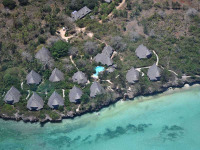
Situé à Kizimkazi, au Sud de Zanzibar, ce lodge de charme est en totale harmonie avec la nature. Le Unguja Lodge est niché dans un vaste jardin luxuriant qui est l’habitat d’une faune diverse et variée. Le site est tout simplement exceptionnel car tout est en harmonie, offrant ainsi une ...
Kisiwa House
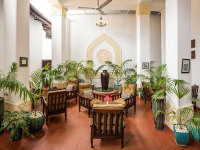
Idéal pour une halte à Stone Town, l’hôtel Kisiwa House est installé dans une jolie bâtisse historique. Il offre des équipements modernes, tout en conservant son charme ancien. Coup de cœur pour son restaurant sur le toit-terrasse, depuis lequel on aperçoit ...
Zanzibar Serena Hotel
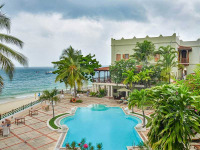
Idéalement situé en bord de mer et parfaitement intégré à la vielle ville de Stone Town, le Zanzibar Serena Hotel est un petit havre de paix chargé d’histoire. Ses chambres confortables et sa piscine vue mer sont bien appréciables après ...
Fun Beach Hotel
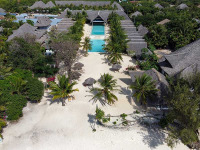
Situé en bord de mer, entre Paje et Jambiani, le Fun Beach Hotel est un petit hôtel à l’ambiance décontractée. Il propose des bungalows individuels bien équipés, entourant trois agréables piscines. Une valeur sûre pour un séjour en couple ou en famille ...
The Loop
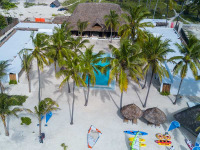
Une adresse conviviale dans un décor de rêve : voici comment on pourrait décrire The Loop. Les quelques chambres, la piscine et le bar-restaurant font face à la mer. Vous pourrez profiter de la superbe plage de Jambiani à quelques pas.
Casa Beach Hotel
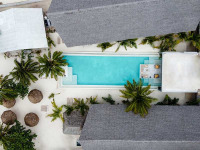
Découvrez le nouveau visage du Casa Beach Hotel, entièrement rénové en 2021. Cet hôtel se trouve près du village de Jambiani, et offre un accès direct à la plage. Il est particulièrement apprécié pour sa table, ses chambres spacieuses et sa ...
Fundu Lagoon
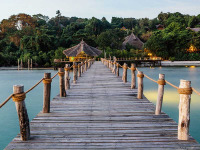
Ce bel hôtel de charme, rustique chic, est situé sur la côte Sud-Ouest de l’île de Pemba. Bordé d’une belle plage de sable blanc, c’est une merveille d’intégration dans la végétation. L’hôtel Fundu lagoon est une magnifique expérience. Il a su ...
Mafia Island Lodge
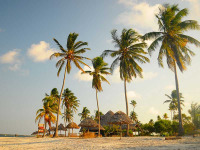
En plein cœur du parc marin, dans la baie de Chole, cet hôtel convivial est le rendez-vous de tous les plongeurs qui souhaitent découvrir la plongée sur Mafia. Le Mafia Island Lodge est situé sur la côte Sud de l’île de Mafia, au bord d’une belle plage. Le jardin est ...
Kinasi Lodge
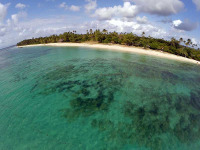
Ce lodge de charme est situé dans un cadre exceptionnel : il est niché dans une ancienne plantation de noix de coco et de noix de cajou, au cœur de la plus grande réserve marine de Tanzanie. Le cadre naturel du Kinasi Lodge est tout simplement superbe. Coup de cœur pour le plus beau ...
Pole Pole Bungalows
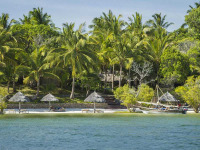
Ce petit écolodge de charme, chic et rustique, est situé au cœur du Mafia Island Marine Parc. Il est niché dans un beau jardin tropical et fait face à une mer turquoise. Tout est calme et serein, l'endroit est parfait pour se ressourcer après un safari ou pour un séjour ...
Tarangire
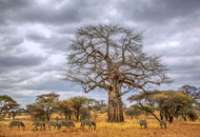
Lake Manyara
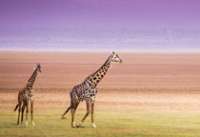
Ngorongoro
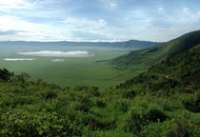
Serengeti
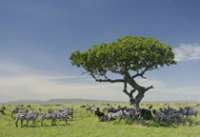
Selous

Ruaha
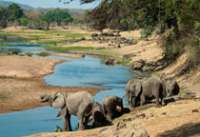
Katavi
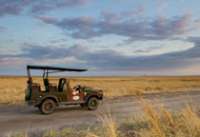
Saadani
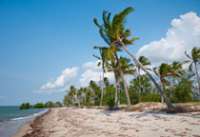
Zanzibar
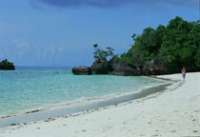
Mafia
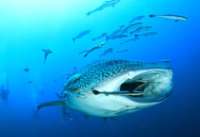
Pemba
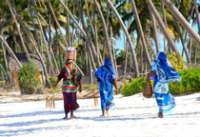
Dar es Salam

Arusha

Kilimandjaro
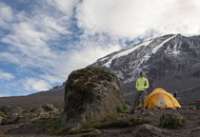
Mikumi National Park
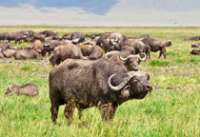
Sharazad Boutique Hotel
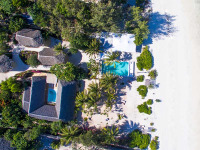
Idéalement niché sur la sublime côte de Jambiani, au Sud-Est de Zanzibar, le Sharazad Boutique Hotel est un véritable havre de paix. Entre jardin tropical et Océan Indien, son cadre apaisant vous charmera. Le confort, la sérénité des lieux et le ...
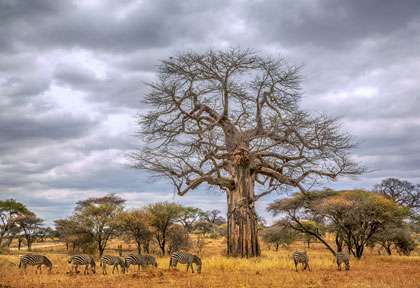
Le parc de Tarangire
Le Parc national de Tarangire s’étire tout en longueur le long de la rivière dont il tire son nom. Principalement constitué de collines plantées de buissons, acacias et baobabs (les seuls des parcs du Nord de la Tanzanie !), il offre aussi d’immenses zones de marais qui restent verdoyantes toute l’année et même une plaine surnommée « le petit Serengeti ». Cette variété de paysages et d’habitats explique la grande variété de la faune.
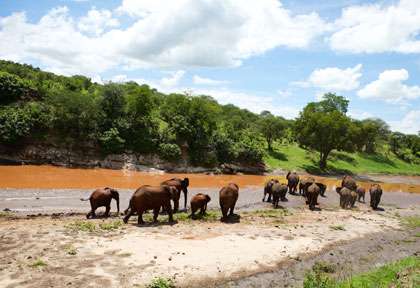
Saisons pour un safari à Tarangire
La meilleure période pour visiter ce parc va de juin à novembre : la rivière Tarangire, jamais complètement à sec, concentre la faune de toute la région, et les herbes rases n’offrent pas de bonnes cachettes aux prédateurs. Après la saison des pluies, les herbes deviennent très hautes et, si les éléphants se régalent, les herbivores tels que les zèbres ou les gnous ne peuvent pas la brouter. Ils partent donc massivement vers le Nord (Manyara et région du Ngorongoro), entraînant avec eux une partie des prédateurs.
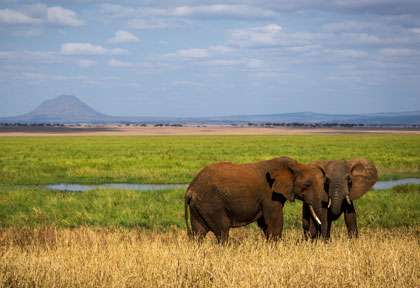
Les animaux
Si Tarangire est particulièrement connu pour son importante population d’éléphants présents à l’année, l’ensemble de la faune tanzanienne y est représenté. Les oiseaux sont particulièrement nombreux.
C’est le seul parc du Nord de la Tanzanie dans lequel vous avez la possibilité de voir des oryx, des koudous, des gérénuks (gazelle-girafe) et, avec de la chance, des lycaons.
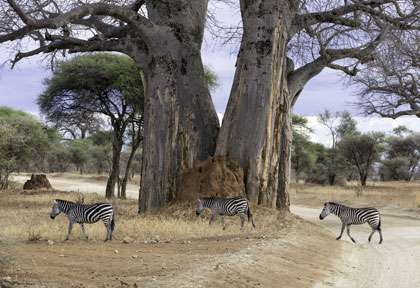
Points forts et points faibles
- les superbes paysages vallonnés avec des baobabs
- l’accès facile depuis Arusha ou Manyara
- la fréquentation très modérée
- les mouches tsé-tsé (surtout en saison humide)
- les herbes très hautes en saison des pluies qui rendent la recherche des animaux difficile
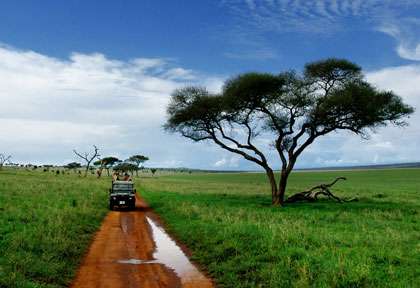
Accès et fréquentation
Depuis Arusha : comptez seulement 2 heures sur une bonne route goudronnée, le plus long est parfois de traverser Arusha si vous partez en heure de pointe !
Le parc est assez peu fréquenté toute l’année.
Hotel & Lodge
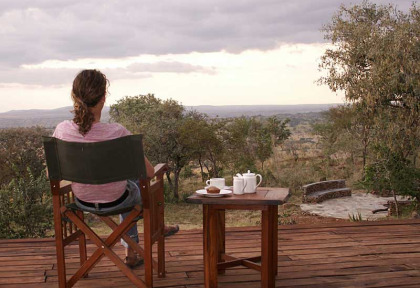
Tarangire Simba Lodge - Tarangire
Dernier né des lodges de la chaîne Simba, le Tarangire Simba Lodge offre un mélange de modernité et d'ambiance camp de brousse très ... (lire la suite)
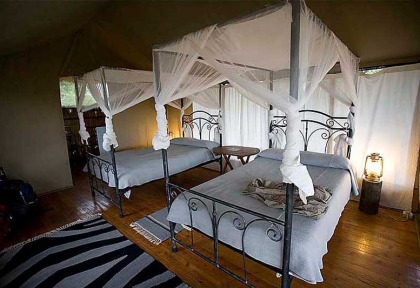
Tarangire River Camp - Tarangire
La vue est sublime, tant depuis le restaurant que depuis les tentes, la décoration sobre et raffinée et nous aimons beaucoup l’ambiance « so british ... (lire la suite)
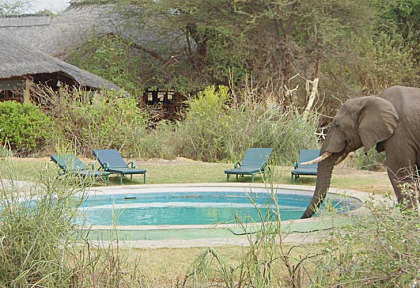
Roika Tarangire Tented Lodge - Tarangire
Un excellent rapport qualité-prix pour ce camp qui offre de nombreuses facilités (piscines, internet, grandes parties communes) tout en restant à ... (lire la suite)
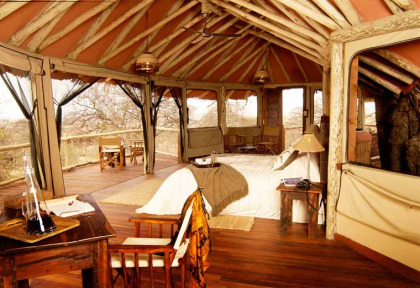
Tarangire Treetops - Tarangire
S’il est un endroit où le luxe est proche de la nature, c’est bien ici ! Ce lodge vous propose de réaliser vos rêves d’enfants, de cabane dans les ... (lire la suite)
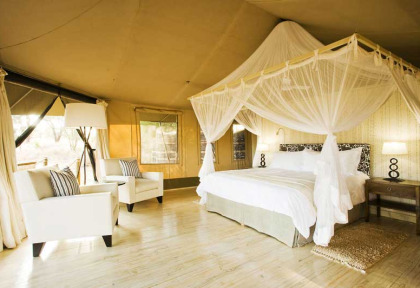
Sanctuary Swala - Tarangire
Situé dans un endroit secret de Tarangire, à l'écart des pistes fréquentées, ce camp offre luxe et exclusivité. 3 nuits ne ... (lire la suite)
Circuit & Safari
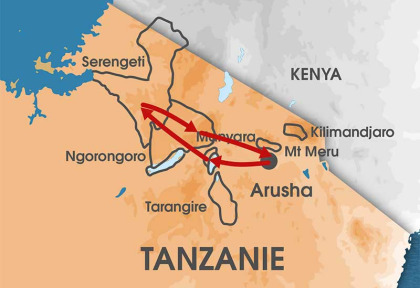
Safari Swala Duma
Safari guidé, en petit groupe - 5 nuits - à partir de 3010 €
En 5 nuits et en petit groupe, découvrez les trois parcs nationaux incontournables du Nord de la Tanzanie. Ce safari offre les avantages d'un départ ... (lire la suite)

Les parcs du Nord en version charme
Safari privé avec guide - 6 nuits - à partir de 4045 €
Aventure et safari version charme au cœur des parcs du Nord, ce circuit classique privilégie des hébergements en camps de tentes de petite ... (lire la suite)
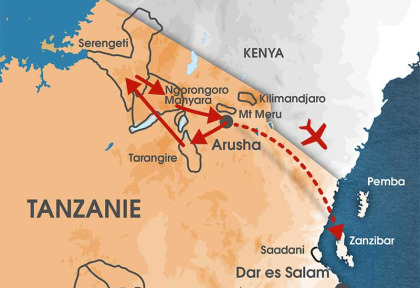
Swala Duma et Zanzibar
Safari privé avec guide - 9 nuits - à partir de 4184 €
Après votre rencontre avec les Big Five envolez-vous vers l’île tropicale de Zanzibar ! Débutez votre aventure par un safari de 5 nuits à bord ... (lire la suite)
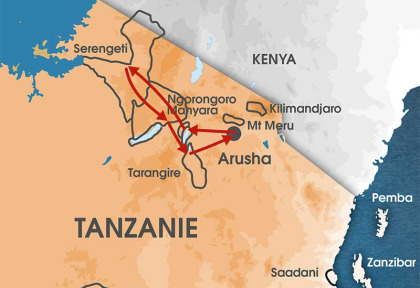
A la rencontre des Big Five
Circuit privé avec guide - 7 nuits - à partir de 3154 €
Qui n’a pas rêvé de partir à la recherche des Big Five ? La Tanzanie est l’une des meilleures destinations en Afrique pour observer lions, ... (lire la suite)
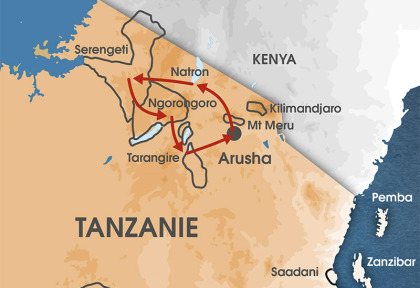
Secrets de Tanzanie
Safari privé avec guide - 7 nuits - à partir de 3034 €
Insolite et secrète, découvrez la Tanzanie et ses principaux parcs nationaux au Nord. Ce safari avec un chauffeur-guide francophone, vous conduit en dehors des sentiers ... (lire la suite)
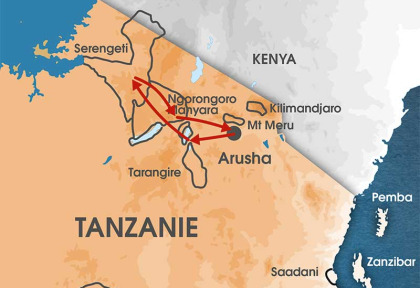
Les parcs du Nord en famille
Safari privé avec guide - 7 nuits - à partir de 4778 €
Partez en famille en Tanzanie pour un voyage plein de surprises et riche en émotions. Une formidable aventure en safari à partager avec vos enfants. Ce ... (lire la suite)
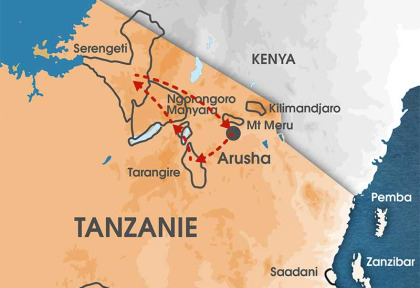
Flying-safari Elewana
Flying safari - 9 nuits
Un circuit exceptionnel avec tous les transferts en avion et des hébergements de luxe, en formule tout inclus. De quoi satisfaire les plus exigeants ! Arusha – Tarangire ... (lire la suite)

Voir tous les circuits et safaris en Tanzanie
Navigation Rapide
- Parc national de Tarangire
- Parc national de Manyara
- Cratère du Ngorongoro
- Parc national du Serengeti
- Parc national de Selous-Nyerere
- Parc national de Mikumi
- Parc national de Ruaha
- Parc national de Katavi
- Parc national de Saadani
- Arusha et Dar es Salam
- Pemba et Mafia
- Kilimandjaro et Mont Meru
- Guide de voyage en Tanzanie
- Climat et météo de Tanzanie
- Top 10 de la Tanzanie
- L’avis des voyageurs : Tanzanie
Circuits et safaris
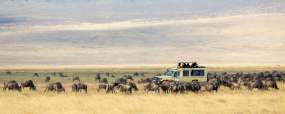
Idées découvertes
La migration dans le Serengeti
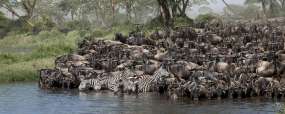
Le troupeau de 2 millions d’herbivores, dont 1,3 millions de gnous, se déplaçant selon un trajet et un rythme immuables, est certainement l’un des ...
Plongée sous-marine
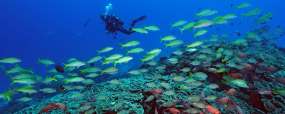
La Tanzanie offre 3 belles zones de plongée réparties sur les îles de Zanzibar, Pemba et Mafia. Cela en fait une destination idéale pour découvrir en ...
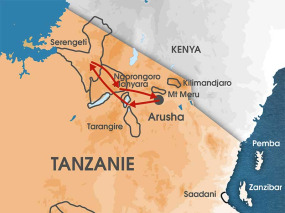
Partez en famille en Tanzanie pour un voyage plein de surprises et riche en émotions. Une formidable aventure en safari à partager avec vos enfants. Ce circuit, à bord d’un véhicule 4x4 privatif et accompagné d’un chauffeur-guide francophone, privilégie le choix des lodges et activités pour les familles. Au programme, les grands parcs nationaux de Tarangire, Serengeti, Ngorongoro et Manyara où vous pourrez observer les Big Five.

Combiner un safari en Tanzanie avec un autre pays
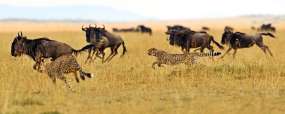
Un safari en Tanzanie offre de nombreuses possibilités de combinés, que ce soit avec un safari au Kenya voisin, ou en extension au Rwanda pour aller ...
- Skip to primary navigation
- Skip to content
- Skip to footer
Du talon au crampon
Suivez les aventures de Marie & Max, couple bordelais lifestyle.
Main navigation
Parc national de tarangire – safari en tanzanie #1.
7 septembre 2023
Après l’article de présentation de notre circuit en Tanzanie , voici le récit de notre premier jour de safari de notre voyage de noces : le parc Tarangire ! Comme vous avez pu le voir, nous avons divisé notre safari en trois parties puisque nous avons visité trois parcs : Parc Tarangire, Parc Serengeti et Cratère du Ngorongoro. Ca y est, notre rêve va se réaliser… L’excitation est à son maximum. On vous emmène avec nous !
Jour 11 : Safari parc Tarangire
Départ d’arusha.
Il est 09h00 et Eli notre guide vient nous chercher à notre hôtel. On se familiarise avec notre 4×4 que l’on aura pendant les 6 prochains jours ! On est que tous les deux à l’arrière, on ne va pas se marcher dessus car la Jeep est hyper spacieuse. On prend nos marques et on se met à notre aise. Il y a tout ce qu’il faut dont une glacière avec des vivres – ouai dis comme ça on à l’impression qu’on part à l’aventure et camper alors qu’on dort chaque nuit dans un lodge haha. En réalité il y a des boissons (eau + soda + jus de fruits), des barres de céréales et des fruits. Nous avons également deux paires de jumelles de haute qualité ainsi que deux plaids pour les moments plus frais !
Direction notre premier parc ! Je ne m’attendais pas à faire autant de route à vrai dire. Nous avons roulé pendant trois heures depuis Arusha pour rejoindre l’entrée du parc. Sur la route nous avons traversé plusieurs villages dont certains où vivent les tribus Massaï. Mais ça va car la route est en grande partie en bon état. Il s’agit d’une voie bitumée, en ligne droite, un peu comme sur la route 66. On a qu’une envie : rouler à 130km/h sur cette magnifique route. Seul hic, la limitation est fixée à 50 km/h et notre guide respecte le code la route car les rangers ne sont pas très loin. Ce que le temps paraît long !! Je suis toute excitée à l’idée de démarrer le safari. Je vais réaliser mon rêve aujourd’hui, je n’en reviens toujours pas. J’en profite pour admirer les paysages qui s’offrent à moi. Sur le chemin, nous voyons des Massaï s’occuper de leur bétail, certains tirent leurs ânes, d’autres ramassent de la végétation. Les plaines sont immenses, il n’y a rien autour de nous.
Eli s’arrête sur le bas côté. Nous ne savons pas exactement où nous sommes mais il nous explique qu’il va acheter quelques bananes. Pendant sa courte absence, de jeunes hommes s’approchent de nous et entourent notre véhicule. Ils frappent à la vitre de la Jeep. Avec Max on se regarde interloqués. « Qu’est ce qui se passe ? Pourquoi ils font ça ? Qu’est-ce qu’ils nous disent ? » Nous sommes l’attraction de la matinée. On ne se comprend pas trop mais on leur dis bonjour en leur faisant signe de la tête et des sourires. L’un des garçons part en courant et revient quelques secondes plus tard tout fier avec des maillots de foot de la Tanzanie dans ses mains. Floqués Adidas, je regarde Max perplexe qui me confirme que cela doit être des contrefaçons. Peu importe, je le trouve beau et j’ai bien envie de le ramener en souvenir. Je demande au garçon son prix, environ 4€, et lui règle dans la foulée. Je n’ai pas besoin d’aller dans les boutiques, le shopping vient à moi directement ! Je rigole et je trouve la situation très drôle. Eli revient avec ses bananes et moi je lui montre toute contente mon nouveau maillot. C’est reparti pour un quart d’heure de route jusqu’à ce que l’on voit le panneau indiquant l’entrée du parc. Nous y voilà !
Arrivée dans le parc
« Pour votre première journée de safari, vous partirez à la découverte de ce très beau parc aux paysages variés ; vous pourrez apercevoir des éléphants, des impalas, des zèbres, des léopards, des girafes… Les parcs ne sont pas fermés donc les animaux passent sans arrêt d’un parc à un autre. Les paysages changent constamment, en fonction du climat. Dans le parc Tarangire vous pourrez aussi contempler les nombreux baobabs qui sont impressionnants. » Voilà le résumé que Marjorie, la créatrice de l’agence par laquelle nous sommes passés pour faire ce voyage, a écrit dans notre guide papier. Ca promet !!
Eli nous explique que le parc Tarangire est un sanctuaire animalier incontournable et paisible de 2850 km² situé au nord de la Tanzanie. Il porte son nom de la rivière qui le traverse et qui signifie « Rivière de phacochères « . Ce parc est réputé pour ses grandes populations d’éléphants, les oiseaux et ses forets de baobabs. En effet, Tarangire est le parc qui abrite le plus grand nombre d’éléphants au monde (en gros, si vous voulez voir des éléphants, c’est vraiment à Tarangire qu’il faut aller !). Pourquoi ? Parce qu’ils ont la certitude d’y trouver de l’eau pendant la saison sèche grâce à la rivière Tarangire. Ils plongent leur trompe dans la terre jusqu’à atteindre l’eau. C’est remarquable. En plus de cette rivière, il y le lac Barunge. Ce sont les principales sources d’eau de ce parc. De nombreux animaux viennent s’y abreuver, c’est pourquoi ce sont deux spots à ne pas louper pour observer les animaux dans leur habitat naturel. C’est d’ailleurs notre premier stop. Eli était surpris de voir autant d’animaux autour du lac. Girafes, gnous, impalas et éléphants se rafraîchissaient tous ensemble, telle une grande famille. La magie opère, je mitraille de photos dans tous les sens ! Et là je vois des bébés. Je craque ! Des éléphanteaux. Il y a des éléphanteaux à vingt mètres de moi. Et c’est l’heure de la douche ! En effet leur maman est en train de les les laver. Quelle scène de vie magique. Je pourrais rester des heures à les regarder. Ce que je vis est incroyable.
On quitte ensuite le lac pour continuer la découverte du parc. Et là sur notre chemin, qu’est-ce que je vois au loin ? Un imposant éléphant qui marche en direction de notre route. Je dégaine l’appareil, j’ouvre grand les yeux et je le vois dans mon viseur. Majestueux. A chacun de ses pas j’ai l’impression que la terre vibre. Je n’ai pas les mots pour décrire ce que je ressens. Eli roule doucement pour se rapprocher de lui « sans faire de bruit ». Max n’en perd pas une miette non plus. Il est là juste devant nous et il finit par traverser la route pour rejoindre sa famille près d’un arbre. J’ai les frissons partout.
En plus des imposants troupeaux d’éléphants, nous avons vu des girafes, des zèbres, des gnous, des singes, des gazelles, des autruches, des phacochères, des oiseaux… Mais il est également possible de rencontrer des léopards, des lions, des guépards et des buffles qui sont également attirés par la rivière. En dehors des animaux, j’ai beaucoup aimé admirer la végétation et notamment ces célèbres baobabs vieux de plusieurs centaines d’années qui sont devenus, avec les éléphants, le symbole du parc de Tarangire. Ils sont impressionnants. Il y a également de magnifiques paysages qui sont très variés. Entre les plaines herbeuses, le sable, les baobabs, les cactus, la terre couleur ocre, les roches, la rivière, le lac, les paysages vallonnés : on ne s’ennuie pas ! On a vraiment l’impression de changer de parc à chaque fois que l’on change d’endroit car rien ne se ressemble. J’ai trouvé ce parc très sauvage et j’avais par moment l’impression d’être dans le roi lion !
Après plus de 6 heures à vadrouiller dans le parc, c’est déjà l’heure de partir. Il est 17h00 et le parc ferme. On en a pris plein les yeux ! Je ne m’attendais pas à voir autant d’animaux le premier jour.
Découverte de l’hôtel
C’est donc émerveillés mais aussi fatigués, et oui le safari ça remu, que nous arrivons dans notre hôtel pour la nuit : l’ Endoro Lodge . Le personnel très accueillant est d’une extrême gentillesse et au petit soin. Dès notre arrivée, deux Massaï sont là pour porter nos bagages et nous accompagner jusqu’à notre chambre. Il est 18h30 lorsque nous découvrons notre bungalow, pour une seule nuit malheureusement. Comme à chaque étape du voyage, nous sommes heureux de découvrir un tout nouvel établissement. Regardez moi cette suite incroyable ! Le lit est immense et confortable, il y en plus de la douche une baignoire d’angle avec des pétales de roses, un grand coin salon avec cheminée… et mon coup de cœur : la terrasse privative qui donne directement sur la jungle.
Ce magnifique lodge se trouve en bordure de l’aire de conservation du N’Gorongoro que nous allons traverser demain ! Le cadre est dépaysant, les bungalows sont intelligemment répartis sur le domaine, chacun avec son propre accès. L’Endoro lodge est doté d’une grande piscine (mais nous n’en avons pas profité) et de son propre restaurant. Le dîner est servis sous forme de buffet et il y a même un barbecue. Les plats sont divers, copieux et raffinés. Le seul petit bémol, qui ne nous a pas du tout dérangé, c’est la wifi qui est disponible uniquement à la réception et au restaurant.
En bref, c’était une très belle escale pour reprendre des forces après cette longue journée ! Je recommande sans aucune hésitation ce magnifique lodge. A la fin de cette première journée de safari nous sommes émus et avons encore des étoiles pleins les yeux de ce que nous avons vécu. Nous avons ressentis beaucoup d’émotions : de la joie, de l’excitation, de la surprise, mais surtout une gratitude infinie d’avoir pu vivre ces moments incroyables. Nous aimons les animaux d’un amour pur et pouvoir approcher les animaux sauvages dans leur habitat naturel fut un bonheur immense. Prochaine étape : le Serengeti !

Pour lire ou relire tous les articles sur la Tanzanie
C’est par ici
Partager :
- Cliquez pour partager sur Twitter(ouvre dans une nouvelle fenêtre)
- Cliquez pour partager sur Facebook(ouvre dans une nouvelle fenêtre)
- Cliquez pour partager sur Google+(ouvre dans une nouvelle fenêtre)
Articles similaires

Reader Interactions
Laisser un commentaire annuler la réponse..

ABONNEZ-VOUS !
Saisissez votre email pour nous suivre & être au courant des nouvelles publications !
Ils se sont lancés dans l'aventure du blogging en septembre 2015 lors de leur installation en Corse. Dépaysement, découvertes et aventures en amoureux, ils partagent au départ leur quotidien pour leurs proches.
Animés par un profond désir de créer une marque à leur image, le couple s’est lancé en 2018 dans l’entreprenariat avec l'ouverture de l'eshop Duodem, à destination des futures et jeunes mariés. En 2023, Marie sort son livre intitulé "Vie de mariée", un guide pour organiser seul.e son mariage.
Ils ont également monté en 2022 Il était un picnic, une agence d'organisation de pique-nique de luxe en Corse. En savoir plus
SUIVEZ-NOUS SUR LES RESEAUX !
Mentions légales
DUODEM, NOTRE MARQUE

Découvrez l'e-shop de l'Amour et notamment notre collection de prêt-à-porter pour jeunes et futures mariées ♥
MON LIVRE : VIE DE MARIEE

Le guide pour organiser son mariage de A à Z sans wedding planner !
Dans ce livre positif et inspirant, Marie partage les clés pour vous aider à organiser un mariage unique, personnalisé et à votre image. Conseils, astuces, anecdotes et récit du joli jour qu’elle a imaginé et rêvé depuis son plus jeune âge, elle vous partage son expérience de jeune mariée. Par son œil de passionnée, elle vous invite à vous écouter, croire en vos rêves et oser être vous-même. Véritable guide qui contient des conseils, des renseignements et des idées pour vous inspirer
After Footer
Rejoins-nous !
Saisissez votre adresse e-mail pour être au courant des dernières nouvelles et recevoir les toutes dernières publications !

Visit This National Park In East Africa For One-Of-A-Kind Wildlife Viewing Experiences
A n African safari is on many people's bucket lists -- and with the highest concentration of animals per square km in the world, Tanzania is the ideal place to do it. Located in the north of the country, Tarangire National Park is Tanzania's sixth largest national park, based around the Tarangire River which it is named after. The star of the show is the elephant, and herds of up to 300 travel to this part of the East African Rift Valley to drink, wash, and socialize.
These gatherings form the highest concentration of African elephants of any park in northern Tanzania, and watching them bathe in the river together is a unique experience. They are the biggest of the 'Big 5' game species, but lion, leopard, and buffalo can be found here too. While the rhino (which is the fifth of the lineup) is unlikely to be seen here, there are a wealth of other incredible creatures in Tarangire. There is even a migration of wildebeest, albeit smaller than the more famous species in the Serengeti. Safaris can be expensive outings , but they're unforgettable experiences.
Read more: 28 Bucket List Destinations That Everyone Needs To Experience At Least Once
How To Visit Tarangire National Park
The entrance to Tarangire National Park is about two hours drive from Arusha in North Tanzania. Dar es Salaam is the best option for flying into Tanzania. From there, your safari operator can help you with onward travel or you can make your own way. The dry season runs from June to October, and it is the best time to spot big game as wildlife migrates to the Tarangire River to find water. During the rainy seasons, most of the larger wildlife goes elsewhere. From November to March is the wet season. While it isn't a good time for big game, it is great for birdwatching tours.
The park fees are more expensive for overseas visitors, costing $53 to $59 per adult for each day spent there. These fees are usually included in the price of your safari and your guide will pay them on your behalf. Night safaris are not permitted inside the park for safety reasons, so tours will generally be from 6:30 am to 6:30 pm. Your guide will be able to advise on safety while you're on a game drive. While it is possible to go for walks in the park, this should only be done when they say so.
What You Will See In Tarangire National Park
Most of the wildlife will accumulate around the river, and it is here that you will come to find the wildebeest, zebra, buffalo, giraffe, and warthog -- as well as the elephant. Lesser-known but equally incredible species (like the Bohor reedbuck, Coke's hartebeest, Thompson's gazelle, greater kudu, waterbuck, and lesser kudu) also gather here. Predators like lions, hyenas, and leopards usually watch their prey from a distance, with cheetahs and wild dogs being less common here.
Wildlife can be found in every part of the habitat as hippos ply the river while baboons, vervet monkeys, and even pythons swing from the trees. Over 500 bird species have been recorded in the park, so keep your binoculars handy for storks, hornbills, guinea fowl, eagles, parrots, vultures, bee-eaters, bustards, and lovebirds as you drive around. The landscape itself is iconic, lined as it is with the unofficial symbols of the African plains, the baobab, and acacia trees. Some species found in Tarangire National Park are endemic to Tanzania so they cannot be found anywhere else on earth -- which may be the ultimate reason to go on safari here.
Read the original article on Explore .


Le Parc National du Tarangire en Tanzanie : l’un des meilleurs parcs de safari au monde !
Le parc national du tarangire en tanzanie.
Du Parc National du Serengeti au Cratère du Ngorongoro, du Parc de Tarangire au Lac Natron, partez à la découverte des plus beaux Parcs nationaux en Safari en Tanzanie . Parmi les parcs les plus renommés du Nord de la Tanzanie, le parc du Tarangire occupe une place particulière dans la découverte de la savane africaine et de ses habitants !
Reconnu comme l’un des meilleurs parcs de safari dans le monde pour sa concentration de baobabs, d’éléphants, d’oiseaux ainsi que sa petite migration d’herbivores entre juillet et novembre, le Tarangire fait partie des parcs « coup de cœur » de nos voyageurs !
La diversité et la richesse animalière de ce sanctuaire n’a rien à envier aux parcs voisins d’autant que vous avez le loisir de profiter du calme qui y règne.

Présentation du Parc National du Tarangire
Superficie : Le Parc du Tarangire s’étend sur 2850km² et se trouve au sein d’une zone de protection de la vie sauvage (appelée Wildlife Management Area ou WMA) créée en 2006 par les autorités locales sur 20 000km². Accessibilité : Le parc est facilement accessible grâce à une route goudronnée d’environ 2h depuis Arusha. Frais d’entrée : 53 USD par adulte / 18 USD par enfant (5 – 15 ans) Paysages : Le parc se situe dans la steppe Maasaï et est caractérisé par ses vastes paysages de plaines vallonnées. Il est traversé par la rivière Tarangire , avec une savane arborée par les emblématiques baobabs et nombreux acacias qui façonnent le paysage.
Le Tarangire : une situation idéale au cœur de la Vallée du Grand Rift
Le parc tient son nom de la rivière Tarangire qui le traverse et permet aux animaux de se rafraîchir toute l’année.
L’entrée principale se trouve à trente minutes de piste de la jonction de Makuyuni, elle-même située à 1h de route de la ville d’Arusha. Le parc est facilement accessible, ce qui en fait une excellent choix pour les courts safaris en Tanzanie et les safaris en famille avec enfants .
A seulement 110 km d’Arusha (2h environ) et à seulement 70 km de Mto Wa Mbu, l’entrée au parc Manyara , le Tarangire est idéal pour sa proximité avec la ville et d’autres parcs nationaux.

Vous pouvez en profiter pour combiner votre safari avec une découverte locale et culturelle en partant explorer les environs du Mto Wa Mbu en vélo . C’est une activité idéale en famille, en couple ou autre en amis pour se dépenser ! Aux abords de la Vallée du Grand Rift, vous passez dans les villages ruraux et rencontrez leurs habitants issus de tribus différentes. Vous allez dans des petits productions locales (de café, bananeraies) et profitez de cette balade pour découvrir les paysages pittoresques et les animaux de la région.
Les mythiques baobabs du Tarangire en Tanzanie
L’écosystème du Parc du Tarangire est plus dense d’un point de vue végétation que le Parc du Serengeti. Sa flore est particulièrement variée avec des acacias semi-arides et ses régions boisées.
Quand vous entrez dans le Tarangire, vous pénétrez dans le royaume des baobabs , arbre mythique de la savane africaine. Ils font la renommée du lieu et s’étendent le long de la rivière et au-delà.
Le paysage aride de cette région favorise le développement de ces superbes arbres considérés comme sacrés, qui cohabitent avec les autres géants du coin : les éléphants.
Il existe huit types de baobabs, et celui que l’on trouve en Tanzanie est le plus grand et le plus gros. Ceux que vous découvrez au Tarangire ont au moins mille ans chacun.

D’un point de vue plus pratique, le baobab est une importante source de nourriture pour les animaux de Tarangire , avec ses graines comestibles et son écorce utilisée par les éléphants pour aiguiser leurs défenses.
Demandez à votre guide de vous conduire près d’un baobab un peu spécial, appelé « baobab des braconniers » car son tronc est creux et la légende raconte qu’il servirait de cachette pour les braconniers …
L’attribut principal du parc est la Rivière Tarangire qui s’étend du Nord au Sud , entourée d’herbes et de bois ponctués de quelques palmiers. Elle rassemble des dizaines d’animaux, regroupés pour boire , en particulier pendant la saison sèche où les points d’eau se font de plus en plus rares.
Découvrir les légendaires troupeaux d'éléphants du Tarangire

Le parc est un véritable sanctuaire pour les éléphants, dont le nombre a été estimé à 2500 pendant le recensement de 2009 . Ces pachydermes sont les stars de ce parc où vous avez vos meilleurs chances de les voir au plus près et en grand nombre !
Avoir l’opportunité d’observer une horde de ces géants au pied d’un baobab millénaire reste le point d’orgue d’un safari au cœur du Parc National du Tarangire. Vous avez de forte chance de voir des éléphants à plusieurs reprises et même en grand nombre , vers la rivière Tarangire, se frottant contre un baobab, dans un grand marais, la savane…
Des études plus récentes ont montré que c’est le seul parc de Tanzanie (avec le Parc National du Serengeti) où la population d’éléphants est en croissance , malgré la menace qui pèse sur eux avec le braconnage des défenses .
La petite migration du Tarangire

Moins connue que la Grande migration de la région du Serengeti-Ngorongoro , le Parc National du Tarangire connait également une petite migration.
Pendant la saison sèche, entre juillet et octobre/novembre, des troupeaux d’éléphants, de zèbres, de gnous ou encore d’antilopes se rejoignent pour étancher leur soif sur les rives du Tarangire.
Egalement, de nombreux buffles, élans, girafes et autres animaux viennent s’abreuver avec des prédateurs toujours aux aguets, pas très loin de leur proie.
Pendant la saison des pluies, une partie de la vie sauvage se disperse au Nord et au Sud du parc, mais le Tarangire offre toujours un spectacle inoubliable avec des oiseaux plus présents que jamais et des lions (contre toute attente) plus faciles à localiser et plus actifs la journée.
Les prédateurs sont d’ailleurs très présents dans la principale zone touristique du Tarangire (autour de la rivière entre le Tarangire Safari Lodge et le Tarangire Sopa Lodge), en particulier les lions et léopards.
Quels animaux voir dans le Tarangire en Tanzanie?
En général, et en particulier pendant la saison sèche, le parc offre facilement l’observation des girafes, hippopotames, phacochères, buffles, zèbres, gnous et lions en plus des rois du parc, les éléphants. Les hyènes tachetées font leur apparition occasionnellement tandis que les léopards et les guépards, et les chiens sauvages se font plus discrets.
Les rhinocéros ne sont pas présents, par contre des oryx, impalas et des gazelles de Waller peuvent croiser votre chemin. Vous les trouvez principalement vers les eaux pérennes de la rivière Tarangire et les marais aux alentours lors de votre safari.

Les marais verts luxuriants du Tarangire , que l’on ne trouve pas dans le Serengeti, attirent de nombreux animaux . Ils apportent un contraste saisissant avec les plaines dorées de la région.
Après la saison des pluies, les hautes herbes qui chatouillent les cuisses des éléphants sont les festins des pachydermes mais pas des gnous qui ne peuvent pas les brouter. Ils se déplacent donc vers les autres parcs du nord, Manyara et la région du Ngorongoro , entrainant avec eux une partie des prédateurs.
Tandis qu’à la saison sèche, les herbes rases permettent aux herbivores de repérer plus facilement les prédateurs qui ne peuvent plus aussi facilement se cacher.
En dehors des éléphants, Il est difficile d’estimer la population des autres espèces animales présentes dans le Tarangire, car les derniers recensements remontent à des dizaines d’années, mais les dernières estimations faisaient état d’environ 25 000 gnous, 30 000 zèbres, 6 000 buffles, 2 700 girafes, 5 500 élands, 30 000 impalas et 2 000 phacochères.
Le parc Tarangire, un véritable paradis pour les amateurs d’oiseaux

Avec sa variété d’habitats et de sources de nourriture, le parc national du Tarangire est idéal pour les oiseaux et est donc un excellent spot pour les observer. Avec plus de 550 espèces d’oiseaux , le parc réunit le nombre le plus élevé d’espèces de toute la Tanzanie. Il est le paradis des ornithologues amateurs !
Les bois du parc abritent des perroquets bruns, des perruches à ventre orange, des oiseaux à ventre blanc ainsi que des gibiers à plumes tels que la pintade casquée, le machaon à cou jaune et le francolin à crête.
Les oiseaux nichant dans les acacias sont facilement observables dans le Nord du parc : calaos, huppes, hirundinidés, étourneaux, tisserins …
Parmi les autres habitants populaires du parc, mentionnons les tourtereaux à collier jaune, les rouleaux à poitrine lilas, les oiseaux souris, les martinets, les hirondelles rayées, les étourneaux, les guêpiers, les hammerkops, les pluviers, les outardes Kori,
Chez les rapaces , vous pouvez observer des aigles bateleurs des savanes et ceux des steppes, des gigantesques vautours à front jaune , des pygargues vocifer et des palmistes africains.
Et ce n’est que pour en nommer quelques-uns !
Activités dans le parc Tarangire en Tanzanie

La majorité des voyageurs visite le parc du Tarangire sur une journée et se concentre sur la partie Nord du parc. Mais le Tarangire saura ravir ceux qui y passent 2 ou 3 jours et décident d’aller au-delà de cette zone plus fréquentée .
Nous vous conseillons en particulier la zone proche du Lac Burunge pour observer les tragélaphes rayés et les koudous, la colline de Kitibong pour les grands troupeaux de buffles et la zone marécageuse de Lamarkau pour observer les hippopotames et oiseaux.
Au-delà des safaris 4×4, il est possible d’organiser des safaris à pieds ou de nuit dans le Tarangire . Il est également possible de faire un safari en mongolfière durant 1h , clôturé d’un petit déjeuner dans la savane (prix : environ 450 USD par personne).
N’hésitez pas à nous dire si vous souhaitez inclure ces activités dans votre programme !
Où dormir après un safari au parc du Tarangire?

Il existe une multitude d’options pour dormir avant ou après un safari dans le Parc du Tarangire.
Vous pouvez déjà choisir de dormir au sein du parc , ce qui vous permet d’être au plus proche de la nature et des animaux, mais qui est également un peu plus cher. Plusieurs options s’offrent à vous :
Dormir en camping dans le Parc Tarangire
Vous amenez votre sac de couchage et on s’occupe du reste ! Pour les amoureux d’aventure, c’est t une occasion unique de dormir au cœur de la nature , de croiser des éléphants en allant se coucher et d’entendre des hyènes en pleine nuit (pensez à rentrer vos chaussures dans la tente … les hyènes s’en font un festin !). C’est également l’option la plus économique pour dormir dans le parc.
Dormir en tented camps ou en lodges dans le Parc Tarangire
Un hébergement tout en confort et rempli de charme , tout en étant au cœur de la nature. Ambiance « Out of Africa » garantie notamment pour un voyage de noces en Tanzanie . Le must, c’est le Tarangire Safari Lodge . Le plus vieil établissement du parc, avec l’une des plus belles vues de Tanzanie et où il n’est pas rare que des éléphants viennent vous faire un petit coucou à la piscine …
Dormir en tented camps ou chez l’habitant en dehors du Parc Taranagire
Pour ceux qui dorment en dehors du parc , vous avez le choix entre :
- Les Tented camps: qui se trouvent à proximité du Parc comme le Sangaiwe Tented Lodge , le Burunge Tented Lodge ou le Maramboi Tented Loge, qui offrent un excellent niveau de confort et de service, de magnifiques vues sur les lacs alentours et parfois quelques visites impromptues d’animaux. Ils ont l’avantage d’être moins chers que les camps se situant dans le parc.
- Chez l’habitant ou chambres d’hôtes: L’autre possibilité est de rejoindre les villes les plus proches de Mto Wa Mbu ou Karatu (si vous poursuivez votre séjour vers le Cratère du Ngorongoro ou le village d’Endallah ) ou vers Babati / Katesh si vous avez choisi de vous lancer dans l’ascension du Mont Hanang. Dans ces villes, vous pourrez loger chez l’habitant ou dans des chambres d’hôtes bon marchés , pour faire des économies et être au plus proche des locaux !
Conseils pour un safari dans le Tarangire

Durée conseillée : Une journée vous permet déjà de faire une belle visite du parc, cependant nous vous conseillons plutôt 2,3 jours pour profiter de toutes les merveilles qu’offre le domaine.
Meilleure période : En dehors des mois d’avril-mai et novembre, le parc se visite toute l’année. En fin de saison sèche, la période est fantastique vers septembre-octobre avec beaucoup de félins !
Notre avis : Le Tarangire est un inconditionnel pour tous les amoureux des éléphants et des oiseaux. De plus, de part son accès facile il est un excellent choix pour les petits budgets, les safaris courts et idéal pour les familles car avec la vie sauvage dense du parc, les enfants ne s’ennuient pas ! Le parc à l’avantage d’être moins fréquenté que ses voisins, le Serengeti et le Ngorongoro et permet donc de profiter d’un safari en toute quiétude. Il est aussi parfaitement situé pour démarrer un circuit des parcs du nord.
Maintenant, il n’y a « plus qu’à » préprarer le sac, l’appareil photo, la crème solaire … et c’est parti pour un safari en Tanzanie inoubliable !

Parc national de Tarangire en Tanzanie : guide
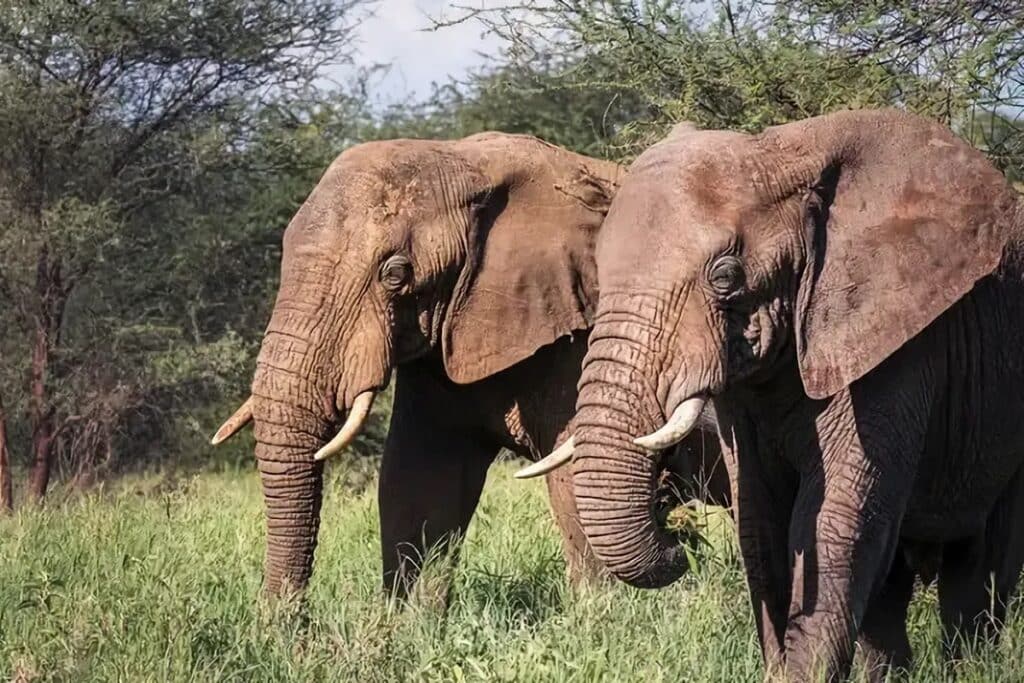
Surréaliste et sublime, le parc national de Tarangire est un point culminant du safari tanzanien extrêmement sous-estimé. Il est célèbre pour ses éléphants et ses baobabs, mais la faune est beaucoup plus diversifiée que ce à quoi les visiteurs s’attendent.
Dans le cadre du Circuit Nord, Tarangire est une étape populaire lors de nombreux safaris en Tanzanie. Cependant, c’est aussi le parc que les gens enlèvent de leurs itinéraires afin d’économiser de l’argent. Ne négligez jamais le parc national de Tarangire. C’est une introduction parfaite à l’expérience de safari en Afrique, où vous vous rapprochez incroyablement de tant de géants à quatre pattes. Cependant, vous devez être conscient des changements saisonniers et des mouvements migratoires, qui ont un impact sur l’expérience de la faune. Ce guide vous donnera différentes options et vous aidera à maximiser l’expérience sur le terrain.
À propos du parc national de Tarangire
Tarangire est situé dans le nord de la Tanzanie et se trouve sur le circuit nord du safari en Tanzanie. Il s’agit d’un itinéraire entre quatre parcs et réserves contigus : Tarangire, le lac Manyara, le cratère du Ngorongoro et le parc national du Serengeti. La porte d’entrée de Tarangire se trouve à environ 2 heures et demie de route d’Arusha ou à trois heures de l’aéroport international du Kilimandjaro.
Avec 2 850 km2, il s’agit d’un des plus petits parcs du pays. Mais Tarangire se trouve au cœur d’une zone de migration de la faune qui s’étend sur plus de 30 000 km2. Pendant la saison sèche, la population d’animaux sauvages double, car les animaux viennent profiter du réseau de marécages.
Dans la plupart des pays, Tarangire serait un point culminant de safari. Cependant, la proximité de la zone de conservation du Ngorongoro et le parc national du Serengeti , tous deux énormément visités, signifie que ce parc est pour la plupart des voyageurs en Tanzanie inconnu ou négligé.
Certaines personnes trouvent que c’est un atout. Elles visitent la Tanzanie pour découvrir la grande migration des gnous, les prairies du Serengeti et le cratère du Ngorongoro, donc une journée à Tarangire est un bonus attendu. Cependant, d’autres ignorent totalement le parc de Tarangire car ils veulent passer plus de temps dans les deux destinations célèbres à proximité.
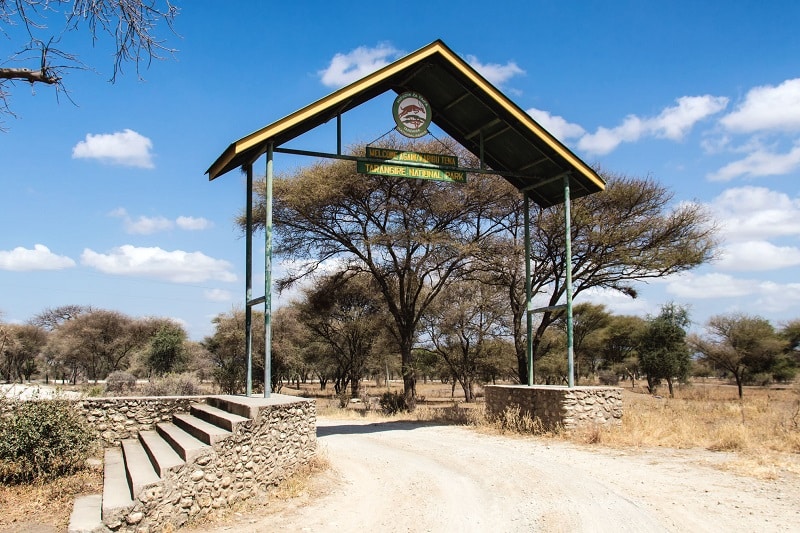
Safari dans le parc de Tarangire
Le parc national de Tarangire offre une expérience de safari authentique et très intime. Les visiteurs ouverts d’esprit l’adorent. Ils aiment particulièrement la diversité de la faune, la nature sauvage et la proximité des grands mammifères. Mais ce n’est pas une destination classique des Big Five . Les personnes souhaitant cocher tous les animaux célèbres de leur liste peuvent être déçues. Les visiteurs ne peuvent explorer le parc national de Tarangire que lors de safaris de jour. Les règles du parc sont strictes et les guides ne peuvent pas vous faire sortir des sentiers principaux.
Une poignée de camps ont leurs propres concessions à la périphérie du parc national. De courtes promenades pour observer du gibier sont possibles, mais ce ne sont pas de longs safaris à pied, seulement 20-30 minutes de marche pour aller observer les éléphants.
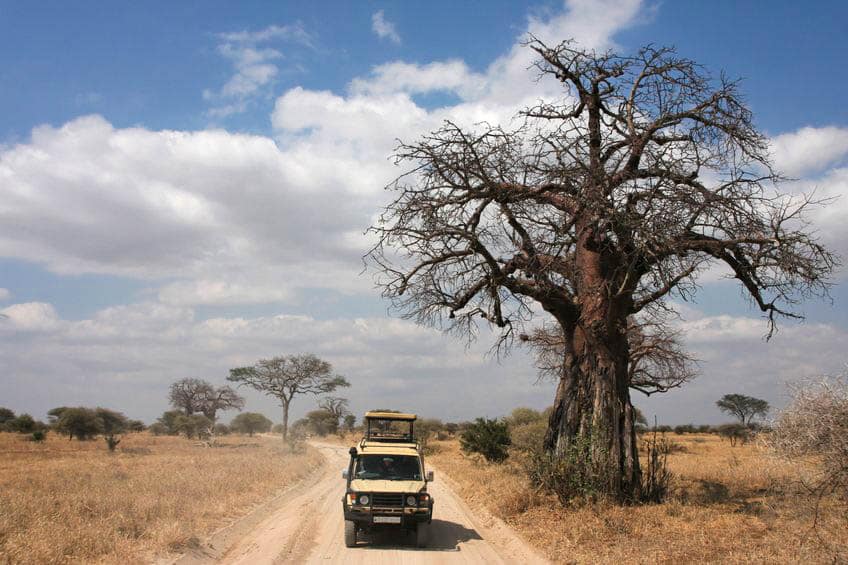
Un paysage varié
Le paysage de savane du parc est dominé par des baobabs, des crêtes granitiques, d’anciennes vallées fluviales et des marécages saisonniers. Une végétation variée attire une faune variée. Le meilleur mot pour décrire le paysage du parc national de Tarangire est épais. L’herbe pousse haut et la forêt est étonnamment dense. À part la rivière et les marais, il y a peu d’espace ouvert, ce qui fait de Tarangire un merveilleux contraste avec les prairies du Serengeti. Les arbustes d’acacias et les forêts mixtes occupent la moitié du parc, ce qui signifie plus de nourriture pour les éléphants que partout ailleurs dans le nord de la Tanzanie. Les marécages et les rivières saisonnières dominent le sud et l’est du parc. Ceux-ci attirent les espèces migratrices de juin à octobre.
Les baobabs sont nombreux et parmi les plus grands d’Afrique. Ils éclipsent toute la faune (oui, même les éléphants et les girafes !) et se dressent comme des sentinelles à l’horizon.
La rivière Tarangire traverse le cœur du parc et fournit de l’eau aux résidents (de la faune) toute l’année. Le reste du paysage est visiblement sec, même pendant la saison des pluies.
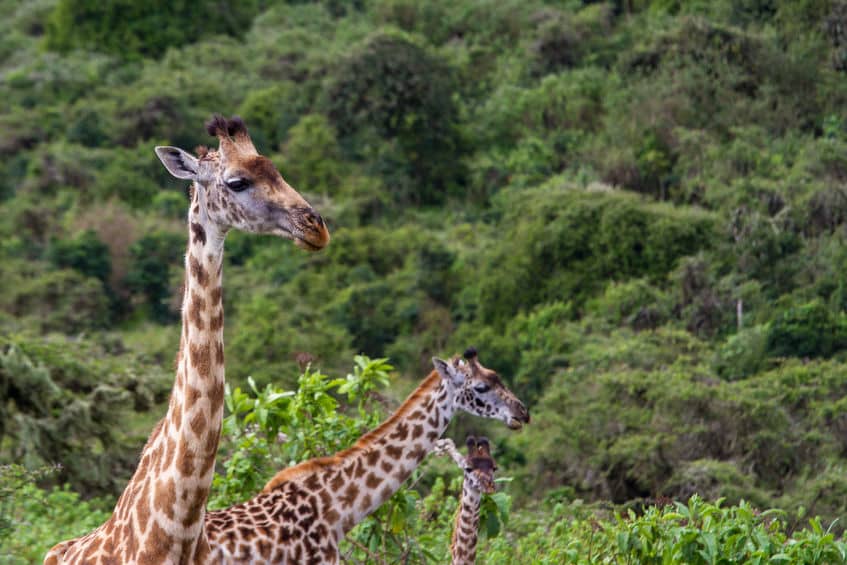
Une faune extraordinaire
Le parc national de Tarangire est célèbre pour ses éléphants. D’énormes troupeaux patrouillent dans la savane, balançant leurs trompes alors qu’ils marchent vers l’eau.
Parfois, les troupeaux d’éléphants comptent plus de 300 membres, ce qui en fait les plus grands troupeaux d’Afrique de l’Est. Même un petit troupeau peut avoir 50 individus, il ne fait donc aucun doute que Tarangire est un parc pour les amoureux des éléphants. Cependant, bien que les éléphants sont un point culminant, de nombreux visiteurs pensent qu’ils sont le seul point fort du parc. Le parc de Tarangire est ignoré et sous-estimé en raison de cet accent incontournable sur les éléphants.
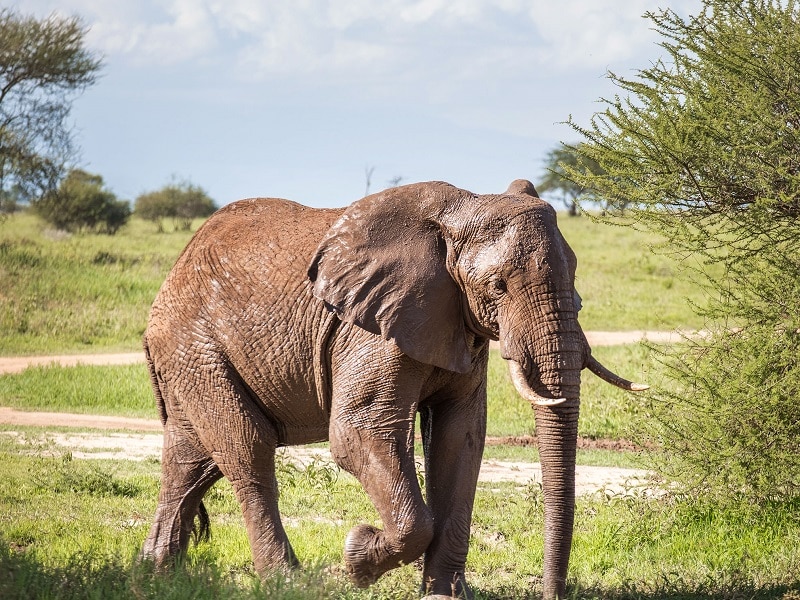
Vous pouvez profiter de rencontres remarquables dans le parc national de Tarangire. Les termitières abandonnées abritent de grandes colonies de mangoustes. Des spécialistes des zones arides comme l’oryx à oreilles frangées et la gazelle de Waller (également appelée antilope girafe) se pavanent sur les orées des bois. Les grands troupeaux d’antilopes sont visibles pendant la saison sèche. Le gnou et le zèbre sont rejoints par la gazelle de Thomson, l’éland, le bubale et l’impala.
Ces antilopes abondantes attirent une excellente population de grands félins. Le parc national de Tarangire compte autant de félins que les autres parcs de Tanzanie.
Les lions sont faciles à trouver. Mais la végétation épaisse rend difficile la recherche de félins solitaires. Vous aurez besoin d’un bon guide pour rencontrer des léopards ou des guépards. Mais ces animaux sont présents et plus vous avez de temps, plus vous avez d’opportunités de rencontre. On peut aussi voir des hyènes, mais vous en verrez beaucoup plus aux parcs de Ngorongoro et du Serengeti. On peut également observer des lycaons car il y a une population viable dans le parc.
Tous ces animaux africains sont rejoints par les classiques du safari. Les hippopotames sont communs, les buffles abondants, et presque toutes les vues comprennent des girafes qui sortent leur langue le long des baobabs. Les rhinocéros ne sont pas présents mais il y a des observations très inhabituelles à rechercher, comme des pythons drapés autour des arbres en dehors des marais.
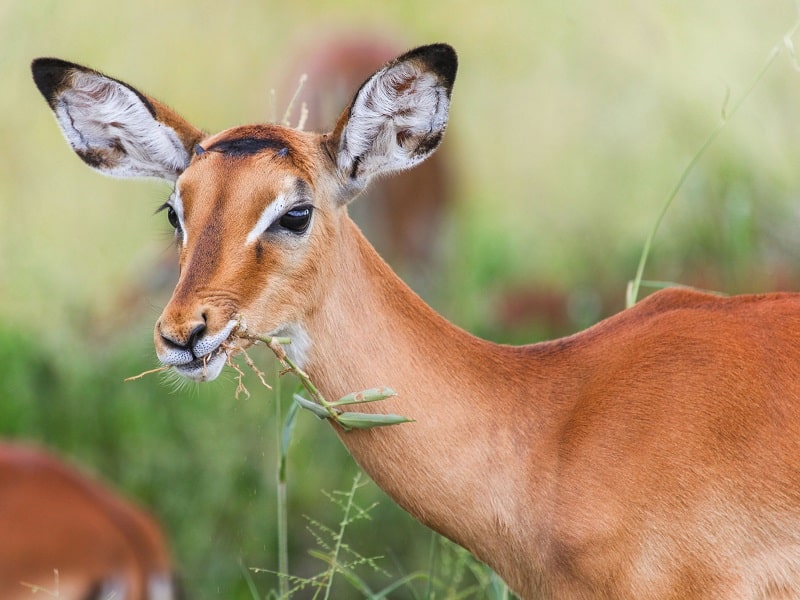
Un parc idéal pour les petits budgets
De nombreux voyageurs à petit budget évitent Tarangire dans le but d’économiser de l’argent. Malheureusement, d’un point de vue budgétaire, un jour de moins à Tarangire n’équivaut pas à un jour de plus dans le Serengeti. Tarangire est l’un des parcs nationaux les moins chers d’Afrique de l’Est. Les frais de parc sont inférieurs de 50% au Serengeti ou au Ngorongoro.
Dans les grandes destinations de safari comme le Serengeti ou le Ngorongoro, vous devez vraiment séjourner à l’intérieur du parc ou de la réserve. Sinon, les distances sont trop longues et vous ne pourrez pas apprécier l’expérience complète du safari. Chaque camp paie des frais pour chaque nuit que vous y passez. Ces frais sont exorbitants dans le parc du Serengeti.
Tarangire est petit. Vous pouvez séjourner à la périphérie du parc, dans une zone de transition qui bénéficie d’une faune migratrice abondante. Ces camps n’ont pas à payer de frais de parc pour votre séjour, ils sont donc nettement moins chers par nuit. Pour économiser de l’argent, il vaut mieux passer plus de temps à Tarangire et moins de temps dans les autres destinations plus célèbres.
Les camps de safari à Tarangire
Tarangire abrite une poignée de camps et de pavillons. La plupart d’entre eux sont au nord du parc. Quelques options exclusives peuvent être trouvées dans le sud. La zone de transition comprend une plus grande variété de camps. Ceux-ci sont moins chers et ils sont toujours visités par les éléphants, les lions, les antilopes et plus. La plupart de ces camps sont littéralement à la limite du parc national de Tarangire. Vous pouvez donc vous détendre au camp et profiter d’un grand nombre d’animaux.
Un inconvénient est que vous ne pouvez pas entrer dans le parc directement depuis le camp. Vous devrez contourner le périmètre et entrer par les portes principales. Cela peut ajouter 10 à 30 minutes de trajet, mais cela permet d’économiser quelques centaines d’euros par nuit. En bordure du parc national de Tarangire, vous pouvez profiter d’un camp de safari moyen à haut de gamme, avec de belles suites autonomes, une piscine visitée par des éléphants et un sentiment de luxe discret.
Vous pouvez profiter de la même chose dans le Serengeti pour plus de 600€ par jour. À Tarangire, le prix est plus proche de 160€. En préparant un safari, cela vaut la peine de prendre un hébergement haut de gamme autour de Tarangire, puis de passer à des camps plus simples dans le Serengeti.
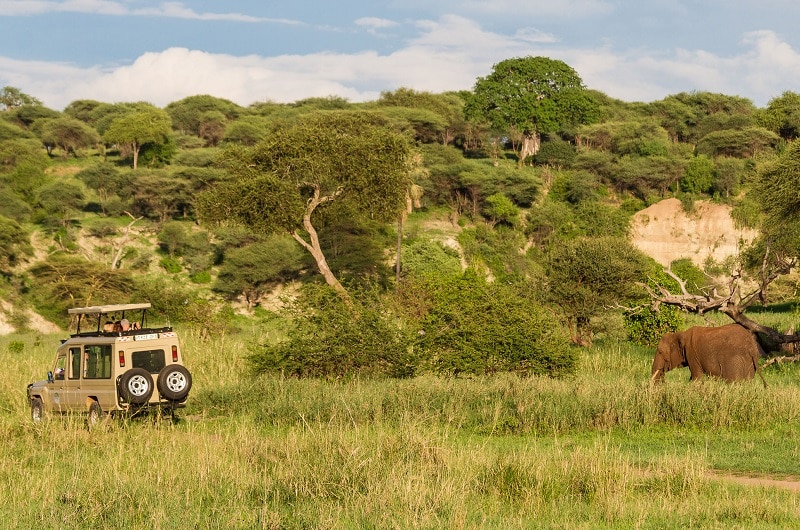
Inclure le parc dans un itinéraire du circuit nord
Le circuit nord classique par voie terrestre visite les quatre parcs et réserves. Habituellement, cela permet une journée à Tarangire, une journée au lac Manyara, un safari dans le cratère du Ngorongoro, puis un nombre flexible de jours dans le parc national du Serengeti.
Le lac Manyara est une bonne destination à visiter à tout moment de la journée. Son cadre magnifique et ses lions grimpeurs peuvent être appréciés à toute heure, tandis que le cratère du Ngorongoro et le Serengeti sont idéaux le matin ou en fin d’après-midi.
Le parc national de Tarangire se situe quelque part entre les deux. Les grands mammifères comme les éléphants peuvent être appréciés tout au long de la journée, mais il faut venir tôt le matin ou en fin d’après-midi pour rechercher des félins. Un itinéraire recommandé du circuit nord est :
- Jour 1 : départ d’Arusha, safari l’après-midi dans le nord de Tarangire.
- Jour 2 : journée complète de route dans le sud de Tarangire.
- Jour 3 : route de jour au lac Manyara, nuit dans la zone de conservation du Ngorongoro.
- Jour 4 : safari tôt le matin dans le cratère du Ngorongoro, puis le Serengeti.
- Jour 5 et après : parc national du Serengeti
Ou considérez ce qui suit :
- Jour 1 : départ d’Arusha, safari au parc du lac Manyara, nuit à côté du parc de Tarangire.
- Jour 2 : journée complète et nuit à Tarangire.
- Jour 3 : route vers Ngorongoro pour l’après-midi dans le cratère du Ngorongoro.
- Jour 4 et après : parc national du Serengeti
Safaris courts depuis Arusha / Moshi
Vous pouvez également visiter Tarangire et une autre destination lors d’un court safari d’une ou deux nuits au départ d’Arusha, ou même de Moshi. C’est une bonne option si vous visitez le nord de la Tanzanie pour escalader le Kilimandjaro. Une randonnée longue et coûteuse ne laissera pas beaucoup de temps ou de budget pour un safari, mais avec ces courts itinéraires, vous pouvez toujours profiter d’une fabuleuse expérience de safari. Par exemple :
- Jour 1 : départ d’Arusha / Moshi, après-midi au lac Manyara, nuit à Tarangire.
- Jour 2 : journée complète à Tarangire (nord et sud), retour en soirée à Arusha.
- Jour 1 : départ d’Arusha / Moshi, après-midi à Tarangire, nuit dans au Ngorongoro.
- Jour 2 : départ matinal pour le cratère du Ngorongoro, retour à Arusha.
La durée de safari idéale à Tarangire
Les visiteurs au parc national de Tarangire n’y restent généralement qu’un ou deux jours car ils doivent partager leur temps entre tant d’excellentes destinations de safari en Tanzanie.
La durée idéale de séjour ici serait de trois nuits. Cela permet un après-midi de route dans le nord du parc le premier jour, une journée complète à explorer le sud du parc, puis un troisième jour pour suivre les mouvements des animaux autour des marais.
Rappelez-vous, les gens manquent Tarangire car ils sont à la recherche du Serengeti et du Ngorongoro. Partout ailleurs et ce serait une destination de safari légendaire.
Quiconque prend le temps de l’explorer complètement adorera le parc national de Tarangire.
Mais même si vous n’avez qu’un jour ou une nuit à passer ici, préparez-vous à une vraie connexion avec votre côté sauvage.
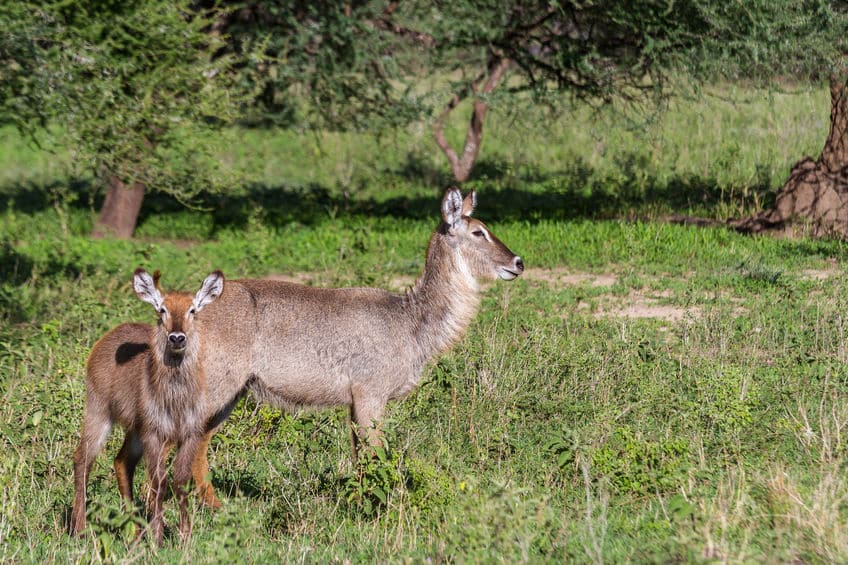
Escapade en Tanzanie : profitez d’un safari
Pour votre escapade dans le nord de la Tanzanie, il est recommandé de faire un safari à Tarangire . Ce genre de voyage et d’évasion satisfait les férus d’aventure et les amoureux de la nature sauvage.
Le parc national de Tarangire est un espace naturel protégé de 2 850 km2 du nord de la Tanzanie. Il est à seulement 3h de l’aéroport du Kilimandjaro. Ce parc est aussi à la lisière de deux espaces naturels bien connus à savoir le parc du Serengeti et la zone de conservation du Ngorongoro.
Un safari à Tarangire peut durer une journée ou une semaine en fonction de votre disponibilité. Laissez-vous accompagner par les guides du parc pour cette aventure au cœur de la nature.
Par ailleurs, un safari au parc national de Tarangire vous permet de voir des troupeaux d’éléphants, des gnous, des girafes, des impalas, des lycaons… La végétation luxuriante, dominée par les baobabs et les acacias, constitue également une attraction d’un genre particulier.
Laisser un commentaire Annuler la réponse
Commentaire
ORGANISEZ VOTRE VOYAGE :
Derniers articles.
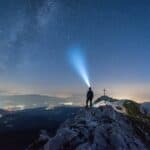
Conseils camping
5 critères pour choisir la lampe de poche ou la lampe frontale de bivouac parfaite.
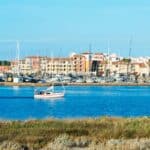
Partir en vacances en camping à Port Leucate : les activités à faire
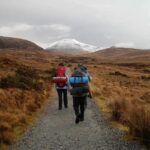
DECOUVERTES
Voyage de découverte : 5 conseils à suivre pour une belle expérience .

Les 10 plus beaux villages blancs de Grenade

Quelle est l’utilité des affiches de voyage décoratives sur le thème de l’Espagne ?
Les 10 plus grands navires de croisière du monde en 2024

Le voyage au bout des papilles

3 jours de safari en Tanzanie : Tarangire, Ngorongoro et Manyara
Qui ne rêve pas de faire un Safari dans sa vie ? Ce moment incroyable où tu es entouré d’éléphants, girafes, zèbres … qui sont dans leur élément naturel. Pour ma part, c’est maintenant chose faite ! Pour ma première expérience, je vous embarque pour 3 jours de safari en Tanzanie ! Au programme : Tarangire, cratère du Ngorongoro et lac Manyara .
Pour planifier ce safari, je sais que vous avez pleins de questions : Quel est le budget pour un safari en Tanzanie? Quel parc visiter? Comment s’habiller ? Combien de jours ? Toutes les réponses sont dans l’article de blog et soyez prêt à en prendre plein les yeuuuux 🐵

Si vous voulez compléter le safari d’un séjour à Zanzibar, je vous partage : les infos pratiques pour votre voyage à Zanzibar , les activités à faire à Zanzibar et mon i tinéraire de 2 semaines à Zanzibar .
Contenu de l'article
Préparer votre voyage Safari en Tanzanie
- Première étape : prendre ton Visa pour te rendre en Tanzanie . Je te conseille le site de VisaMundi pour prendre ton visa : service client en Français, procédure simplifié. Plus facile que se rendre à l’ambassade ou perdre du temps à l’aéroport !
- Réserver ton vol : compare les prix sur Skyscanner (mon site préféré)
- Avoir internet sur place : cette région n’est pas couverte par nos forfaits téléphoniques. Prends une sim sur place ou achete un eSIM pour avoir internet dès ton arrivée (-5% avec mon lien). Pas besoin de retirer ta carte SIM et fini les hors forfaits !
- N’oublies pas de prendre une assurance voyage ! ( -5% grâce à mes liens sur Chapka et GobyAva )
- En Tanzanie, l’ eau n’est pas potable . Alors je vous conseille d’emporter une gourde filtrante pour éviter d’acheter pleins de bouteilles plastiques (pas très écolo). Pour ma part j’ai la gourde filtrante Humagreen et elle est vraiment top ! C’est mon alliée en Tour du monde. D’ailleurs si tu veux l’acheter tu as -15% via le code LILIFOODIESTRAVEL.
Quel budget pour 3 jours de Safari en Tanzanie ?
La 1ère question à se poser pour un safari : mais est-ce que je vais avoir le budget? Car oui, faire un safari veut dire avoir un budget considérable, et en Tanzanie, un safari pas cher cela n’existe pas ! En effet, je souhaite vous alertez sur ce point : si vous trouvez un safari vraiment moins cher, méfiez-vous ! Une agence qui accepte de négocier jusqu’à un tarif très bas, ne coupera JAMAIS sur sa propre marge, mais ils couperont plutôt sur la qualité/sécurité/légalité de votre safari. Si vous voulez plus d’informations sur les coûts réels des Safari , je vous invite à lire ce post du groupe Facebook « Voyageurs en Tanzanie » . D’ailleurs ce groupe est génial pour le partage d’expériences, donc rejoignez-le si vous avez d’autres questions 😊
Globalement le prix de votre safari dépendra : des parcs que vous faites, des logements choisis (tente ou lodge), si vous faites un safari en privée ou « joigned » (avec d’autres personnes) et pour finir, la qualité du guide, des repas et de l’accompagnement . Sachez que vous êtes accompagné durant votre voyage par votre guide, mais aussi d’un cuisinier personnel. Et ca, c’est du luxe qui se rémunère. Pour cela les prix peuvent grandement varier !
Pour se faire une idée : pour 2 nuits et 3 jours, les prix peuvent aller de 600€ à 1 300€ . Par exemple, faire le parc du Serengeti et Ngorongoro revient plus cher car il y les droits d’entrée y sont élevés 💰. Pour notre part, pour le trajet décrit juste après, cela nous a couté environ 800€ avec Fronny Expeditions (prix de 2021).
Quel organisme prendre pour son safari en Tanzanie?
D’ailleurs si vous recherchez un organisme sérieux, avec guide francophone, un super cuistot (il s’est adapté sans soucis à mon régime sans gluten) je vous conseille Fronny Expeditions , ils sont au top . Et ont même organisé d’autres activités pour nous une fois rentrées à Arusha.
3 jours de safari en Tanzanie, est-ce assez ?
Je vous conseillerai 3 ou 4 jours si vous voulez voir l’essentiel pour un budget « raisonnable » . Sachez qu’ un safari est fatiguant : il faut se réveiller tôt et être aux aguets toute la journée . Donc souvent les voyageurs font un safari puis finissent à Zanzibar, pour se reposer au soleil.
Si vous voulez faire le Serengeti, prévoyez 4 jours de safari . En effet le Serengeti est un parc gigantesque avec de longues distances, donc pour bien en profitez et voir les big 5, restez-y 2 jours. Sinon bien sur, certains font des safari de 10 jours, mais il faut être motivé et passionné d’animaux je pense 🦛
Quels parcs visiter en Tanzanie?
La majorité des parcs les plus connus se trouvent dans la région d’Arusha, au nord ouest de la Tanzanie . Vous avez déjà surement entendu parler du Serengenti ou Tarangire? Je vous embarque dans 3 des 4 parcs les plus connus que j’ai fais lors de mon safari de 3 jours avec Fronny Expéditions.
On a commencé par, selon moi, le plus beaux des 3 parcs : il est essentiellement composé de basses collines recouverts de forêts d’ acacias et de baobabs géants . On y trouve un grande quantité d’animaux surtout autour des zones de marais qui alimentent de riches prairies.

A peine rentrée dans le parc (après que le guide ai fait toutes les modalités), on croise des singes , impalas , zèbres , gnous et la notre voiture trace… on voit au loin 7 voitures arrêtées (c’est un bon signe), et la… il y avait : un guépard ! Il est super rare d’en croiser en Safari : il était allongé dans l’herbe. On a attendu plus de 30 min qu’il bouge, on voulait partir et le guide nous a poussé à rester et 5min après on voit sortir 6 guépards, oui oui 6 ! Moment de folie dès le début du safari 😍

On continue la route dans les plaines et autour d’une étendue d’eau pleins de zèbres et gnous. Franchement les voir en liberté c’est tellement beau. Puis durant la journée les paysages défilent , toutes les 30 min notre environnement changeait, ce parc est vraiment gigantesque avec des paysages tellement variés.

Et défilé d’animaux se poursuit : cobe à croissant , dik dik (petite antilope tellement chouuu), autruches , calao rouge , phacochère et les fameuses girafes et éléphants . Nous avons vu des dizaines d’éléphants autour de la rivière Tarangire. A un moment ils entouraient même la voiture.

Pour finir nous avons vu ces petites bêtes sur une termitières (car oui il a beaucoup de termitières dans ce parc, parfois elles font même plusieurs mètres de haut 😱), a votre avis c’est quoi ?

Eh ba, ce sont des écureuils tanzanien s ! Tellement mignon avec leurs petites têtes au dessus de la termitière.
Fin bref, vers 16h30, c’est déjà l’heure du retour vers l’entrée car le parc ferme à 18h . Nous avions 2h de route pour rejoindre notre logement au-dessus du Lac Manyara : le camping de Migombani (je vous en parle juste après).
Cratère du Ngorongoro
A 8h départ du camping direction le cratère du volcan Ngorongoro . Il faut environ 1h de route puis au moins 45min pour descendre dans le cratère et rejoindre les lacs, autour desquels se regroupent les animaux. Sur la descente, la route est en pleine jungle avec une vue de folie sur le cratère. Pour notre part c’était très brumeux, on se serait cru dans Jurassic Parc, ambiance mystique haha

Pour l’histoire : le cratère s’est formé suite de l’ effondrement d’un volcan sur lui-même lors d’une éruption volcanique il y a des milliers d’année. Le Ngorongoro est la plus grande caldeira intacte et non submergée. Elle est située dans l’aire de conservation du Ngorongoro qui est inscrite au patrimoine mondial de l’Unesco .
C’est l’un des parcs à absolument voir lors de votre voyage en Tanzanie , pour sa diversité de paysages (savane, lacs, forêts, collines) et sa faune variée. On peut y croiser quasiment toute la faune sauvage de Tanzanie !

Pour notre part nous avons eu la chance de voir une faune tellement variée : pleins de gnous , zèbres , buffles , gazelles (de grant et thompson), autruches , phacochère . Mais aussi des chacals , renards , hippopotames (au bord du lac où on a déjeuné), une hyène et quelques éléphants au loin.

Pour finir beaucoup d’oiseaux : grues royales, flamands roses, oies, iris, héron cendré, faucon, cigogne et un outarde (style d’échassier).

Franchement ce parc a été plein de découvertes , j’ai vu des animaux que je n’avais jamais vu de ma vie ! Et ce qui est beaux, c’est qu’ils vivent tous en parfaite harmonie dans le parc.
Lac Manyara
Départ pour le 3ème parc national juste en bas de notre camp site : le lac Manyara, pour une visite d’une matinée (environ 4h) . En effet ce parc est assez petit et la visite se fait rapidement .
Les itinéraires au sein du parc du lac Manyara permettent de découvrir un microcosme représentatif de la Tanzanie. Les routes serpentent sur de longues bandes de terre entre le lac et la falaise. Elles traversent une jungle luxuriante où l’on passe régulièrement à coté de jolis cours d’eau.

On y a croisé au début de notre visite de nombreux babouins , singes mais aussi un aigle.

Puis on passe dans un décor plus sec , avec des acacias et animaux plus de la faune sauvage : girafes, zèbres, guib harnaché (antilope de taille moyenne), dik dik, impala, phacochères, un buffle mais aussi un faucon, calao, aigrettes. Puis sur le chemin du retour on a croisé 2 éléphants !

Globalement moins d’animaux que dans les autres parcs car beaucoup ont malheureusement fuit… nous étions fin juin, à la sortie de la période des pluie et l’ eau du lac avait beaucoup montée . Certaines routes n’étaient plus accessibles et des espèces avaient fuit.

Mon constat sur ce parc est mitigé : de beaux paysages mais rapide à faire et peu d’espèces qui changent des autres parcs. Donc si vous avez le temps faites-le, mais sinon il est n’est pas obligatoire.
Qu’en est-il des fameux lions de Manyara que l’on voit perchés sur des arbres sur toutes les affiches ? Eh ba c’est devenu un mythe ! Ce genre de scène est devenue très rare selon notre guide. Et d’ailleurs… on a croisé aucun lion dans ce parc. Après 2 jours sans lion, finalement on fini sur une déception lion (pour ma part). C’était mon rêve et on en a croisé dans aucun parc : pas les bons timings je suppose… je reviendrais donc ! Impossible de rester sur ca. Mais en dehors de cela, on a vu tellement d’autres animaux que c’était fou !

Mon itinéraire idéal pour 4 jours de safari en Tanzanie
Et le fameux Serengeti dans tout ca ? Car oui nous ne l’avons pas fait, par manque de budget et de temps. La guide nous a plutôt proposé de faire les parcs mentionnés ci-dessus pour 3 jours. Mais selon moi, si vous êtes en Tanzanie, le Serengeti est un must do ! Après coup, je suis dégoutée de ne pas l’avoir fait… car là-bas on voit vraiment des paysages encore différents et on a plus de chance de voir des scènes sauvages avec des lions, léopards… Ce que je n’ai pas vu dans les autres parcs. Donc à mon avis si vous avez le temps et l’argent, foncez voir aussi le Serengeti !
Voici ce que je vous recommanderais si vous voulez faire 4 jours de safari en Tanzanie:
- 1 jour Tarangire
- 1 jour Ngorongoro
- 2 jours Serengeti
Comment s’habiller pour un safari en Tanzanie?
La clé en safari, c’est les couches . Le matin il fait souvent frais , et l’ après-midi cela se réchauffe .
- Tarangire : prévoyez une tenue qui n’est pas noire ou bleu foncé car il a beaucoup de mouches tsé tsé. Elles aiment beaucoup ce genre de couleurs foncés et piquent dans la voiture. Mettez pour ce parc plutôt un pantalon ample, un tee shirt et des chaussures fermées pour éviter de trop vous faire piquer, et dans des couleurs neutres.
- Ngorongoro : on a eu super froid (on était pas prête lol) ! Descendues dans le cratère c’était encore pire, donc clairement prévoyez une double polaire pour le matin avec un foulard , que vous enlèverez au cours de la journée. Mais sinon pas de mouches tsé tsé ici, donc niveau couleurs, pas de restrictions spécifiques .
- Lac Manyara : pour les mouches tsé tsé, idem ici, il n’y en a pas. Nous avons eu de la chance pour le Lac Manyara, le temps était plus avec nous et il a fait bon toute la journée. J’ai donc sortie la combi short beige, style safari. Pour ce parc, mettez la tenue que vous souhaitez selon le temps du jour .

Globalement, les essentiels à prévoir :
- Une grosse polaire (mes préférées, celles Décathlon )
- Une écharpe
- Tee-shirt et pantalons de couleurs « neutres »
- Short (si la météo le permet, selon le parc)
- Lunette de soleil
En complément prenez du stick à lèvre et de la crème solaire (la gamme d’ Acorelle est top : éco-responsable et naturelle) , car le temps est sec et quand il y a du soleil cela peut taper, même si vous restez dans la voiture.
Où dormir en safari en Tanzanie?
Nous avons passé 2 nuits dans le Migombani campsite au nord du lac Manyara . C’est un emplacement idéal entres les 3 parcs que l’on a visité. De plus il bénéficie de prestations de qualité : vue sur le lac, piscine, petit restau/bar par cher, des tentes avec lits confortables, des douches (avec de l’eau chaude ! le luxe !), des sanitaires propres et un petit feu de bois le soir.

Ambiance cosy et service très agréable. Le soir nous dinions sur les tables de pic nic avec les repas préparés par notre cuisinier, un vrai délice.
A savoir pour ton safari de 3 jours en Tanzanie
- Si vous prenez l’option camping dans les parc : préparez-vous à ne pas avoir d’eau chaude pour vos douches (sauf camping premium) et d’avoir des nuits mouvementés avec des bruits d’animaux. Eh oui, c’est ça l’aventure !
- Se lever tôt est la clé si vous voulez voir un max d’animaux . Vous êtes pas la pour la grasse mat !
- Pensez à prendre un produit anti-moustiques tropicaux pour le soir. Perso, j’ai pris ceux de la marque Insect Ecran qui ont vraiment bien fonctionnés.
- Il y a souvent des prises électriques dans les voitures du safari (nous c’était le cas) et c’est la vie : recharger vos téléphones, batterie d’appareil photo etc.
Les drones sont-ils autorisés en Safari en Tanzanie?
Alors ! C’est une vraie question que se pose la team des droners. Officiellement, ils sont interdit dans les parcs nationaux . Après, je n’ai eu aucun contrôle à l’arrivée dans les parcs et les guides m’ont dit en avoir déjà vu voler. Il est interdit de filmer à but commercial sans autorisation, mais après à voir si cela est possible dans votre but personnel?
De mon coté, j’avais envie de profiter à fond du safari donc pas le temps de sortir le drone. Mais je pense que c’est possible dans les grands espaces, à vos risques et périls et à demander à l’avance à votre guide s’il pense que cela passera. Dans tous les cas, si vous le faites, l’idée est de le faire loin des animaux pour ne pas les perturber et préserver leur environnement.
En tout cas j’espère vous avoir donné envie de partir faire un safari en Tanzanie grâce à mon article et que mon avis sur ce safari de 3 jours vous a été utile ! C’est une expérience de folie où l’on découvre tellement de paysages et d’animaux. J’en garde des pépites dans les yeux 😍
Si vous avez des questions, hésitez pas à les mettre en commentaire ou venir me parler directement sur Instagram . Il y a aussi toutes mes stories à la une du safari à revoir 📷
Pour approfondir votre séjour en Tanzanie, ne manquez pas l’expérience d’une visite de ferme à café à Arusha .
Et si vous voulez aller vous reposer sur Zanzibar après votre safari, retrouvez :
- Des infos pratiques pour votre voyage à Zanzibar
- Les activités à faire sur Zanzibar
- Mes bonnes adresses et mon itinéraire de 2 semaines .
Economisez sur votre voyage EN TANZANIE
🏠 Trouvez un hébergement au meilleur prix ici
⚕️5% sur votre assurance voyage Ici
✈️ Cashback : 7€ offerts à l’inscription à Igraal avec mon lien
🚠Pour réserver vos activités et excursions Ici
✈️ Comparez et trouver des vols pas cher ici
🚆Comparer et trouver des billets de bateaux/bus ici
🚗 Louez votre voiture avec les meilleures offres ici
💳Profite d’une carte bancaire sans frais à l’international et gratuite ici
📱5% de réduction sur votre e SIM Holafly ici
🎒-15% sur la gourde filtrante Humagreen ici avec le code LILIFOODIESTRAVEL
💸 Découvre mon Ebook avec plus de 150 astuces pour économiser des centaines d’euros sur tes prochains voyages à seulement 19,90€
PS : certains de ces liens sont des liens affiliés. Pour vous cela ne change rien, mais moi je touche une petite commission si vous réservez via ces liens. Cela m’aide à entretenir le blog et continuer à vous partager plus d’astuces, donc merci ❤️
Pour retrouver d’autres idées de week-ends et voyages rdv dans les destinations sur le blog ✈️
Découvre plus de bons plans et astuces sur mon blog !
Articles similaires
Partager via :
- X (Twitter)

10 commentaires
EspritGlobeTrotteuse
Coucou Aurélie, Quel magnifique article ! Tu m’as fait revivre mon safari en Namibie que j’ai tant aimé et que j’aimerai reproduire ailleurs. Mais comme tu dis, cela a un coût. Mais il faut savoir ce que l’on veut. Le beau est souvent cher.
Lilifoodiestravel
Coucou ! Oh ravie qu’il t’ai plu. C’est vraiment que la Namibie a l’air aussi génial pour un safari, j’aimerai beaucoup y aller. Mais plus tard du coup car c’est un sacré coût un effet 😜
Bonjour Aurélie, Ton article m’a fait rêver, depuis le temps que je veux faire un safari ! (et voir des lions, je suis déçue pour toi d’ailleurs…!) Mais j’ai d’abord découvert ton blog grâce aux recettes adaptées aux divers tracas intestinaux que l’on peut avoir… et je te pose donc la question qui m’a toujours freinée : comment as-tu géré ça en safari ? J’avoue que gérer les symptômes, la nourriture qu’on ne maîtrise pas etc, m’ont toujours fait peur pour partir…
Hello Mathilde, Oh trop bien, du coup tu vas aller le faire ce safari ? Et pour le coup j’ai prévenu à l’avance Fronny expeditions, mon organisme, ils ont été au top pour moi. Tout à été fait via le la farine de manioc et au petit dej j’avais même des crèpes sans gluten. Vu tout que toute la nourriture était préparé par le chef qui nous suivait tout était personnalisé donc pas de tracas pour moi, c’était un stresse en moins 😀
Oui, j’ai des contraintes jusqu’à la fin de l’année, mais normalement en 2023 c’est bon ! Plus qu’à déterminer le meilleur moment pour partir pour être sûre de voir un max d’animaux 🙂 Merci pour ta réponse, c’est rassurant de savoir que c’est possible ! Je n’ai pas encore choisi d’organisme de voyage, mais s’assurer qu’ils peuvent s’adapter à mon SII sera donc en tête des critères de choix. Bon tour du monde 😉
Oh super ben je te souhaite d’avance un super voyage, je suis sûre que ça pourra être que bien ! Et oui demande leur a l’avance s’ils peuvent te faire des repas sur mesure, si non, next haha
Tu as des commentaires ? Questions ? Hésite pas à les poser ici :) Annuler la réponse.
- More Networks

IMAGES
VIDEO
COMMENTS
Below are 10 of the best Tarangire safari lodges and camps. The accommodations below are not ranked in a specific quality order. 2,506 Tarangire Safaris. 1. Lake Burunge Tented Lodge. Comfortable, good value and scenically located, Lake Burunge Tented Lodge is an excellent base for a safari in Tarangire National Park.
USD $53 per adult to enter the conservation area. USD $18 per child (aged 5 - 16) The main access gates open at 6.30am and close at 6.30pm. Carrying a small amount of Tanzanian currency, the Tanzania Shilling (TZS) is recommended as back-up when paying for items where credit card facilities are unavailable.
The cost of a safari in Tarangire National Park will vary depending on your itinerary. For a budget safari, you can expect to pay around $150 per person per day. On the other hand, for a more premium experience, you will find safaris for over $1,000 per person per day. A mid-range Safari Tarangire option falls somewhere in between at around ...
Tarangire is located in northern Tanzania. It is part of the country's northern safari circuit which also includes Lake Manyara, Ngorongoro, and the Serengeti. Tarangire is approximately 70 miles (110 km) from Lake Manyara National Park, 90 miles (140 km) from Ngorongoro Conservation Area, and 120 miles (200 km) from Serengeti National Park.
The Tarangire National Park, located in northern Tanzania, offers a variety of amenities to let guests have an once-in-a-lifetime safari experience. The drive to Tarangire national Park from Arusha city takes roughly two to three hours. This Tanzanian national park's northern region is home to the Tarangire River.
Established in 1970, Tarangire National Park and Safari is the sixth largest national park in the country, covering 2850 square kilometers. The name which means "river of warthogs" originates from the Tarangire River, the primary source of water in the park. Tarangire Ecosystem is part of the East African Rift Valley that contains Lake ...
Power is available in the rooms from 6 a.m. to 10 a.m. and 6 p.m. to 11 p.m. 3. Tarangire Simba Lodge. This gem is on the northern safari circuit and is any safari-goers dream. The Tarangire Simba Lodge is surrounded by a wide variety of wildlife, an ancient Baobab tree and has magnificent views of Lake Burunge.
Open Map. Best Time To Go July to November (Animals come to the Tarangire River) High Season June to October (The park is full of visitors) Size 2,850km² / 1,100mi². Altitude 985-1,528m / 3,232-5,013ft.
Tarangire Safari Lodge in Tarangire National Park, Tanzania: View Tripadvisor's 1,263 unbiased reviews, 1,427 photos, and special offers for Tarangire Safari Lodge, #17 out of 42 Tarangire National Park specialty lodging. ... We stayed in the double safari tent equipped with en-suite bathroom and solar-heated shower. The thick canvas walls with ...
Situated in Tanzania's Manyara Region, just southeast of Lake Manyara National Park, Tarangire is just over 100km from the city of Arusha. This makes it easily accessible for travellers en route to the Serengeti National Park and Ngorongoro Conservation Area, situated further west. The national park extends over 2,850km 2 (280,500 hectares ...
A Tarangire national park walking safari is one of the best and most rewarding Tarangire national park safari activities that travelers can enjoy while on Tarangire national park safaris all throughout the year. Track the huge and deep footprints of elephants in Tarangire national Park, famous for the huge herds of elephants seen freely ranging ...
The quintessential safari tents, with thatched roofs and large, mesh-screened windows, provide the perfect opportunity to connect with the sights and sounds of nature. ... or triple bungalows; all are equipped with en-suite bathrooms with solar-heated showers, ample cupboard space for your gear, and a cultural touch of local textiles. Our ...
Vous êtes sûrs de profiter d'un safari en toute tranquillité. Comptez au minimum 3 jours pour un safari dans le Parc National de Tarangire, répartis entre le Nord puis le Centre et le Sud du parc, beaucoup moins fréquentés. Des safaris nocturnes et des safaris à pieds sont aussi organisés à Tarangire par les lodges et les camps de toile.
Moshi, Lac Manyara, Zone de conservation du Ngorongoro, Parc national du Tarangire +2 de plus Tranche d'âge De 5 à 100 ans Régions Parc national du Tarangire, Circuit nord de la Tanzanie +1 de plus Langue Uniquement en : Anglais Voyagiste Kilimanjaro Wonders Expedition Safari
We offer walking tours inside Tarangire at $45 per person for 3-4 hours or at $60 per person for 5-6 hours walking tour. Balloon Safari also takes place in Tarangire. It starts early in the morning around sunrise. The aerial perspective from the balloon gives you stunning views of the topographies of the park.
Les frais d'entrée pour le parc de Tarangire sont de 45€ par jour pour un adulte, et de 15 € par jour par enfant. L'entrée est gratuite pour les moins de 5 ans. Retrouvez ici nos conseils pour un safari inoubliable dans le Parc National de Tarangire, le paradis des éléphants en Tanzanie ! 🐘☀️.
Le parc de Tarangire Le Parc national de Tarangire s'étire tout en longueur le long de la rivière dont il tire son nom. Principalement constitué de collines plantées de buissons, acacias et baobabs (les seuls des parcs du Nord de la Tanzanie !), il offre aussi d'immenses zones de marais qui restent verdoyantes toute l'année et même une plaine surnommée « le petit Serengeti ».
Parc National de Tarangire - Safari en Tanzanie #1. Après l'article de présentation de notre circuit en Tanzanie, voici le récit de notre premier jour de safari de notre voyage de noces : le parc Tarangire ! Comme vous avez pu le voir, nous avons divisé notre safari en trois parties puisque nous avons visité trois parcs : Parc ...
The entrance to Tarangire National Park is about two hours drive from Arusha in North Tanzania. Dar es Salaam is the best option for flying into Tanzania.
Ressources Safari en Tanzanie. Du Parc National du Serengeti au Cratère du Ngorongoro, du Parc de Tarangire au Lac Natron, partez à la découverte des plus beaux Parcs nationaux en Safari en Tanzanie. Observez la grande migration, partez à l'ascension du Kilimandjaro puis reposez vous sur les plus belles plages de l'île de Zanzibar !
Un safari à Tarangire peut durer une journée ou une semaine en fonction de votre disponibilité. Laissez-vous accompagner par les guides du parc pour cette aventure au cœur de la nature. Par ailleurs, un safari au parc national de Tarangire vous permet de voir des troupeaux d'éléphants, des gnous, des girafes, des impalas, des lycaons…
Qui ne rêve pas de faire un Safari dans sa vie ? Ce moment incroyable où tu es entouré d'éléphants, girafes, zèbres… qui sont dans leur élément naturel.Pour ma part, c'est maintenant chose faite ! Pour ma première expérience, je vous embarque pour 3 jours de safari en Tanzanie !Au programme : Tarangire, cratère du Ngorongoro et lac Manyara.
Yo ! On continue ce voyage en Tanzanie avec mon safari : au programme, 4 jours entre les parcs nationaux du Tarangire, du Serengeti et du cratère du Ngorongo...
Tanzania Safari Tours: Discover the Wonders of Lake Manyara National Park Welcome to Tanzania, a land of breathtaking natural beauty and diverse wildlife. If you're looking for an unforgettable adventure, look no further than Tanzania safari tours. One of the must-visit destinations in Tanzania is Lake Manyara National Park, a gem that ...